- International edition
- Australia edition
- Europe edition

Tour de France: Gall grinds to stage 17 win as Vingegaard opens up gulf at top – as it happened
Felix Gall won a brutal Queen Stage, while any faint hopes Tadej Pogacar might have had of catching Jonas Vingegaard were completely obliterated
- Read Jeremy Whittle’s stage 17 report from Courchevel
- 19 Jul 2023 Gall wins stage, while Vingegaard all but wins Tour
- 19 Jul 2023 The top five on General Classification
- 19 Jul 2023 The top three on stage 17
- 19 Jul 2023 Felix Gall wins stage 17!
- 19 Jul 2023 Pogacar: "I'm gone, I'm dead"
- 19 Jul 2023 Tadej Pogacar is in big trouble ...
- 19 Jul 2023 Tadej Pogacar crashes ...
- 19 Jul 2023 The peloton is racing on stage 17 ...
- 19 Jul 2023 Today's roll-out has begun
- 19 Jul 2023 Who's wearing what jersey
- 19 Jul 2023 Vingegaard leaves rivals trailing in his wake
- 19 Jul 2023 The top 10 on General Classification
- 19 Jul 2023 Stage 17: Saint-Gervais Mont-Blanc to Courchevel (165.7km)
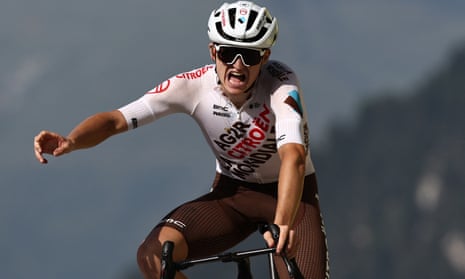
35km to go: Bora-Hansgrohe rider Nils Politt takes up the cudgels at the front of the yellow jersey group, his team getting anxious that Jai Hindley’s fifth place on the GC is coming under threat. Simon Yates, Pello Bilbao, D**** G**** and Felix Gall are all in the top 10 but behind Jai Hindlay. Guillaume Martin, who is 11th on GC, is also in the lead group.
44km to go: The terrain flattens out … a bit, with 16 kilomtres to go until the official beginning of the final climb of the day. Marc Soler is at the front of the lead bunch. A few of those at the back are struggling to keep up. Egan Bernal has lost over two minutes on the yellow jersey group since crashing.
45km to go: “Why would you put a banner marking the top of a climb below the top of the climb?” asks Ben Bull. “That’s just cruel. It reminds me of the many false summits I rolled over on the Cabot Trail in Canada, wobbling my bike from side to side, clutching my chest. There is surely no darker feeling in the world than reaching a ‘summit’ only to see another summit dead ahead.”
49km to go: Bernal has lost over 90 seconds on the yellow jersey group and after his fall, is travelling down the descent with extreme caution. The road is narrow, tight and twisty, with low concrete walls on some of the corners.
52km to go: In the yellow jersey group, Egan Bernal (Ineos Grenadiers) loses his front wheel at the first of them and hits the deck. He’s OK to remount and continue.
54km to go: The lead group beging their descent begins and it’s a long, steep one with over 20 hairpin bends.
55km to go: Great news. I can confirm categorically that David Gaudu is in the lead bunch, as Thibaut Pinot has just escorted him to the front of it. Now let’s never speak of him again unless he actually goes on to contest the end of the stage. The riders are still ascending, despite having passed the banner marking the top of the third climb. Ineos Grenadiers have taken over at the front of the yellow jersey group.
60km to go: “Gaudu moves in mysterious ways,” writes Bruno Rabl. Wearing a polka-dot helmet, shirt, shorts and socks, Giulio Ciccone crests the summit of the third climb of the day unopposed to take maximum points for the third time today. He could still lose the jersey if Jonas Vingegaard is first over the top of the last climb of the day and he doesn’t collect any more points today. Were that to happen, there are a sufficient number of climbs left on the Tour for him to win it back.
😍😍😍 #TDF2023 pic.twitter.com/C3TLjf8ACX — Tour de France™ (@LeTour) July 19, 2023
63km to go: Halfway up the Côte de Longefoy, our group of leaders have dropped Julian Alaphilippe and are almost three minutes clear of the yellow jersey group.
Your leaders: Jack Haig (Bahrain Victorious), Giulio Ciccone and Mattias Skjelmose (Lidl-Trek), Ben O’Connor (Ag2r-Citröen), Kevin Vermaerke (DSM-Firmenich), Gregor Mühlberger (Movistar), Krists Neilands (Israel-PremierTech), Chris Harper (Jayco-AlUla), Stefan Kung, Valentin Madouas and Thibaut Pinot (Groupama-FDJ), Magnus Cort and Rigoberto Uran (EF Education-EasyPost), Dries Devenyns (Soudal-Quick Step), Pello Bilbao (Bahrain Victorious), Felix Gall (Ag2r) and Simon Yates (Jayco-AlUla).
Bizarrely, debate continues to rage over whether David Gaudu (Groupama-FDJ) is in this group or not. The current thinking is that he definitely is and the Tour’s rider tracking gizmo appears to back that up.
Côte de Longefoy is the 3rd iconic segment during this stage: https://t.co/wxOMB06cTS pic.twitter.com/LNSkBRDL34 — Strava (@Strava) July 19, 2023
69km to go: The leaders are approaching the foot of the day’s penultimate climb, a comparative hillock compared to the monster lying in wait later. The category two Côte de Longefoy is 1,174m high and 6.7 kilometres in length with an average gradient of 7.5%. Easy!
Schrödinger’s Gaudu: “David Gaudu seems to be the Tour’s most elusive rider,” writes Chris Taine. “He’s in a group until you look for him in a group, at which point he’s not in that group. Or not not in that group. Meow.”
We are all, in our own way, waiting for Gaudu.
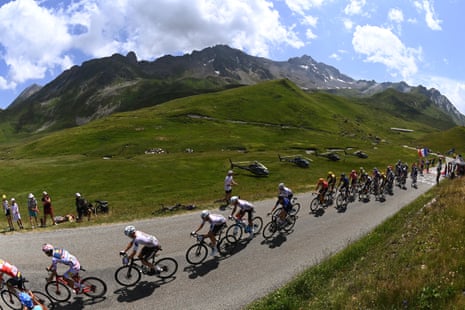
72km to go: “Much has been written about Vingegaard’s performance yesterday but it’s worth noting that he gained a substantial amount of time on the downhill sections,” writes Michael Forbes. “Cycling isn’t only about climbing but also about descending. Frankly, I’d rather investigate how he stayed on the bike around some of those corners!”
76km to go: Withg two of today’s four climbs behind them, the lead group of 33 riders has a lead of 2min 10sec over the yellow jersey group, which is 35-riders strong. THere’s another group of around 20 riders between them and the green jersey group, which is nine minutes behind the leaders.
82km to go: While we’re on the subject, the Irish journalist Paul Kimmage posted a tweet today, showing what I presume is a genuione page from today’s L’Equipe in which they had a photo of Vingegaard accompanied by the headline “D’une Autre Planete”. They have used that headline in the past, accompanying a story aboout … Lance Armstrong.
I always had my doubts about Lance and often got woeful abuse from his fans for expressing my cynicism. I really want to believe today’s best riders are on the level but also think it’s fair to ask questions in the face of some almost superhuman performances.
As my old friend David Walsh once said: “We reserve the right to applaud.” pic.twitter.com/dJjneLmcvA — Paul Kimmage (@PaulKimmage) July 19, 2023
An email: With the riders on a long descent it’s time to dip into the mailbag. “Very sad and a bit confusing to see so much on social media about Vingegaard’s amazing performance yesterday – particularly from fans of Pogacar?” writes Jeremy.
“Both are great riders and both seem to have the utmost respect for each other – shame the same can’t be said of some of Pogi’s fans who have thrown the doping card into what should merely be a discussion of which planet Vingegaard actually hails from!
“I think they are both a credit to modern day cycling - mind you, I have just discovered he is a big Liverpool fan - which I think does need some explanation in my book.”
It’s an interesting email but while there isn’t a shred of evidence to suggest that Vingegaard has done anything dodgy, I think that given the sport’s extremely murky past, there are legitimate questions to be asked about his performances. Yesterday’s was out of this world.
Vingegaard himself has welcomed questions from sceptics and this very subject was addressed on Eurosport’s pre-stage coverage this morning.
All concerned arrived at what I think is the fair conclusion that, until we see any evidence that Vingegaard (or indeed Pogacar) might be cheating in some way, we have to presume they are not. Other opinions are available.
King of the Mountains: Giulio Ciccone is now on 83 points, with Neilson Powless next in the pecking order on 58. Jonas Vingegaard is one behind the American in third.
In the entirely plausible scenario that Ciccone doesn’t take any points on today’s final climb and Vingegaard is first to the summit of the Col de la Loze, it is the Dane who will be top of the King of the Mountains standings at close of play this afternoon. Ciccone would continue to wear the polka-dot jersey, but only on Vingegaard’s behalf.
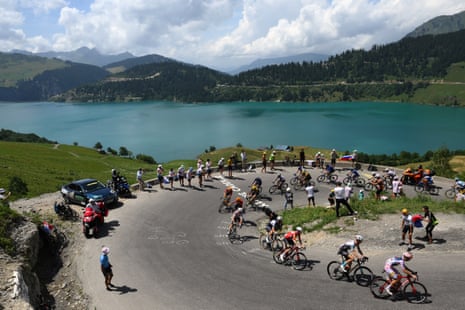
97km to go: In the polka-dot jersey, Giulio Ciccone is first over the Cormet de Roselend, followed by his teammate Mattias Skjelmose. I can confirm that David Gaudu is not in the lead group.
102km to go: We have three riders from the top 10 on GC in the lead group, the highest placed being Pello Bilbao, in seventh. Simon Yates (eighth) and Felix Gall (tenth). David Gaudu seems to have been vanished off the face of the earth, as there’s no sign of him in any of the first three groups. He’s definitely in one of them and I’m pretty sure it’s that of the leaders, which would make it four from the top 10.
105km to go: “What the heck happened to Neilson Powless!?” asks Joe Pearson. “A couple days ago he was in polka dot; today he’s in the Green Jersey group, over six minutes back. Is he ill or injured? Do we know?”
We can’t know for sure Joe, but he tried to escape early on in a group with Giulio Ciccone, who relieved him of his KOM jersey two days ago, but just didn’t seem to have the legs. He started going backwards very quickly at the first application of pressure. Probably just one of those bad days at the office.
106km to go: With a shimmering, emerald green lake to their right and slightly darker green mountains to their left and straight ahead, the riders continue their journey towards the summit of the Cormet de Roselend. The lead group is comprised of 34 riders, who have put 1min 23sec into the yellow jersey group behind them. The climb is about to ramp up quite viciously.
108km to go: The German Bahrain Victorious sprinter Phil Bauhaus has abandoned the race after being distanced at the back of the field. He cut an extremely forlorn figure while riding through the intermediate sprint zone all by himself.
An email: “I’ve been following the Tour for years now and I can’t ever remember hearing the phrase Queen Stage,” writes Lizzi. “What does it mean?” The Queen Stage is the toughest, most gruelling mountain stage of any Grand Tour.
109km to go: There’s another 10 kilometres to go up the second climb of the day with the gap from the leaders to the yellow jersey group at 1min 10sec. The green jersey group is currently toiling almost six minutes off the pace.
110km to go: Correction, there are way, way more than 12 riders in the yellow jersey group. Jumbo-Visma have six riders at the front, with the riders of UAE Team Emirates behind them and the lads from Ineos Grenadiers next in line. Christophe Laporte is towing them up the mountain, making a punishing pace.
113km to go: The two lead groups have come together to form one big 33-rider festival of pain. The 12-man yellow jersey group is only 1min 19sec back.
114km to go: Your chase group: David Gaudu, Stefan Kung, Valentin Madouas and Thibaut Pinot (Groupama-FDJ), Magnus Cort and Rigoberto Uran (EF Education-EasyPost), Dries Devenyns (Soudal-Quick Step), Pello Bilbao (Bahrain Victorious), Felix Gall (Ag2r) and Simon Yates (Jayco-AlUla). My humble apologies go out to David Gaudu, who I erroneously reported had been dropped. They have 14.5km of the second climb remaining.
115km to go: We have a lead group of nine readers who have opened a gap of 1min 10sec on the yellow jersey group, with a chase group in between.
Your leaders: Julian Alaphilippe (Soudal-Quick Step), Jack Haig (Bahrain Victorious), Giulio Ciccone and Mattias Skjelmose (Lidl-Trek), Ben O’Connor (Ag2r-Citröen), Kevin Vermaerke (DSM-Firmenich), Gregor Mühlberger (Movistar), Krists Neilands (Israel-PremierTech), Chris Harper (Jayco-AlUla).
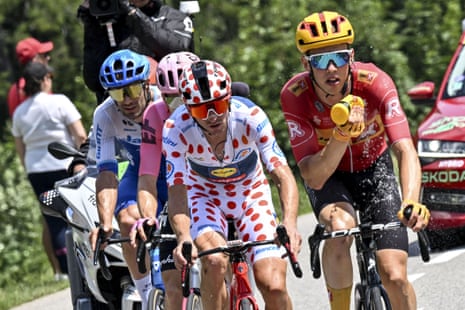
Intermediate sprint: It went uncontested in the valley between the first two climbs and Julian Alaphilippe took maximum points, for all the good they are to him. Assuming he finishes the race, Jasper Philipsen won’t be caught in the points classification. Alaphilippe does, however, also win €1,500 for the team kitty, which will pay for a few righteous beers in Paris on Sunday night. Probably not too many, given how expensive everything is around the Champs Elysees.
- Tour de France 2023
- Tour de France
Most viewed
- Spring Classics
News Round-up: Tour de France Queen stage delivers blockbuster action in the Alps
The final week of the Tour de France started in explosive fashion with one of the most memorable time trial performances in recent memory. There was no time for the cycling world to catch its breath as the race quickly moved onto the Queen Stage and a brutal day with over 5000m of climbing. Could Tadej Pogačar strike back? In other news, Australia has revealed its World Championships squad, an event Kristen Faulkner is now going to miss due to further health complications, plus further updates from the Tour de France.
Tom Hallam-Gravells
Online production editor.
- Share on Facebook
- Share on Twitter
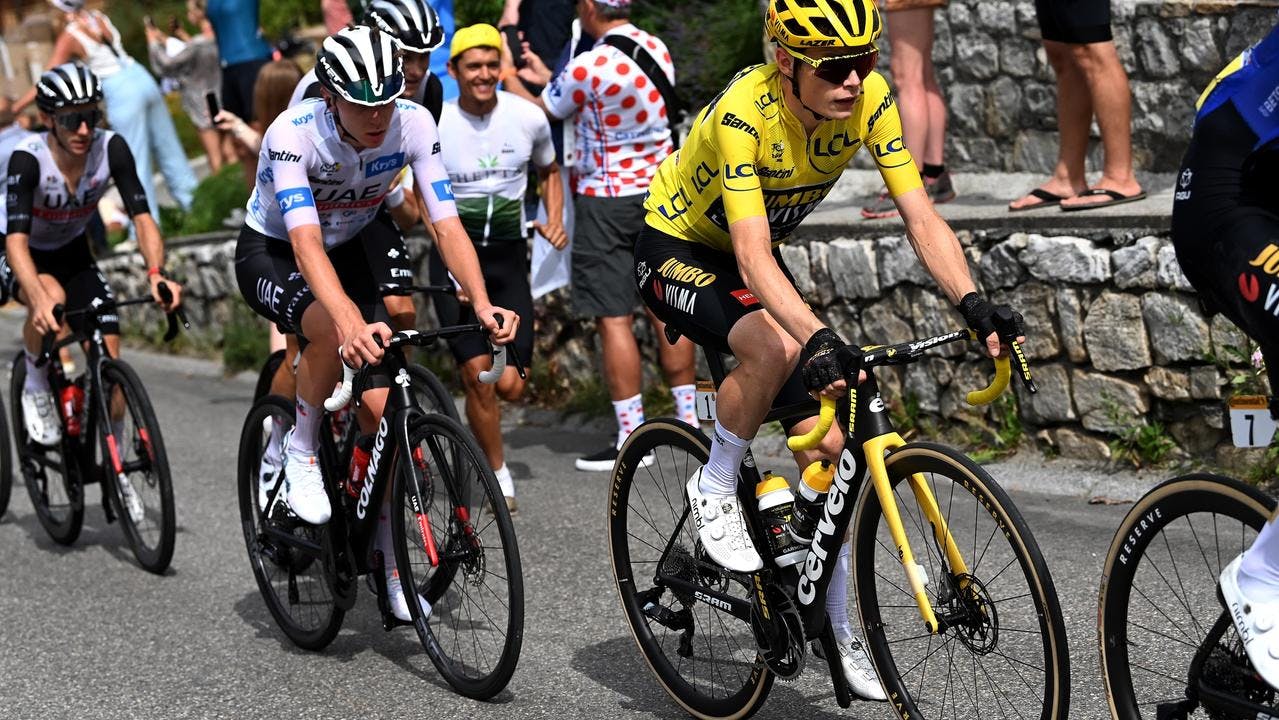
© Velo Collection (TDW) / Getty Images
It was a defining day at the Tour de France.
| Felix Gall conquers Tour de France Queen stage as Tadej Pogačar cracks
On a day that promised big GC shake-ups, stage 17 certainly delivered as Felix Gall ( AG2R Citroën ) took a stage victory that pushed him up the overall standings, whilst behind Jonas Vingegaard ( Jumbo-Visma ) added more than five minutes to his yellow jersey lead.
The big moment of the day came early on the final climb when Tadej Pogačar (UAE Team Emirates) dropped out of the yellow jersey group with more than 15km still to race, eventually losing 5:45 to Vingegaard by the time he finally arrived at the finish.
Dropping Pogačar was not sufficient for Vingegaard, who attacked the rest of his GC rivals on the climb to go past the remnants of the day’s breakaway, and finish fourth on the stage.
He couldn’t catch all of the breakaway riders, though, and it was Gall who took the win ahead of fellow escapees Simon Yates (Jayco AlUla) and Pello Bilbao (Bahrain Victorious).

© Velo Collection (David Ramos) / Getty Images
Felix Gall claimed his first Grand Tour stage win.
“This whole year has been incredible, and now to do so well in the Tour de France, to win the Queen stage, it’s incredible,” Gall said at the finish, now sitting at eighth overall. “I just want to say thank you to the team. They have given me so much.
“It’s not easy to do a three-week stage race, and I have the role of the leader now after a few days, so we slowly focused on that and I was stressing myself a lot about that also. It’s not easy, but the last few days I have been more and more comfortable. I was just afraid that I would be caught in the last kilometres or the last descent.“
Gall attacked 6km from the summit of the final Col de la Loze climb, cresting the top alone, with 20 seconds to defend from Yates on the 6km descent towards the finish.
Despite the small gap, the Austrian rider descended skillfully and held on on the final ramp to take victory, his first in a Grand Tour and with enough of a time gap to move up to eighth on GC. Yates finished second, with Bilbao in third whilst Vingegaard overtook the rest of the breakaway riders to finish fourth. Yates also benefited on the GC, moving up to fifth.
| Tadej Pogačar: “I’m gone, I’m dead”
With only one mountain test remaining and a mighty 7:35 buffer, Jonas Vingegaard (Jumbo-Visma) now appears to have secured another Tour de France title barring any disaster.
The final week didn’t start so comfortably. Two days ago Tadej Pogačar ( UAE Team Emirates ) was only 11 seconds behind, ready to mount an assault on the lead.
His hopes were dealt a hammer blow on stage 16, the only time trial of the race, where he shipped over 1:38 to Vingegaard.
Despite the major setback, the Slovenian was adamant after the stage that the final nail hadn’t been hammered into his coffin, vowing to come out swinging on today’s epic over the Col de la Loze.
“It’s definitely not over,” Pogačar said.
Any hopes of a fight back quickly unravelled on the final climb today when Pogačar’s voice uttered four haunting words across the UAE Team Emirates in-race radio, shared across the live coverage: “I’m gone, I’m dead.”
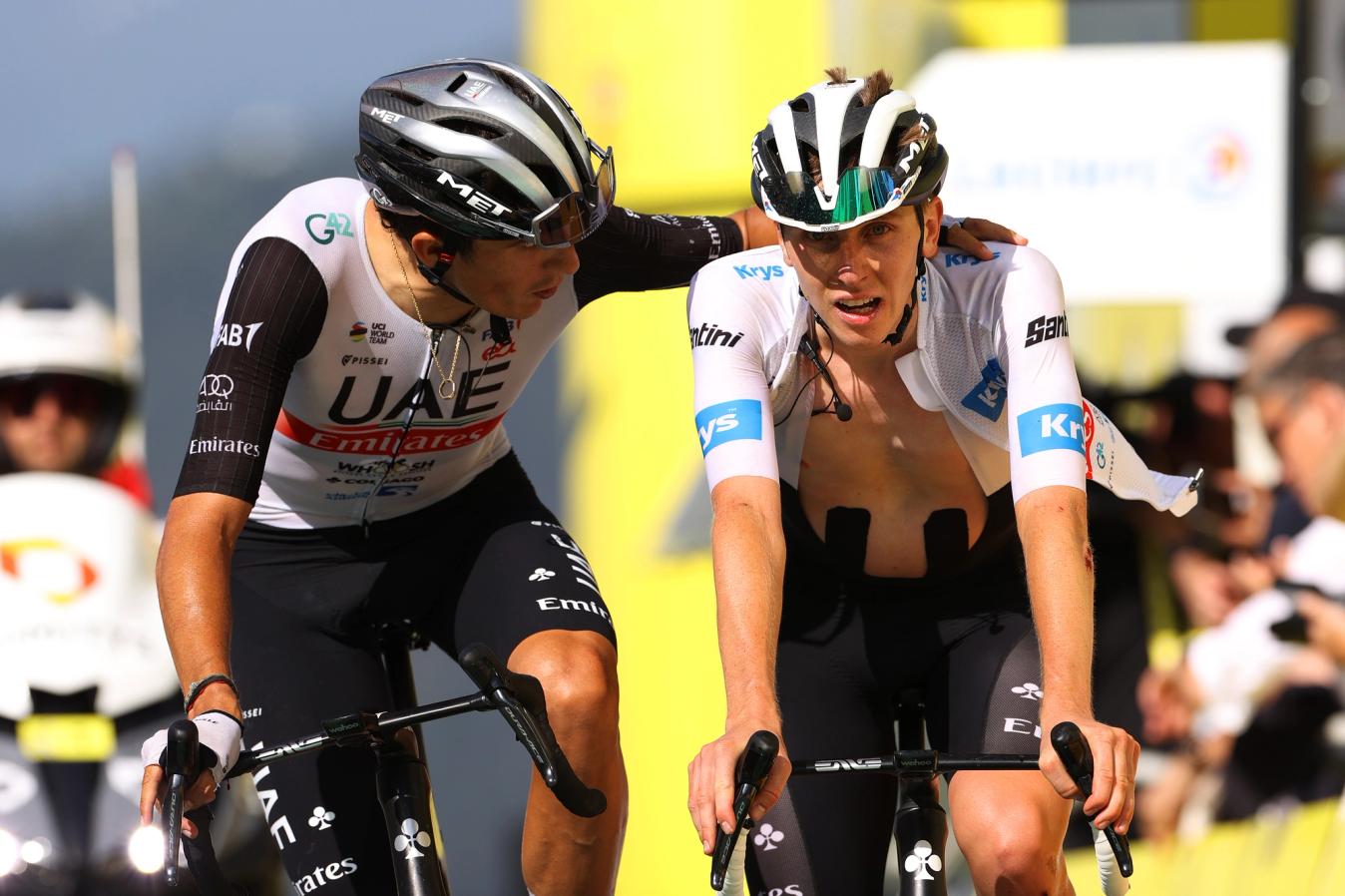
© Velo Collection (Michael Steele) / Getty Images
A dejected Tadej Pogačar crosses the line over five minutes behind Jonas Vingegaard.
Those words from Pogačar effectively signalled the end of his Tour de France challenge as he dropped back from the yellow jersey group, eventually losing nearly six minutes to Vingegaard.
The Dane is now in a prime position to reclaim his title and join Pogačar on two Tour de France victories.
| Grace Brown and Michael Matthews headline Australia squad for World Championships
Australia has announced its squad for the road events at the upcoming World Championships, with Grace Brown and Michael Matthews once again headlining.
The duo will line up for their respective road races where Matthews will be hoping to emulate or better the third-place finish he achieved on home roads in Wollongong last season. Brown will also take on the time trial alongside Georgie Howe having finished runner-up in the event in 2022.
Two-time former world champion Rohan Dennis leads the men’s time trial team for one final time before he retires at the end of the season. The 33-year-old took back-to-back victories in 2018 and 2019 before failing to add a third title in 2020, the last time he competed at the event. He’ll be joined by current Australian time trial champion Jay Vine.
Now only weeks away, the Glasgow event will bring all of the cycling events together into one big World Championships for the first time.
Medals will be won and World Champions crowned across a range of disciplines including road, cross-country, cross-country marathon, downhill, observed trials, track cycling, para-cycling, Freestyle BMX and BMX racing.
Including the road teams, Australia will take 121 athletes to Glasgow in total.
Women’s Elite Road Race: Grace Brown, Brodie Chapman, Lauretta Hanson, Alexandra Manly, Ruby Roseman-Gannon, Sarah Roy and Amanda Spratt.
Women’s Elite Individual Time Trial: Grace Brown and Georgie Howe.
Men’s Elite Road Race: Simon Clarke, Luke Durbridge, Caleb Ewan, Kaden Groves, Michael Matthews, Robert Stannard, Luke Plapp and Harry Sweeny.
Men’s Elite Individual Time Trial: Rohan Dennis and Jay Vine.
| Kristen Faulkner to miss World Championships after developing a blood clot
Kristen Faulkner ( Jayco AlUla ) has provided a further update after her training ride crash in May, confirming that she’s since developed a blood clot which will keep her out of action until the middle of September.
The American was originally ruled out of the Giro d’Italia Donne and Tour de France Femmes after being hit by a vehicle and fracturing her knee while training on May 28. That lay off has now been extended due to further help complications meaning that she will also miss the World Championships in Glasgow having originally been announced in the US squad for the time trial.
If all goes to plan, Faulkner is hoping to return to racing at the Tour de Romandie Féminin on September 15.
“After my accident in May, I developed a blood clot in my lung from all the swelling,” the American said in an Instagram post . “It will take 3 months to heal, during which time I cannot ride outside. Unfortunately, this means that I will also miss the World Championship and my first race will be Romandie on September 15-17.
“I am disappointed to miss such important races this season when I started out the year in the best shape of my life. However, my long-term health is my #1 priority, and my doctors recommend I take this time to fully recover so that I can come back 100% for the end of this season and next year.”
.jpg?w=1348&auto=format)
© Velo Collection (Luc Claessen) / Getty Images
Kristen Faulkner last raced at La Vuelta Femenina.
| Charlotte Kool ‘dreaming’ of yellow jersey in opening stage of Tour de France Femmes
With an incredible set of results already on her 2023 palmarès, Charlotte Kool ( dsm-firmenich ) heads into the Tour de France Femmes avec Zwift as one of the marquee sprinters aiming for a stage win and potential yellow jersey on stage 1.
The Dutch sprinter has enjoyed a meteoric rise this year, with a win tally that’s already into double figures, and the opening stage is set for another standout performance.
“I’ve been dreaming about the yellow jersey and stage 1 all winter,” the 24-year-old told GCN in a pre-race interview on Wednesday.
“When I was making my efforts in the winter this was on my mind. I can’t say for sure that stage 1 will be a bunch sprint, because the hill at the end isn’t easy at all, and with so many riders at their top form, it won’t be easy. But we’ll go all-in for a sprint and then see what that brings.”
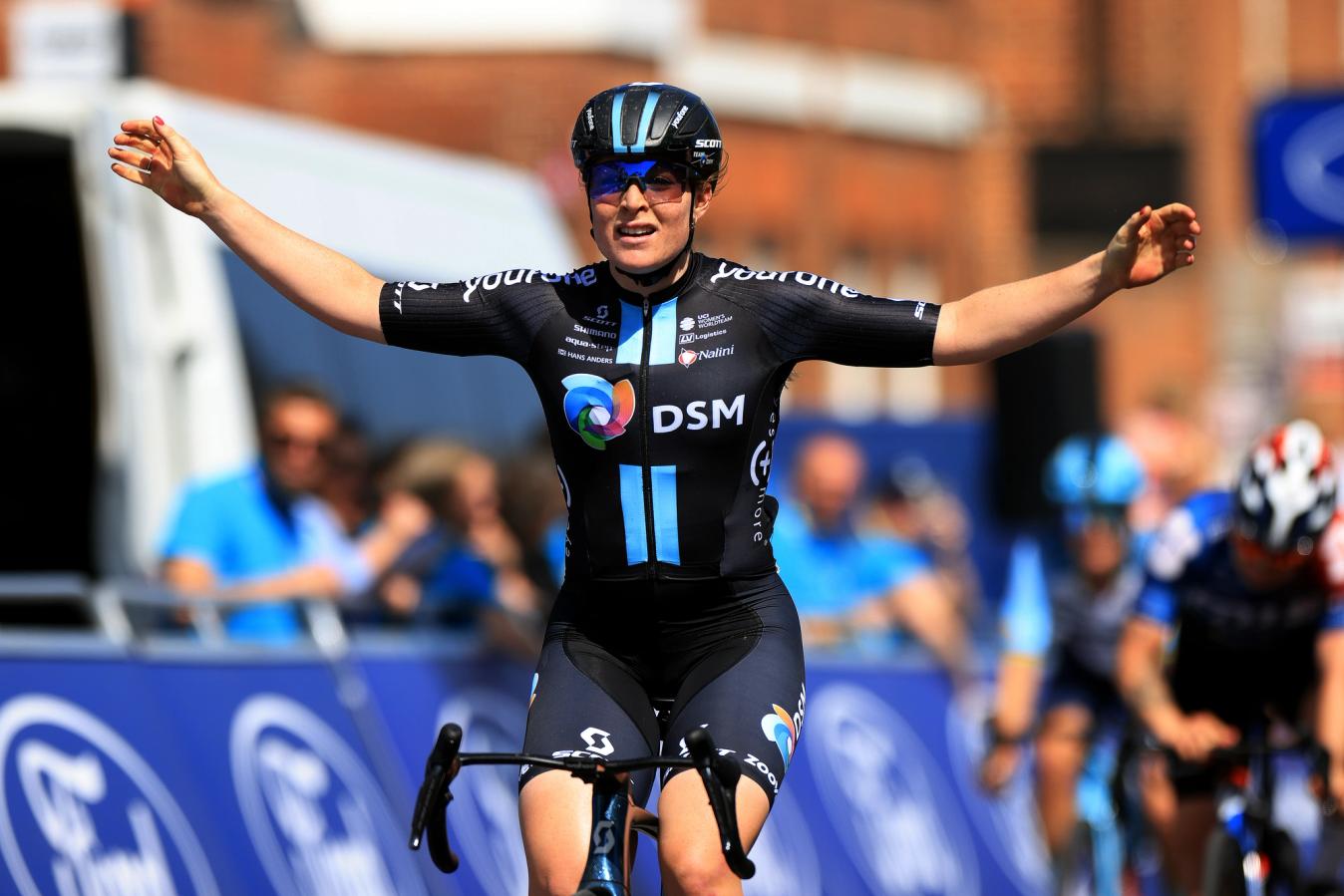
© Velo Collection (Stephen Pond) / Getty Images
Charlotte Kool has already taken 11 wins in 2023.
With a climb inside the final 20km, stage 1 of the Tour de France Femmes is far from a nailed-on day for the sprinters. Given Kool’s form and her team’s consistent backing, the Dutchwoman will be one of the big favourite’s should it end in a bunch sprint.
There will be extra incentive for the sprinters to survive the final climb with the first yellow jersey up for grabs. Who will claim it? Watch stage 1 of the Tour de France Femmes live or on-demand on GCN+ .
| Alexis Renard abandons Tour de France after time trial crash
Stage 16 of the Tour de France proved to be a brutal day, claiming many victims, and not all of those were at the hands of eventual winner Jonas Vingegaard (Jumbo-Visma). Before the pre-stage favourites had even warmed up, three of the early starters all hit the deck on the opening corner.
Alexis Renard ( Cofidis ) and dsm-firmenich duo John Degenkolb and Nils Eekhoff were the unfortunate victims, all slipping out on a painted section of the road. While dsm’s riders appeared to come away from their crashes unscathed, Renard suffered a fractured elbow, forcing him to abandon the race.
“Unfortunately, Alexis Renard won't ride tomorrow,” Cofidis confirmed after the stage on Twitter . “Following his fall at the start of the stage, our Breton rider suffered a fractured right elbow.”
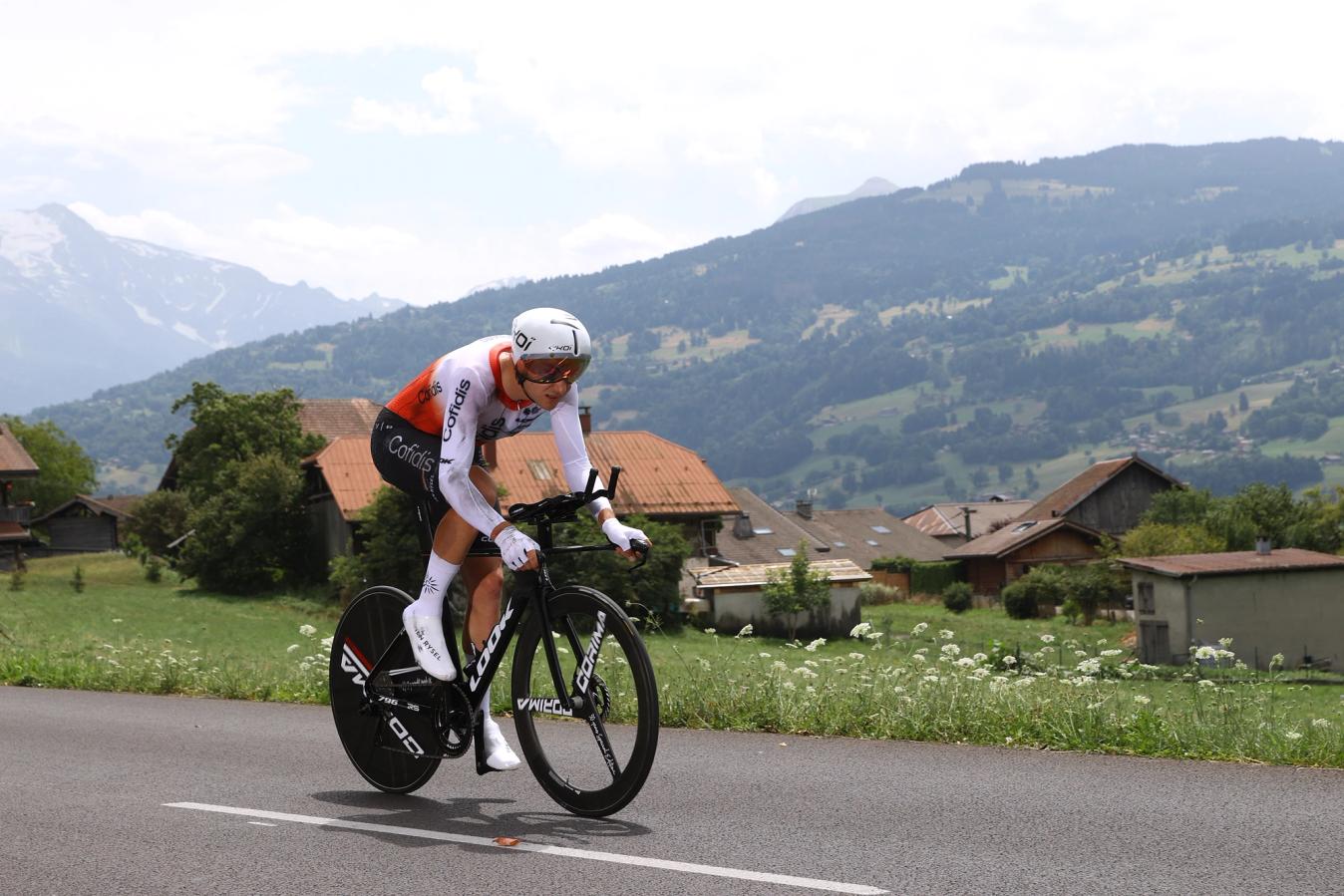
Alexis Renard became the latest rider to abandon the Tour de France after crashing on stage 16.
Even without the injury, Renard’s participation in the race was unknown after he finished the stage last, 10:46 behind winner Vingegaard and one second outside of the time cut.
After the crashes, the organisers appeared to move the barriers further into the road to seal off the spot where the riders had slipped out.
| Pascal Ackermann set to join Israel-Premier Tech
Pascal Ackermann is on the verge of joining Israel-Premier Tech for the 2024 season, according to WielerFlits .
The German sprinter is out of contract with UAE Team Emirates at the end of the season, and while riders can’t officially join new teams until the August transfer window opens, it’s believed that he’s signed an agreement that will be announced in the coming weeks.
It would bring to an end his two-year stint with the team having first joined from Bora-Hansgrohe at the beginning of 2022. During that time Ackermann has struggled to pick up wins, only topping the podium on four occasions. That’s compared to 36 victories in the four seasons before he joined the team.

AG2R Citroën Team
- Nationality France
- Founded 1992
- Team Principal Vincent Lavenu
- UCI Code ACT
- Bike Sponsor BMC

Jumbo-Visma
- Nationality Netherlands
- Founded 1984
- Team Principal Richard Plugge
- UCI Code TJV
- Bike Sponsor Cervélo

- Team Decathlon AG2R La Mondiale Team
- Nationality Austria
- Height 1.78m

Jonas Vingegaard
- Team Team Visma | Lease a Bike
- Nationality Denmark
- UCI Wins 35
- Height 1.75m
Latest Videos
1 We Tried To Copy A Pro Cyclist's Diet | Did We Puke?

2 How Much Fitter Did I Get In 6 Weeks of Training for Flanders?

3 What’s The Best Bike For $1000? | GCN Tech Show 327

4 Rainbow Ronde? The Big GCN Tour of Flanders Preview

5 The Best Emergency Snacks To Keep You Cycling

Tom is our Online Production Editor who creates tech content for the GCN website
Related Content
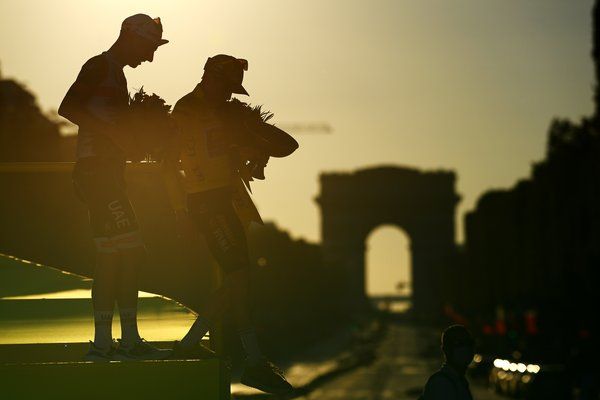
Tour de France: unchained and explained
Netflix got you curious? Here is what you need to know before watching the 2023 Tour de France live

News Round-up: Jayco AlUla and Liv Racing TeqFind announce merger
As the Tour de France rests, the news keeps flowing from the rest of the cycling world

Tour de France bikes ranked: cheapest to most expensive
Which team has the most expensive bike in the Tour de France peloton?
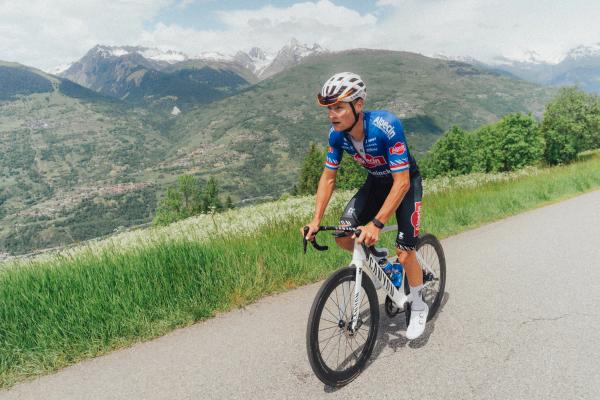
Canyon releases Mathieu van der Poel’s Aeroad CFR Tour de France bike
Special-edition bike has custom white colourway and unique decals
Subscribe to the GCN Newsletter
Get the latest, most entertaining and best informed news, reviews, challenges, insights, analysis, competitions and offers - straight to your inbox
Tour de France 2023: Six key stages you need to watch in the men's race next July
Six stages where drama in the fight for the yellow jersey could unfold in the 110th edition of the Tour de France
- Sign up to our newsletter Newsletter
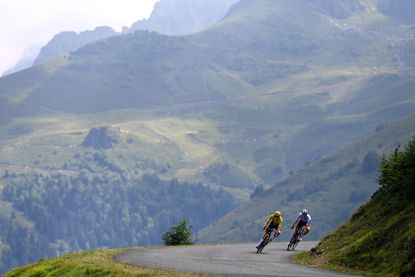
The 110th edition of the Tour de France will get underway in Bilbao in 2023 before wrapping up three weeks later in Paris.
Taking place between 1-23 July, the 3,404 kilometre route packs plenty of punches which includes stages in all five of the country’s mountain ranges. In total there are four summit finishes to contend with including a return to the iconic Puy de Dôme climb, and just one 22 kilometre individual time trial.
A Grand Départ in the Basque Country means plenty of drama in the opening few stages which riders of the mould of Julian Alaphilippe and Tom Pidcock will relish. After the race leaves the Basque Country, it then moves through the Pyrenees and into France with a sprint finish in Bordeaux before returning to the mountains.
At the grand unveiling of the route, race director Christian Prudhomme called it "one for the climbers" as the multiple summit finishes and steep roads were revealed. With that considered, it makes it highly likely that riders such as Remco Evenepoel , Geraint Thomas and Primoz Roglič will head to the Giro d’Italia next year with Jonas Vingegaard and Tadej Pogačar expected to lock horns in France.
The big surprise was that there is no final weekend time trial as was widely expected, and no team time trial as was rumoured beforehand.
Here are the six key stages where we predict early drama to take place as well as battles between the overall favourites throughout the three weeks.
STAGE TWO: VITORIA-GASTEIZ - SAN SEBASTIAN 210 km

Stage two is undoubtedly one for the puncheurs featuring many of the climbs associated with the Clasica San Sebastian .
Get The Leadout Newsletter
The latest race content, interviews, features, reviews and expert buying guides, direct to your inbox!
The 210 kilometre stage includes the Cote d’Aztiria, Cote d’Alkiza as well as the infamous Jaizkibel climb where the Basque fans will be out in full force. At 8.1 kilometres, the Jaizkibel is a nasty little ramp with sections touching eight per cent which the riders will have to contend with before speeding towards the finish.
In August, Remco Evenepoel cut his way through a sea of fireworks, beer and screaming fans as he sped towards a second Klasikoa title on the Jaizkibel. Next July, expect a rider of the calibre of Julian Alaphilippe, Wout Van Aert or Matej Mohoric to be right in contention on stage two of the Tour.
STAGE SIX: TARBES - CAUTERETS-CAMBASQUE 145 km

Stage six sees the mighty Col du Tourmalet return to the Tour with the prize of the Souvenir Jacques Goddet , awarded to the first rider to cross the top of the Tourmalet, at the summit.
At just 145 kilometres, it includes three huge climbs including the well-known Col d’Aspin, the Col du Tourmalet and the first summit finish of the 2023 edition at Cauterets-Cambasque. The climb up to the finish is 16 kilometres in length with an average gradient of just 5.4%. However, the final three kilometres pitch all the way up to 10% meaning serious damage could be done in those final three kilometres alone.
Tadej Pogačar’s teammate Rafal Majka won the last time the race visited Cauterets in 2015. The stage may come too early for a GC battle this year, so expect a climber to win from a breakaway in similar style to Majka’s victory. Arka-Samsic's Warren Barguil could be a surprise favourite on a stage such as this.
STAGE NINE: SAINT-LÉONARD-DE-NOBLAT - PUY DE DǑME 184 km
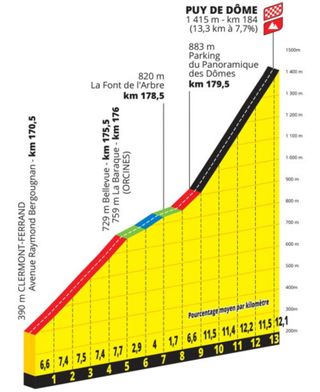
After much speculation, it was finally confirmed in October that the iconic Puy de Dôme mountain would be returning to the French grand tour in 2023 for the first time since 1988.
The 1,465 metre dormant volcano, located in the heart of the Massif Central will provide a horrific test of strength and endurance at the end of stage nine. It may also perhaps provide the first major general classification showdown. At 13.3 kilometres in length, with an average gradient of 7.7% it’s a climb that Vingegaard and Pogačar will both want to win on to add to their already glittering palmares.
In 1964, the final climb was the site of a legendary duel between five time winner Jacques Anquetil and Raymond Poulidor. Eddy Merckx was also punched there in 1975 by a spectator tired of the Belgian's dominance.
Whoever has their arms in the air celebrating victory on stage nine will firmly write their name into cycling and Tour de France folklore.
STAGE 14: ANNEMASSE - MORZINE LES PORTES DU SOLEIL 152 km

Stage 14 has all the makings of a savage day on the bike with a consistently up and down parcours .
There is a grand total of 4,200 metres of elevation stacked within the 152 kilometre stage. The day includes six climbs, which includes the gruelling Col de la Ramaz before the brutal Col de Joux Plane, followed by the fast and furious descent into Morzine.
Due to the technicalities of the descent, any time gap at the top of the climb could be devastating, as only the bravest of descenders would dare to force a gap on the downhill run into Morzine.
With stage 15 and another summit finish to come, will the riders at the sharp end of the general classification be willing to sacrifice everything with such a tough day still to come?
STAGE 15: LES GETS - MONT BLANC 180 km
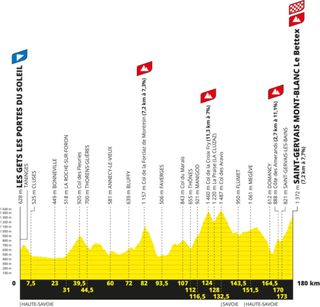
A gruelling Alpine weekend draws to a close with a 180 kilometre long test which concludes on the slopes of Mont Blanc.
The ride through the Haute-Savoie includes the trio of the Col de la Forclaz, the Croix Fry and the Col des Aravis. With that demanding trio out of the way, it’s onto the slopes of the final climb which begins with the 11% Côte des Amerands. As the riders crest the Amerands the road goes sharply upwards with sections touching 17% according to the organisers.
Either way, it’s one for the pure climbers once again and will inevitably provide a GC showdown.
STAGE 17: SAINT GERVAIS-MONT BLANC - COURCHEVEL 166 km
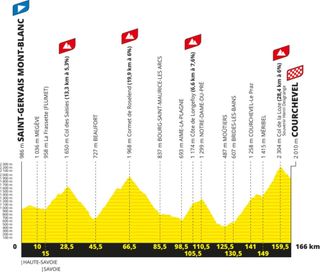
The high mountains continue on stage 17 with the mighty Col de la Loze on the menu. It’s arguably the Queen Stage of the 2023 edition with the Cormet de Roselend, the Col des Saisies and the Col de la Loze all playing a major role in proceedings.
With its inconsistent gradients and sections touching 20%, the 2,304 metre Col de la Loze is a beyond fearsome climb which is enough to strike fear into even the most talented of climbers.
The 2020 Tour included a summit finish at the top of the climb. Miguel Ángel López took the stage honours that day and another South American, Richard Carapaz, came unstuck on the slopes of the Loze after a gruelling day in the breakaway.
The Souvenir Henri Desgrange , awarded to the first person over the peak of the Tour, is at the top of the climb, and is a fitting prize to go with the stage win for whoever crosses the line first at Courchevel.
Thank you for reading 20 articles this month* Join now for unlimited access
Enjoy your first month for just £1 / $1 / €1
*Read 5 free articles per month without a subscription
Join now for unlimited access
Try first month for just £1 / $1 / €1
Tom joined Cycling Weekly in early 2022 and his news stories, rider interviews and features appear both online and in the magazine.
He has reported from some of professional cycling's biggest events and races including the Tour de France and the recent Glasgow World Championships. He has also covered races elsewhere across the world and interviewed some of the biggest stars in the sport including Tom Pidcock, Wout van Aert, Primož Roglič and Lizzie Deignan.
When not writing news scoops from the WorldTour, or covering stories from elsewhere in the domestic professional scene, he reports on goings on at bike shops up and down the UK, where he is based when not out on the road at races. He has also appeared on the Radio Cycling podcast.

Every human brain works slightly differently, yet too often we demand bland conformity. Chris Marshall-Bell meets riders unashamed to cherish their uniqueness
By Chris Marshall-Bell Published 30 March 24
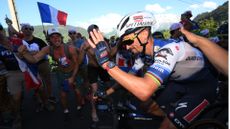
Yes, it's polite, but there's another reason why you should always smile (and wave) at other riders
By Hannah Bussey Published 30 March 24

Dutchman starts his 2024 road season at Italian Monument on Saturday
By Tom Thewlis Published 15 March 24

US star grabbed his first ever Grand Tour win at last year’s Giro d’Italia
By Tom Thewlis Published 8 March 24
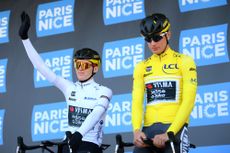
The American could step into the leaders yellow jersey on Tuesday evening after stage three’s team time trial in Auxerre
By Tom Thewlis Published 5 March 24
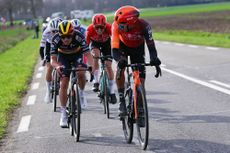
Colombian snapped up key bonus seconds in the general classification battle on run in to Les Mureaux
By Tom Thewlis Published 3 March 24
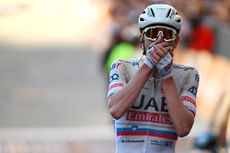
'He can still surprise us all the time’ João Almeida on Pogačar's performance in Tuscany

Roglič up against Remco Evenepoel for the first time in 2024 as he gets set for a return to the Tour de France
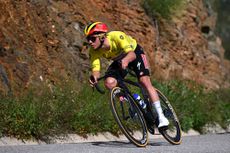
Evenepoel starts season in fine form ahead of Tour de France debut this summer
By Tom Thewlis Published 19 February 24
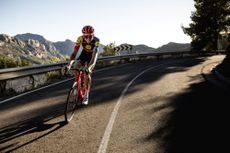
British rider set to make racing comeback at Volta ao Algarve on Wednesday, nine months after serious crash
By Tom Thewlis Published 13 February 24
Useful links
- Tour de France
- Giro d'Italia
- Vuelta a España
Buyer's Guides
- Best road bikes
- Best gravel bikes
- Best smart turbo trainers
- Best cycling computers
- Editor's Choice
- Bike Reviews
- Component Reviews
- Clothing Reviews
- Contact Future's experts
- Terms and conditions
- Privacy policy
- Cookies policy
- Advertise with us
Cycling Weekly is part of Future plc, an international media group and leading digital publisher. Visit our corporate site . © Future Publishing Limited Quay House, The Ambury, Bath BA1 1UA. All rights reserved. England and Wales company registration number 2008885.
Tour de France 2023: Gall wins Queen Stage, Vingegaard cements GC lead

Results 17th stage 2023 Tour de France
1. Felix Gall (aut) 2. Simon Yates (gbr) + 0.34 3. Pello Bilbao (spa) + 1.38 4. Jonas Vingegaard (den) + 1.52 5. David Gaudu (fra) + 2.09 6. Tobias Halland Johannessen (nor) + 2.39 7. Chris Harper (aus) + 2.50 8. Rafal Majka (pol) + 3.43 9. Adam Yates (gbr) s.t. 10. Wilco Kelderman (nld) + 3.49
12. Jai Hindley (aus) + 4.25 15. Carlos Rodriguez (spa) + 4.54 16. Sepp Kuss (usa) + 5.43 22. Tadej Pogacar (slo) + 7.37
GC after stage 17 1. Jonas Vingegaard (den) 2. Tadej Pogacar (slo) + 7.35 3. Adam Yates (gbr) + 10.45 4. Carlos Rodriguez (spa) + 12.01 5. Simon Yates (gbr) + 12.19 6. Pello Bilbao (spa) + 12.50 7. Jai Hindley (aus) + 13.50 8. Felix Gall (aut) + 16.11 9. Sepp Kuss (usa) + 16.49 10. David Gaudu (fra) + 17.57
Race report KOM leader Giulio Ciccone, Neilson Powless, Mads Pedersen, Jonas Gregaard and Luka Mezgec jump off the front after 10 kilometres of action. The five enter the Col des Saises with a 30 seconds lead, but they are caught by the front of the peloton. A group with Rafal Majka, Thibaut Pinot, Neilson Powless, Rigoberto Uran, Julian Alaphilippe, Jack Haig, Giulio Ciccone, Mattias Skjelmose, Felix Gall, Rui Costa, Victor Lafay, Kevin Vermaerke, Krists Neilands, Simon Yates, Lawson Craddock, Chris Harper, Clément Champoussin and Jonas Gregaard pushes on, but the Jumbo-Visma led peloton keeps them on a leash and brings the attackers back in the final kilometre of the climb.
Alaphilippe strikes on descent, while Ciccone and Neilands track him down. Gregor Mühlberger, Jack Haig, Kevin Vermaerke and Mattias Skjelmose rejoin them in the valley before a huge group of riders – Tiesj Benoot, Wilco Kelderman, Rafal Majka, Marc Soler, David Gaudu, Stefan Küng, Valentin Madouas, Thibaut Pinot, Magnus Cort, Rigoberto Uran, Dries Devenyns, Pello Bilbao, Ben O’Connor, Nans Peters, Felix Gall, Rui Costa, Guillaume Martin, Matthew Dinham, Hugo Houle, Nick Schultz, Simon Yates, Lawson Craddock, Chris Harper, Clément Champoussin, Simon Guglielmi, Alexey Lutsenko, Gianni Moscon, Tobias Halland Johannessen, Jonas Gregaard – bridges across on the Cormet de Roselend.
While the lead group opens up a maximum gap of over 3 minutes, Ciccone takes maximum KOM points on the Saises, Cormet de Roselend and Côte de Longefoy. The Italian loses contact on the early slopes of the Col de la Loze.
The lead group is down to Felix Gall, Simon Yates, Chris Harper and Rafal Majka when Tadej Pogacar loses contact in the GC group. Moments later Gall heads out alone.
Benoot waits for Jonas Vingegaard and starts setting the pace. Adam Yates is the last rider to be dropped from the Jumbo Bees mini train.
Simon Yates leaves Majka behind and reaches the summit of the Col de la Loze 23 seconds after Gall. Vingegaard crests the giant 1.30 minutes later with Bilbao and Gaudu in his wheel.
Gall holds on on descent and in the steep last 600 metres to take the best win in his career. Yates finishes in second, while Bilbao drops Vingegaard in the dying metres to finish in third. The Dane won’t bother as he finishes 5.45 minutes ahead of Pogacar and virtually seals his second Tour de France victory in a row.
Another interesting read: route 17th stage 2023 Tour de France.
Tour de France 2023 stage 17: routes, profiles, more
Click on the images to zoom
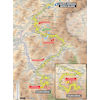
Official games

2023 Edition
- Stage winners
- All the videos
Tour Culture
- Commitments
- key figures
- Sporting Stakes
- "Maillot Jaune" Collection
- The jerseys

The double dose of Mont Ventoux
Race facts will determine whether or not this is the queen stage. The double ascent of the Mont Ventoux is certainly one of the highlights of the 108th Tour de France. It’s unprecedented. Gordes is a touristic gem on the route. Col de Liguière (cat. 1) is an opportunity to fire up the race. The versant of the Giant of Provence via Sault is softer than the other one, via Malaucène. However, the fast downhills might be as crucial as the uphills. It’s the hottest venue of the whole race. Yellow jersey holder Tadej Pogacar said he’s looking forward to this unique experience that is likely to contribute to his legend.

You may also enjoy

Biofreeze, a refreshing wind on the Tour de France

IBIS STYLES AND IBIS BUDGET JOIN THE TOUR DE FRANCE

D-100: ITALY TURNS YELLOW
Receive exclusive news about the Tour

Accreditations
Privacy policy, your gdpr rights.
- Skip to main content
- Keyboard shortcuts for audio player
After more than 30 years, a multiday women's Tour de France is back
Tom Goldman

Ashleigh Moolman-Pasio of Team South Africa leads the peloton during the women's road race on the second day of the 2020 Olympic Games at Fuji International Speedway on July 25, 2021 in Oyama, Shizuoka, Japan. Michael Steele/Getty Images hide caption
Ashleigh Moolman-Pasio of Team South Africa leads the peloton during the women's road race on the second day of the 2020 Olympic Games at Fuji International Speedway on July 25, 2021 in Oyama, Shizuoka, Japan.
Bicycle racing's most famous competition, for men, ends Sunday in Paris.
But on the same day, in the same city, another version of the Tour de France begins .
And this one is for the world's best female riders.
It's been more than 30 years since women have competed in a viable, multistage Tour de France. Now they finally have another chance, and it's due, in large part, to the pandemic.
Pedaling to victory at home
With COVID-19 surging in 2020, elite cyclists, pretty much like everyone, were on lockdown.
But for them, as the proverbial door closed, another opened.
The company Zwift , which combines fitness and video gaming for indoor training, put on virtual races worldwide, with separate contests for men and women. Including a virtual Tour de France.
Some pro cyclists rolled their eyes.
"Like, I did not want to ride inside. I thought it was dumb," said American cyclist Lily Williams. "You know it's harder to ride inside because you're just staring at the wall."
Others embraced the chance to break the drudgery of indoor training and maintain a level of competitiveness, albeit virtual.
"I saw the opportunity it presented for us in one of the most challenging years for the world," said Ashleigh Moolman-Pasio, a 13-year veteran of women's pro cycling.
It paid off for Moolman-Pasio.
She pedaled to victory in stage five of the 2020 virtual Tour de France, the so-called "queen stage." The toughest stage in a multiday road race.
The next day, Moolman-Pasio and her husband ventured outside their home in Girona, Spain, and noticed people pointing.
"He's like, 'Well, it's because of the Tour de France,' " Moolman-Pasio said. "You know you were on TV and everyone saw you winning the queen stage."
It was not an isolated incident.
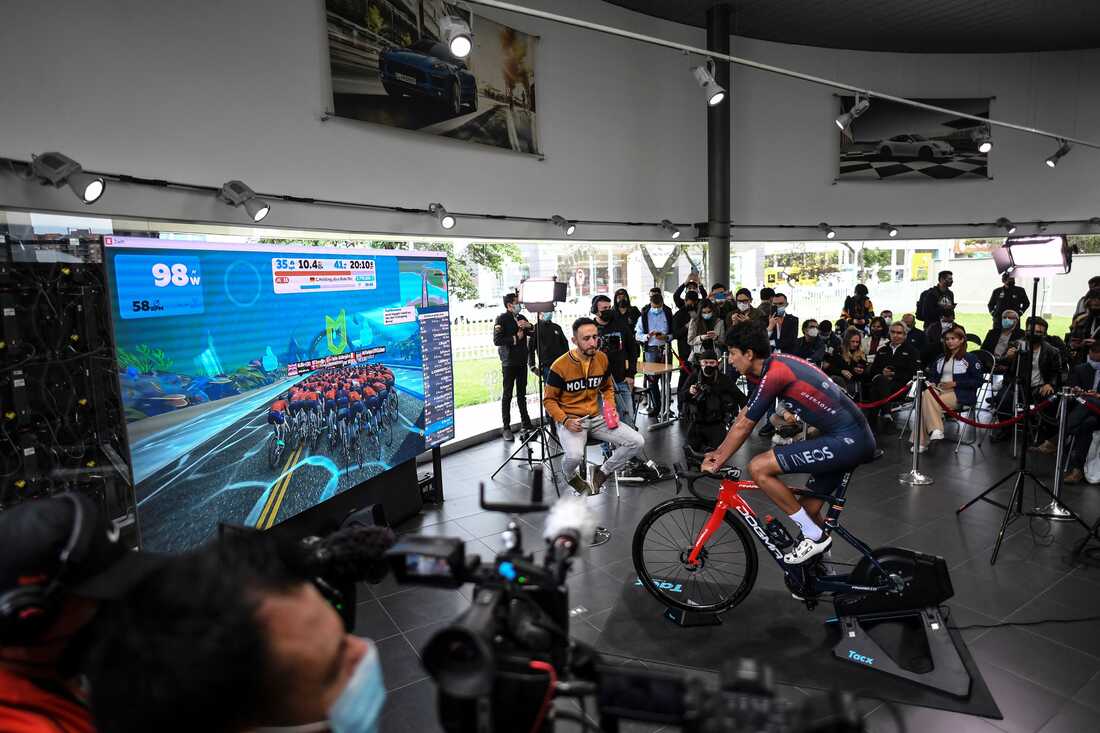
Colombian rider Egan Bernal , the 2019 Tour de France champion, holds a virtual test during a news conference in Bogota on April 2, 2022. JUAN BARRETO/Juan Barreto/AFP via Getty Images hide caption
Colombian rider Egan Bernal , the 2019 Tour de France champion, holds a virtual test during a news conference in Bogota on April 2, 2022.
Turning virtual racing into reality
According to Zwift, more than 16 million people in more than 130 countries saw the virtual races – on television and digital platforms. And viewership was equally split between the men's and women's events.
Longtime Tour de France organizer ASO — the Amaury Sport Organization — saw in those numbers the potential for women's cycling.
"That's how the conversation started," said Moolman-Pasio.
The conversation with Zwift was about launching a real women's Tour, one with heft and sustainability. A top-notch broadcast plan was critical.
"That's the key to the success of the race," said Kate Veronneau from Zwift, "to building that audience, to building future investment and growing the race and keeping it around."
Veronneau says broadcasting to 190 countries on each of the race's eight days should certainly help keep the new women's Tour de France around.
After so many other Tours had gone away.

Laurent Fignon, left, of France, and Marianne Martin of Boulder, Colo., hold up their trophies in Paris after winning the men's and women's Tour de France cycling races on July 23, 1984. Steven/AP hide caption
Trials, and lots of errors
In 1955, a five-stage loop from Paris to Normandy marked the first women's Tour de France. But it only lasted a year.
It wasn't until 1984 that organizers tried again.
A multistage event called the Tour de France Feminin ran for six years. It featured three wins for French cycling legend Jeannie Longo .
She won the last event in 1989. That Tour folded, like other versions after, because of uneven media coverage and sponsorship.
Both are there now.
Zwift won't say how much money it's poured into its four-year title sponsorship of the Tour de France femmes avec Zwift . But it's enough for about $250,000 in prize money, with $50,000 to the winner.
Finally seeing women
Moolman-Pasio is one of many veteran riders who've fought for a viable women's Tour de France. She's thrilled about finally getting to race in cycling's most prominent event, and about the girls and young women who'll be watching.
"Instead of sitting on the couch and watching the Tour de France and seeing men race up these epic climbs and fighting for the yellow jersey, finally they will see [women]," Moolman-Pasio said. "And it's the opportunity for them to recognize pro cycling as a career choice."
It's still a challenging choice, though.
Many female pro cyclists have to work as well as race.
Williams, the U.S. rider who thought virtual racing was dumb but now likes it so much she sometimes rides inside intentionally, was one of them. She's spent most of her five years as a pro working another job – as communications director for a bike registration network.
But the financial landscape is changing, and finally, Williams is a full time pro.
"This is the first year I've made a full salary from cycling," she said. "Now I actually have the opportunity to just race my bike, which I can't even tell you goes so far because not only is the training and racing incredibly demanding but the travel and the recovery require so much more of you than it did before."
The sport's governing body, the Union Cycliste Internationale (UCI), has been raising minimum salaries for women competing on professional teams. Team budgets are growing, as is prize money across the board. After the Tour de France femmes avec Zwift announced its record $250,000 purse, another women's grand tour event, the Giro d'Italia Donne, matched the Tour's prize money amount.
In her short professional career, Williams has won a World Championship gold medal and Olympic bronze in track cycling. She's excited about the upcoming Tour, a hallowed road race she watched every year, with her family, growing up.
A race now for women too.
"I think it's [part of] the general trend we're seeing everywhere," Williams said, "where women are gaining equal opportunity across the board in a lot of different areas of the world. So it's all kind of coming to a head. And I think the Tour de France is going to be such a great opportunity for us to showcase that as well."
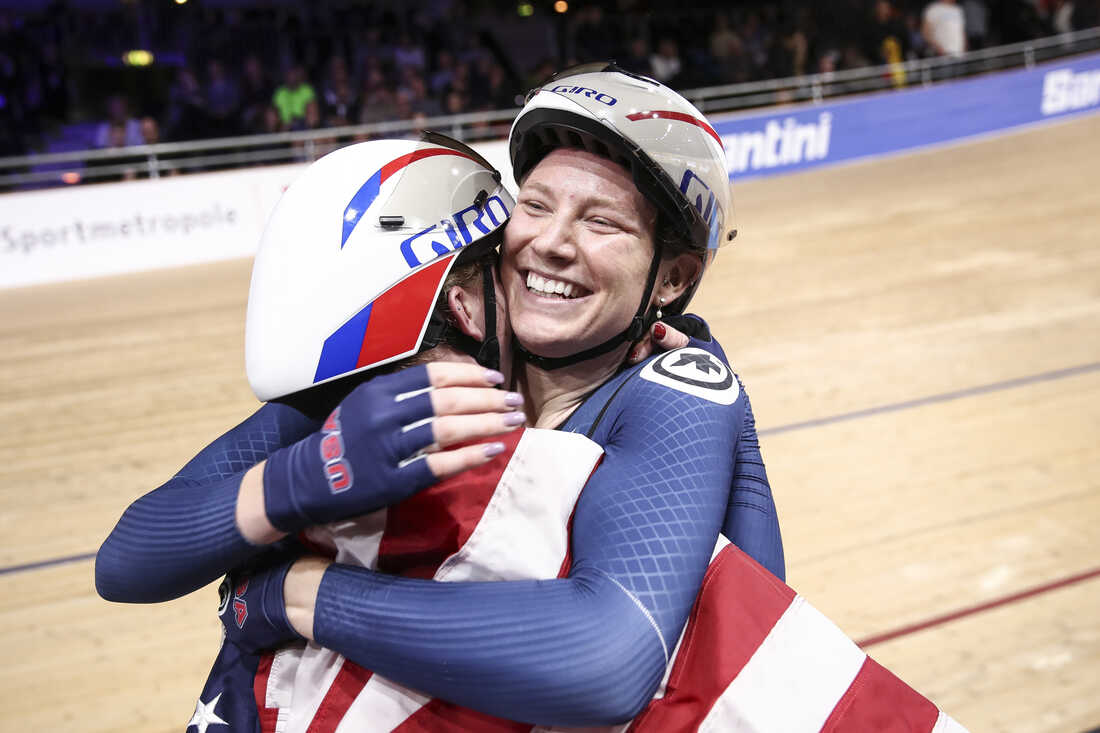
Lily Williams celebrates after the Women's Team Pursuit Finals during the second day of the UCI Track Cycling World Championships on Feb. 27, 2020, in Berlin. Maja Hitij/Getty Images hide caption
Lily Williams celebrates after the Women's Team Pursuit Finals during the second day of the UCI Track Cycling World Championships on Feb. 27, 2020, in Berlin.
Eight, for now
It will be a shorter showcase than the men's Tour.
Women's teams aren't big enough, at least for now, to support a 21-stage Tour de France like the men.
"The top women are more than ready to race three weeks," said Sadhbh O'Shea, a bicycle racing writer for VeloNews. "[But with] a good chunk of these riders working part time to fund their racing, until we can get a full peloton of professional riders, I don't think the women's sport is ready for a full three-week stage race."
But O'Shea thinks the eight-stage race starting Sunday is right for this initial effort.
With so much racing in the men's Tour, "you tend to get these dips in terms of the pace and aggression," O'Shea said. "Whereas with the women's racing, because it's shorter because there are fewer riders, it tends to be a little more gung-ho right from the start and all the way through. You do occasionally get lulls, but it tends to be more action, more of the time."
The women's stages average 80 miles, the men 99.
The action starts Sunday in Paris, before the men arrive for their finish, when the women will own the city streets. Their first stage begins at the Eiffel Tower – 12 laps, or 50 miles later — it ends on the Champs-Elysees. After the city, seven more stages of sprints, grueling mountain climbs and even sections of gravel and dirt roads.
By the end, on July 31, the new women's Tour hopes to finish with new fans, and a promise to be back – year after year.
Cookie banner
We use cookies and other tracking technologies to improve your browsing experience on our site, show personalized content and targeted ads, analyze site traffic, and understand where our audiences come from. To learn more or opt-out, read our Cookie Policy . Please also read our Privacy Notice and Terms of Use , which became effective December 20, 2019.
By choosing I Accept , you consent to our use of cookies and other tracking technologies.

Follow Podium Cafe online:
- Follow Podium Cafe on Twitter
- Follow Podium Cafe on Facebook
Site search
- Tour de France
- Cafe Bookshelf
- Women’s Cycling
- FSA Directeur Sportif
- Full Archive
- DraftKings Nation
- Community Guidelines
Filed under:
Mythologies: Queen Stages and Circles of Death – Things Ancient and Modern
If you buy something from an SB Nation link, Vox Media may earn a commission. See our ethics statement .
Share this story
- Share this on Facebook
- Share this on Twitter
- Share this on Reddit
- Share All sharing options
Share All sharing options for: Mythologies: Queen Stages and Circles of Death – Things Ancient and Modern
/cdn.vox-cdn.com/uploads/chorus_image/image/72427215/819667778.0.jpg)
“ Stage 17 – Wednesday 22 July [2009]: Bourg-Saint-Maurice – Le Grand Bornand, 169.5km Today was what’s known in cycling terms as the ‘Queen Stage’ of the Tour de France. I don’t know where the term originated, but it’s usually given to the hardest day of the race and, with one second-category climb and four first category mountains to be covered on the 170km through the Alps, today was never going to be easy.” ~ Nico Roche, Inside the Tour de France
When did bike races get queen stages? And why are they queen stages in some countries but king stages in others? What even is a queen stage?
The Queen and Me
The very first cycling book I read was The Great Bike Race , a book about the 1976 Tour de France written by the Observer ’s then sports editor, Geoffrey Nicholson . A friend I rode with had found a copy in a second-hand bookshop in Dublin and we devoured it, even though it was already a generation out of date by the time we came to it. Other kids my age, they were sharing copies of Goodbye to the Hill – this is Ireland, we’re literary and even our porn comes in book form – but there we were, noses deep in The Great Bike Race . What can I say, I had a depraved childhood.
Flicking through The Great Bike Race again – I have to flick carefully, half the pages are falling out and it’s in danger of turning into a version of BS Johnson’s book-in-a-box, The Unfortunates – there is a curious absence: there is no queen stage in Nicholson’s account of the 1976 Tour.
Nicholson’s front-of-book glossary – the book was published in the 1970s and the English then hadn’t a clue what even a maillot jaune was (“Yellow jersey worn by the race leader; the term applied to the leader himself. It was introduced in 1919 so that the crowds could identify their hero more easily. It is worth £120 a day to the wearer on stages 1 to 14, £50 a day thereafter.”) – had entries for various kinds of étapes (étape, demi-étape , tiers d’étape ) but no étape reine .
:no_upscale()/cdn.vox-cdn.com/uploads/chorus_asset/file/24767977/The_Great_Bike_Race.jpg)
That seemed odd, given the ubiquity of the phrase today. So I turned to Sam Abt, the dean of American cycling journalism, a few of whose books from the 1980s and 1990s I have. And she wasn’t there either. I looked in a few other books. Jeff Connor ’s Wide-Eyed and Legless and it’s up-dated version, Field of Fire : no queen stage. David Walsh ’s Inside the Tour de France : EPO, yes, queen stage, no. I even looked in the fabulist Pierre Chany’s aptly titled Fabuleuse histoire du Tour de France and, even in that collection of made-up nonsense she didn’t put in an appearance.
None of my older books appear to talk of the Tour having a queen stage. How odd is that?
Queen’s Greatest Hits
The earliest reference I can find to the Tour having a queen stage comes from a May 1920 edition of L’Auto, in which Henri Desgrange dubbed the Bayonne-Luchon stage l’étape reine :
“What is the hardest stage? It is indisputable that this is the Bayonne–Luchon stage, and since we are explaining the route to our readers, this is the moment to justify this opinion. Bayonne–Luchon is the queen stage because after 150 kilometres of terrain presenting hardly any difficulties other than the Col d’Osquich, the stage places before the riders – at the moment when the sun is already scorching – nearly 200 kilometres with six formidable cols.”
:no_upscale()/cdn.vox-cdn.com/uploads/chorus_asset/file/23669187/Profile_stage_10_002.jpg)
The cols to be conquered were the mountains we today think of as the Circle of Death: the Col d’Aubisque, the Col du Tourmalet, the Col d’Aspin and the Col de Peyresourde. That’s only four but the Aubisque was a three-for-the-price-of-one bundle that also contained the now disused Col de Tortes along with the Col du Soulor. In this west-to-east passage those two were – despite Desgrange’s hyperbole – just minor rises on the descent off the Aubisque, not formidable in any fashion.
While we today think of these climbs as being the Circle of Death, in the 1920s that was not the case. A decade earlier, while reconning the route of the 1910 Tour, the great directeur sportif Alphonse Baugé had described the descents in the Pyrénées – specifically those off the Col de Port and the Col de Portet d’Aspet – as being like the acrobatic cycling shows ‘Looping the Loop’ and the ‘Circle of Death’ . Baugé used the English name for ‘Looping the Loop, by which this act was universally known, he didn’t Frenchify it.
:no_upscale()/cdn.vox-cdn.com/uploads/chorus_asset/file/24770097/Looping_the_Loop.JPEG)
The French national library, the Bibliothèque nationale de France (BnF), makes available online a lot of out-of-copyright material, which for newspapers and magazines – including the likes of L’Auto and L’Équipe – takes us up to the early 1950s. Apart from that one usage in L’Auto in 1910, nowhere in the BnF’s corpus can I find the Circle of Death – in French or in English – again being used in connection with the Tour. No one in L’Auto picked up on Baugé’s coinage and ran with the idea of the those Pyrenean climbs being a Circle of Death. Nor did anyone anywhere else pick it up and run with it. It was a one-and-done reference until some point in more recent years – how recent is a question yet to be answered – when it became commonplace. The Circle of Death, it’s a part of our sport’s past, but not in the way we’d like to think it is.
Queen’s Gambit
Desgrange is clear in what he wrote that the queen stage is the hardest stage, a king-sized day of pain and altitude gain. There are, though, people who argue that the queen stage derives from a chess reference. The queen being the most mobile piece on a chessboard, she exerts the most influence on the game, therefore the queen stage is the stage that is expected to exert the most influence on the outcome of the Tour. While undoubtedly cerebral and elegant, this is – to use the academic term – complete bollocks. It’s us trying to fill in the blanks and come up with a pretty explanation but nothing more than that, a pretty explanation. That it befits the Tour more than the way Desgrange used l’étape reine – hardest is just brutish, and cycling is supposed to be chess on wheels – is neither here nor there. It’s wrong.
We have done the same thing with crafting explanations for the origins of the Circle of Death. Graeme Fife, in Tour de France: The History, the Legend, the Riders , says this of its origins:
“In what locals called the ‘Circle of Death’ in the Pyrenees, bears roamed and some riders, finding themselves alone in the remote high places, stopped, fearing attack from the wild creatures.”
According to Rosalie Maggio’s biography Marie Marvingt, Fiancee of Danger (2019) the name arises as a result of “the vicious brown bears that roamed the area. (After riders had been threatened and even hurt by the bears, bikers and fans used to shout “Assassin!” at Desgrange when he appeared in public.)”
Maggio’s shouts of assassin, that’s her being an ass and rewriting the history of the Aubisque and trying to make it relevant to the story of Marie Marvingt (who we fantasise rode the route of the 1908 Tour (despite there being zero evidence supporting this), which was two years before the Tour even added the Aubisque).
Fife and Maggio’s bears, they come from a single reference by Alphonse Steinès in his account of his evening on the Tourmalet in June 1910, a single reference from which some have generated imaginary editorials written by Desgrange warning riders to be on the lookout for ursine predators. The only animals the riders of the 1910 and subsequent Tours were actually warned to be wary of were the cows and the horses that crossed the roads at will, a danger to themselves as well as to people travelling on those roads.
:no_upscale()/cdn.vox-cdn.com/uploads/chorus_asset/file/24767870/1269120497.jpg)
If Fife is to be believed and locals did use the name the Circle of Death, how was that phrased in French? There’s a Cirque de Gavarnie, 40 kilometres south of Argelès-Gazost, down near the Spanish border. And there’s a Cirque du Litor, near the Col du Soulor. Cirque here means not a circus but a natural amphitheatre, a bowl-shaped geographical feature, usually formed by retreating glaciers. So the Circle of Death, if it really was a local name, could it originally have been the c irque de la mort ? Would that it were, for instead of riders scared by bears then we could tell tall tales of riders traumatised by circus clowns. Which would be far more colourful, inventive and downright funnier than anything the fabulist Pierre Chany has ever lied to us about.
Sadly, Giles Belbin in A Year in the Saddle (2015) and again in A Ride Through the Greatest Cycling Stories (2017), bursts that bubble by telling us that locals simply called the Circle of Death le Cercle de la Mort . Oddly, the Pyrénées has fewer cercles than it does cirques. One hundred per cent fewer, by my calculations.
Crossing the streams, you can even find one source claiming that the Circle of Death is not a place at all but is the name given to “ the hardest Tour de France stage in the Pyrenees ”. In other words, the Circle of Death is often the queen stage. I really shouldn’t tell you where that is taking my imagination but it involves teeth and is definitely NSFW .
Queen of the Slipstream
Whether Desgrange coined the phrase himself, or came across it elsewhere and borrowed it, we cannot say. What matters here is how quickly and how widely the phrase was taken up by others. The short answer? Not quickly and not widely.
:no_upscale()/cdn.vox-cdn.com/uploads/chorus_asset/file/24767993/Gallicagram___etape_reine.png)
L’Auto didn’t return to the well until 1924 – the year Albert Londres did not use the phrase forçats de la route to describe the Tour’s riders but L’Auto did con people into believing that he had – when it was said that it was a close call between Nice–Briançon (which included the Col d’Izoard and its lunar-like Casse-Déserte) and Bayonne–Luchon as to which stage was the toughest of the race. The presence of the Tourmalet tipped the hand in favour of the latter being the queen stage.
At the end of that Tour, La Gironde ’s Gaston Bénac – who went to take over the sports pages at Paris Soir and create the GP des Nations – joined the fray in a syndicated report that also appeared in Le Réforme des Charents in which he noted that it was in the queen stage – Bayonne–Luchon – that Ottavio Bottecchia proved himself a great rider and effectively won the Tour.
The following year, 1925, I can find only a single reference to the queen stage – again, Bayonne–Luchon with, again, Nice–Briançon described as a close second – appearing in an uncredited report in L’Évenement .
Two years later, 1927, L’Auto was for only the third time in eight years declaring Bayonne–Luchon l’étape reine . They were again joined in this endeavour by Gaston Bénac, in both La Petite Gironde a nd Le Peitit Marseillais .
The phrase was now also being picked up by others, and can be found appearing in La Presse, Le Courier de Saône-et-Loire , La Croix du Nord , and L’Express de Mulhouse . In La Presse , the queen stage was in one report described as the one in which first place in the Tour was at stake and in another was the hardest stage of the race. In La Croix du Nord it was the stage with the reputation of being the hardest and where the big fight for victory commences.
A year on, 1928, there was once more no mention of l’étape reine in L’Auto but Gaston Bénac was still championing its usage in Le Petite Gironde , where he had Victor Fontan as le Roi de la Montagne, in l’étape reine – King of the Mountains, in the queen stage. Echoing the notion of the Queen getting her King, a report in L’Indépendant des Basse-Pyrénées had Fontan as le Roi des Grimpeurs in l’étape reine – the King of Climbers.
The phrase also appeared in the weekly cycling magazine La Pédale , where the queen stage was the one that “gives us the most beautiful emotions.”
The 1920s ended with Gaston Bénac still the principal champion of the phrase, deploying it in reports in Paris-Midi (where again Fontan was le roi de la montagne ) and in Le Petite Gironde .
It was also in use again in L’Indépendant des Basse-Pyrénées and was also picked up in Le Soir , and appeared in a syndicated report that was reproduced in La Gazette de Biarritz-Bayonne et Saint-Jean-de-Luz and the Gazette de Bayonne . The Bordeaux-based weekly sports magazine L’Athlète also ran with it, both in its report and in an ad for Victor Fontan’s bicycles.
:no_upscale()/cdn.vox-cdn.com/uploads/chorus_asset/file/24767871/Elvish_Fontan___LAthlete___1929.png)
A decade after its first appearance in L’Auto , then, it was Gaston Bénac who had done the most to champion the usage of l’étape reine while L’Auto itself wasn’t really getting behind it. A handful of regional papers had picked up on it but its usage wasn’t really widespread.
Ballad of a Teenage Queen
Across the 1930s, use of the phrase waxed and waned: it appeared in some important places, magazines like Le Miroir des Sports , but it was still Bénac and the regional papers who were most getting behind its usage, with L’Auto showing little or no interest.
L’Auto used it a couple of times in November 1931 when looking ahead to the 1932 cycling year. At the other end of the decade, 1939, it was used in passing in a report from the Tour. And in 1935 and 1939 it was used in connection with other races, the Tour of Belgium and the Tour of Morocco. Paris-Soir had actually been first to employ the phrase in connection with other races, in reports from the Giro d’Italia in 1932 filed by Valdo Cottarelli.
Throughout the ‘30s it was again Gaston Bénac who did the most to champion the use of the phrase: in Paris-Midi (1930, 1931, 1933, 1938), Paris-Soir (1931, 1932, 1935, 1936, 1938, 1939) and La Petite Gironde (1934). Bénac was also joined in this endeavour by Albert Baker d’Isy, his close associate at Paris-Soir and his partner in the creation of the GP des Nations.
Bénac had also filed reports for L’Indépendant des Basses-Pyrénées in the early 1930s (1930, 1932) and usage of the phrase continued there in later years (1935, 1936, 1937, 1939). Le Patriote des Pyrénées also consistently celebrated the Tour on its doorstep (1930, 1931, 1932, 1933, 1934, 1935, 1937, 1939).
:no_upscale()/cdn.vox-cdn.com/uploads/chorus_asset/file/24767930/Gaston_Benac.JPEG)
Some titles adopted sporadic usage.
L’Athlète (1930, 1935, 1936, 1937, 1939). La Dépêche (1931, 1932, 1936, 1937, 1938, 1939). Le Miroir des Sports (1931, 1933, 1937). Le Grand Écho du Nord de la France (1930, 1931). L’Intransigeant (1930, 1934, 1935). Match L’Intran (1931, 1932). France Olympique (1932, 1933).
Elsewhere, it can found being used just once across the whole decade.
Les Sports du Nord (1930). Excelsior (1930), Le Journal (1932). Journal de Confolens (1933). La France de Bordeaux et du Sud-Ouest (1934). L’Avenir du Bassin d’Arcachon (1935). Le Populaire (1935). Le Petit Journal (1935). Le Petit Méridional (1936). L’Ouest-Éclair (1936). L’Express de l’Est (1936). Le Bigourdan (1937). Le Bon Sens Pyrénéen (1937). Le Radical de Marseille (1938). La Voix du Bearn (1938). La Dépêche de Brest (1938). Ce Soir (1939).
It was even used once in a kids’ magazine, Benjamin (1938).
While the manner of its usage throughout the decade suggests readers must have been expected to understand what was meant by l’étape reine , by the end of the decade – 20 years after Desgrange used it in 1920 – l’étape reine hadn’t really gained the sort of widespread currency it has in recent years.
:no_upscale()/cdn.vox-cdn.com/uploads/chorus_asset/file/24768191/Le_Petite_Gironde___1933.png)
Dreaming of the Queen
During the years of the Occupation, Cyclo Magazine indulged in nostalgia and l’étape reine can be found in issues from 1940, 1941, and 1943. Come the various ersatz Tours de France, Le Cri des Travaileurs used it in connection with the Critérium de La Rébublique in 1946 and Liberté-Soir used it for the Course du Tour the same year. In 1947 L’Instransigeant wanted the world to believe that the Tour of Belgium could have une étape reine .
The Return of the Queen
When the Tour returned in 1947 L’Auto ’s successor actually remembered the Tour’s queen stage. The following year, L’Équipe gave both the Tour and the Giro queen stages. Over the next three years – 1949, 1950, 1951 – L’Équipe consistently used the phrase. In 1951 they even had Jacques Augendre giving the Critérium du Dauphiné Libéré an étape reine . But the following year, 1952, they dropped it.
:no_upscale()/cdn.vox-cdn.com/uploads/chorus_asset/file/24768199/LEquipe___1948.png)
The newly launched But et Club found Gaston Bénac once again championing its usage in 1946 and 1952. In the same magazine, Félix Lévitain followed suit in 1947 and Jean Antoine in 1948.
The Tour had been reborn in 1947 and was finding new audiences, and even in the pages Femme Françaises a reference to the queen stage could be found, in a profile of Réne Vietto. Other papers and magazines to use the phrase include:
Alger Républicain (1949, 1950, 1951, 1952), L’Avenir Normand (1947), Le Bourgogne Réublicaine (1952), Ce Soir (1948, 1949, 1950), Cyclo Magazine (1947, 1949), L’Echo d’Alger (1947, 1949, 1950, 1951, 1952), Écho du Centre (1949, 1950, 1951), L’Est Républican (1948), France Tier (1948), L’Humanité (1949, 1952), Paris-Dakar (1947), Le Paysan de Cochinchine (1949), Le Petit Morocain (1949, 1950), Le Populaire du Centre (1948, 1949, 1952), Tunise-France (1952), La Virgie Marocain (1950).
At least a quarter of those appearances came courtesy of one man: Gaston Bénac’s former associate at Paris-Soir , Albert Baker d’Isy. Baker d’Isy was a man who liked a good turn of phrase: in 1949 he was the first person to refer to Paris-Roubaix as a Monument, a concept that was finding its feet and, between its first appearance in 1903 and the end of Gallica’s corpus in the early 1950s, can also be found being used in association with the Tour itself, Bordeaux-Paris and, er, the Tour d’Algérie.
:no_upscale()/cdn.vox-cdn.com/uploads/chorus_asset/file/24767873/TdA_003.png)
The Queen is Dead
As much as Baker d’Isy – along with Bénac – can be credited with doing the most to promote the idea of an étape reine at the Tour and other stage races, by 1951 he was questioning whether the Tour still had a queen stage. That was Koblet’s year, the year of Brive–Agen . In Le Populaire du Centre Baker d’Isy noted that the Gap–Briançon stage – that year’s queen stage – had eliminated just two riders and caused few changes in the GC. Carcassonne–Montpellier on the other hand had seen the failure of Fausto Coppi and Briançon–Aix-les-Bains had done for Louison Bobet. “It would be fun,” Baker d’Isy suggested, “to hold a referendum among the riders and the fans to find out which is the real queen stage of the Tour.”
The same question could profitably be asked today. Mountains are still a crucial part of the Tour, but dreams get dashed in echelons just as easily as they do on summits. There are no easy days (except for the rolling rest days when a truce is declared). In Netflix’s Ride to Survive series ( Tour de France : Au cœur du peloton / Tour de France: Unchained ) Thibaut Pinot, when asked what is the Tour’s hardest stage, replied ‘all of them’.
Queen of the Savages
Why is it the queen stage, why is it l’étape reine ? One common – quite common, even – answer is that it’s down to grammar. Étape is a feminine noun and therefore, in French, takes only feminine modifiers. It can’t be l’étape roi , it has to be létape reine .
While pedantically on point, that explanation is more than a little misleading, suggesting as it does that it should be king stage but the grammar pedants won’t allow that. That might work if we were dealing with English, where king has become linked with size and means big (see: mattresses ). But while king size has been around since the 1820s – it was first used in the world of art , to denote a size of canvas – it wasn’t really until the 1940s that the world of marketing, in the US , picked up on it and began applying it to everything from cigarettes to cars, sweets to soft drinks. That’s a good two decades after l’étape reine ’s appearance in L’Auto in 1920.
The Centre National de Ressources Textuelles et Lexicales offers as one definition of reine ‘that which dominates, prevails over others within a group, by its own qualities.’ Which is quite different to the English usage of king size. Add in connotations of beauty and majesty and, perhaps, you can justify Desgrange thinking of a mountain stage in such terms.
But he was also perhaps thinking of another, similar phrase: l’épreuve reine , the queen event. This is used across a range of sports, from horse racing to sailing, motor racing to skiing. Today, the French use it as shorthand for the 100 metres in the Olympics, an event which in English is usually considered the Blue Riband event. L’Épreuve reine had been used before l’étape reine and, when both phrases found champions in the 1920s, its usage took off faster, partly down to it having more uses. The Tour de France was itself l’épreuve reine in the cycling calendar.
:no_upscale()/cdn.vox-cdn.com/uploads/chorus_asset/file/24768010/Gallicagram___epreuve_reine.png)
God Save the Queen
When the French use l’étape reine , they mean l’étape reine , not l’étape roi . But should we translate that as queen stage in English? Should we have adopted the simple, literal translation or should we have found a phrase that actually means something, as has been done with the 100 metres in the Olympics? In other countries l’étape reine has become the king stage, such as Slovenia and Germany . But not in English. Or, for that matter, Dutch .
In Italy they don’t even bother going with royalty, the Giro’s queen stage is the tappone , the big tappa (stage). Which, for some reason, always reminds me of ‘ Rapper’s Delight ’ or something like that and I imagine the Sugar Hill Gang rapping “ Tappa , tappa , tappa , tappone , if you want to get on then you got to get goin’”, as if running through the Giro’s itinerary and offering advice to would-be champions. Queen stage just doesn’t set any music going in my mind.
Surely we could have done better?
The Queen of Hearts
We know when l’étape reine first appeared in the records available to us today. We can see how it was used over the next three decades. But with the records available to us cutting off in the early 1950s, we cannot say for certain how it was used after that.
We have evidence of it continuing to be used sporadically in French cycling books before gaining wider usage in the 1990s and widespread usage in the 2000s. Ask people who were in and around the Tour 20 or 30 years ago and the answer is generally the same, it’s not something they remember being used, it’s something they’ve only noticed being used in recent years.
Even without the same level of evidence we have available for the first half of the twentieth century, it’s clear that today’s widespread usage of l’étape reine only took off in recent years.
:no_upscale()/cdn.vox-cdn.com/uploads/chorus_asset/file/24768037/Gallicagram_Le_Monde.png)
Various reasons can be offered for why this might be so. None of these can be said categorically to be why the usage of l’étape reine took off, but they are possible factors that should be taken into account when considering what has happened here.
First, there’s l’Étape du Tour , which generally follows the route of the queen stage. It may be that people riding l’Étape , and people promoting l’Étape (ASO), like marking that stage of the Tour out from the herd.
Then there’s the age of the Tour: the race celebrated its centenary in 2003 and that led to new ‘historians’ reading old books and writing histories of the race that mixed up things ancient and modern. A lot of nonsense got popularised on the back of that centenary.
There’s also the increase in the Tour’s popularity, a whole new audience coming to the race off the back of new heroes in the 1990s and 2000s: Danes with Riis, Germans with Ullrich and, of course, Americans with Armstrong.
And then there’s the internet . Before, a reference to the Tour having a queen stage in, say, L’Indépendant des Basses-Pyrénées or Le Patriote des Pyrénées , that had a small, local audience. When the internet came along, a reference in a paper like that could be picked up and spread throughout the nascent online cycling community, where it could then spread into offline publications.
The Red Queen
Those are channels by which l’étape reine may have been championed for a modern audience. But, to achieve the widespread take-up it has achieved, something else is needed. And that’s our desire to believe that cycling’s past is still alive in its present, that cycling today and cycling then are unified.
Bikes are lighter and faster, riders are better prepared, the roads are better surfaced, but at heart the Tour today and the Tour yesterday are one and the same. We are attached to the legends of the géants de la route because they help us to bind the past to the present, we are attached to the Tour’s history because that helps us to bind the present to the past.
But in binding the present to the past we do have a tendency to misrepresent cycling’s history. We want to believe that the Circle of Death has ancient heritage even though it is a modern misunderstanding. We want to believe that the big five Classics were celebrated as Monuments long before we started marketing them that way in recent years. And we want to believe that the queen stage has long been a part of the Tour’s lexicon, even though it took more than 80 years for it to be really adopted by more than a small handful of writers.
L’Étape reine , it is part of cycling’s past, a very small part. But in the way we today use it, and other ancient coinages like the Circle of Death, we have gone beyond imitating the past. We aren’t just using the past to shape the present, we reshape the past itself.
In cycling history, we rewrite the past to imitate the present.
:no_upscale()/cdn.vox-cdn.com/uploads/chorus_asset/file/24770070/1411825801.jpg)
More From Podium Cafe
- Easter Weekend Races LIVE
- Classics Greatness: Whose Records Are In Play?
- Van Aert, Stuyven Suffer Fractures, Ruled Out of Ronde van Vlaanderen
- Dwars door Vlaanderen: Jorgenson Escapes to First US Win
- Gent-Wevelgem LIVE
- E3 Saxo Classic: van der Poel Slowly Takes Over
Route Analysis | Profiles & Route Tour de France 2023
Profiles . The 2023 Tour de France will take place from the 1st to the 23rd of July 2023 and will be the 110th edition of the Grand Boucle. A race starting the Basque Country in Spain, it will see another set of masterful performances and show across the three weeks in what many term as the climax of the cycling season! This article will be updated with the profiles and description of the route and all stages.
The official stages of the race have been revealed with start and finishing locations. It will see the Grand Depart in the Basque Country with two hilly stages with finales in Bilbao and San Sebastián. The race will travel into France from it's southwest corner, and straight into the Pyrenees for two high-mountain stages on days 5 and 6 with finales in Lauruns and the Cauterets.
Final startlist Tour de France with BIB | Vingegaard, Pogacar, Cavendish, Van der Poel, Van Aert, Alaphilippe, Bernal, Pidcock, Sagan and Girmay
The race will then head north with an expected sprint finish in Bordeaux, and a hilly stage into Limoges. The final day of the first week, on stage 9, will see the return of the famous Puy de Dôme climb, where the riders will find their hardest summit finish to date. The second week starts off with a hilly stage from Vulcania to Issoire. Stage 11 will have an expected sprint finish in Moulins, not too different from the next day with a finale in Belleville-en-Beaujolais.
Stage 13 sees the start of a new race, as the Jura mountains return, and the brutal summit finish to the Grand Colombier will be on the menu. It will be an incredibly difficult second weekend, with stage 14 having a downhill finale in Morzine after the tough ascent of the Col de Joux-Plane, and stage 15 will have a summit finish at Mont-Blanc Saint-Gervais with steep gradients and explosive terrain making it a decisive day for the overall classification.
Final Tour de France 2023 Team Index - Follow lineup announcement of every team
Stage 16, which opens up the third week of the race, is the only time-trial of the race. It is a 22-kilometer challenge that is fit for the climbers, as it will see two ascents including the famous Côte de Domancy before a finale in Combloux. Stage 17 may be termed as the queen stage, seeing a colossal mountain stage and a finale at the Courchevel Altiport following the ascent of the Col de la Loze.
Stages 18 and 19 will then be transitional days with finales in Bourg-en-Bresse and Poligny. Stage 20 will be the final mountain stage, in the Vosges, as the peloton tackle an explosive but very complicated climbing day en route to Le Markstein after a tough final combo of the Petit Ballon and the Col de Platzerwasel.
PREVIEW | Tour de France Femmes 2023
Preview | tour de france 2023 - key stages, how the pogacar vs vingegaard battle will unfold and the star-studded peloton.
Stage 1: Bilbao - Bilbao, 183.1 kilometers
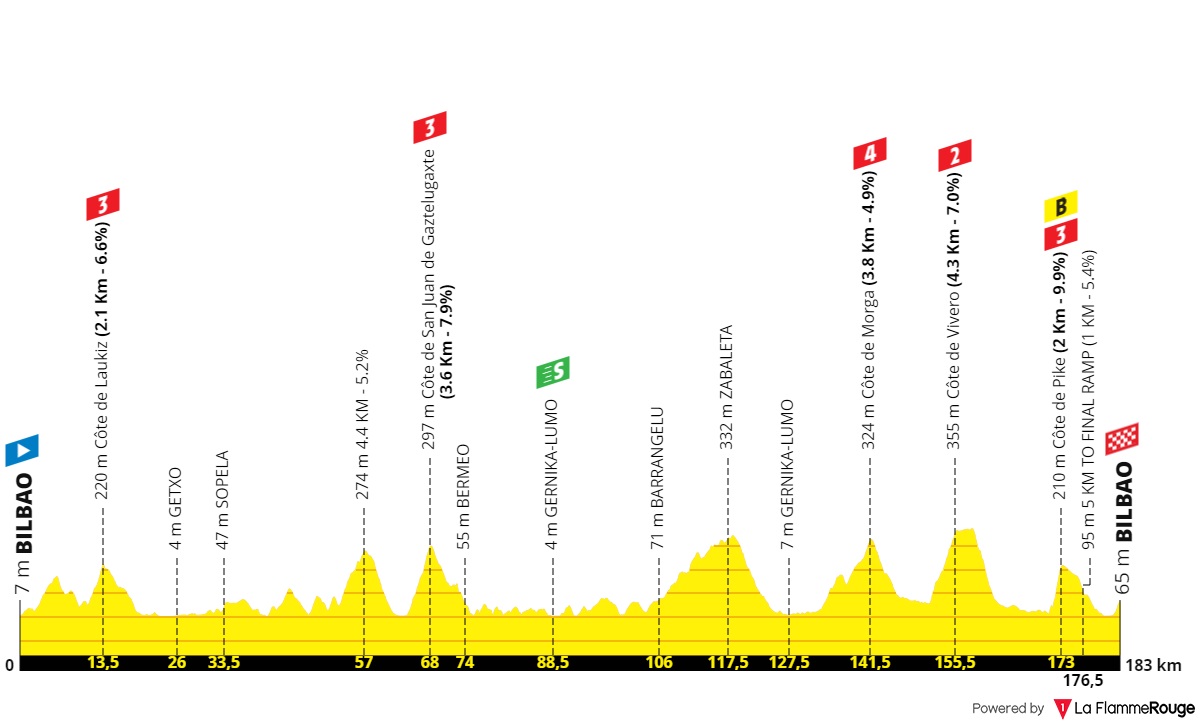
The Tour de France will start on one of cycling's sacred lands, the Basque Country. The opening day will have 183 kilometers in length and suit the puncheurs, and of course the climbers. It will be a day where the overall classification can be played, a different scenario to a Tour de France Grand Depart.
There are 3200 meters in altitude gain on this day, with a few hilltops right from the start. An interesting start to the day, which features five different categorized climbs. Over the second half the stage will have four ascents, those will be to Zabaleta, the Côte de Morga (3.8Km; 4.8%; 41.5Km to go) and the famous Alto de Vivero (4.3Km; 7.9%; 27.5Km to go) which will warm things up for the finale.
The decisive moment of the stage will be with no doubt the Côte de Pike. It is 2 kilometers long at 9,9%, a true Basque climb where the gradients go into 20%, expect massive and loud crowds all the way into the summit which is placed 10 kilometers to go - with bonus seconds at the top certain to make the race explode. The riders then have a slight descent back into the center of Bilbao, and later on the final kilometers has a 5.4% gradient, definitely a finale which will give the climbers better chances of succeeding. The first yellow jersey will be at hand in the finish line likely.

PREVIEW | Tour de France 2023 stage 1 - Pogacar, Vingegaard, van Aert, van der Poel and Pidcock among favourites for brutal opening stage
Stage 2: Vitoria-Gasteiz - Donostia San Sebastián, 210.1 kilometers
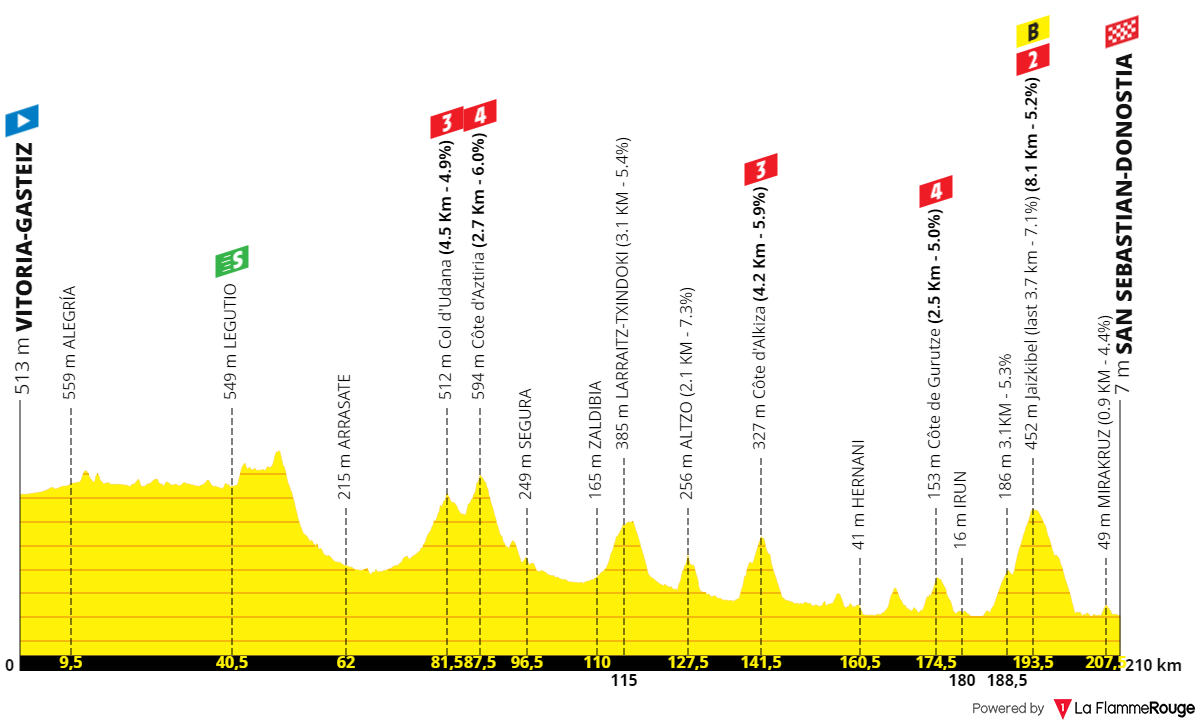
The second day of racing at the Tour de France won't be too different, only this time with a finale in Donostian San Sebastián. The decisive climbs of the Clasica San Sebastián won't be ridden, however the Jaizkibel will and will also be positioned relatively close to the finish. A more open second day, where climbers, puncheurs, rouleurs and sprinters all have a chance of succeeding.
A more flat start, however throughout the day there will be four categorized ascents - and a few others - before the main ascent of the day, which is likely to make it a bit more difficult for the sprinters. However that will be if the pace is pushed, otherwise most riders will get through comfortably. With 36.5 kilometers to go there is the Côte de Gurutze which is 2.5 kilometers at 5%, but then comes the biggest moment of the race.
Featuring 7.9 kilometers at 5.2%, it is a respectful climb, ridden in the opposite direction of what the riders face in the Clásica. A small 1 kilometer slight descent makes it a climb of two halves too, the final 3.7Km have 7.1% gradient. In all honesty, the climb will likely see minimum of 20 or 30 riders if the pace is pushed quite hard, but this is unlikely. A peloton of around 50 riders is expected, perhaps some can come back in the final descent.
The descent has a few technical sections, the climb ends with 16.5 kilometers to go and then the final 9 kilometers are flat. There is time to organize, there is also time to attack. There are few corners from there on all the way into the finish. With 3 kilometers to go comes a small rise which is 900 meters long at 4% which provides another spot to attack, but then the finishing straight will be flat.
PREVIEW | Tour de France 2023 stage 2 - San Sebastián hosts hilly finale where sprinters, climbers and classics specialists will all eye victory
Stage 3: Amorebieta-Etzano - Bayonne, 188.7 kilometers
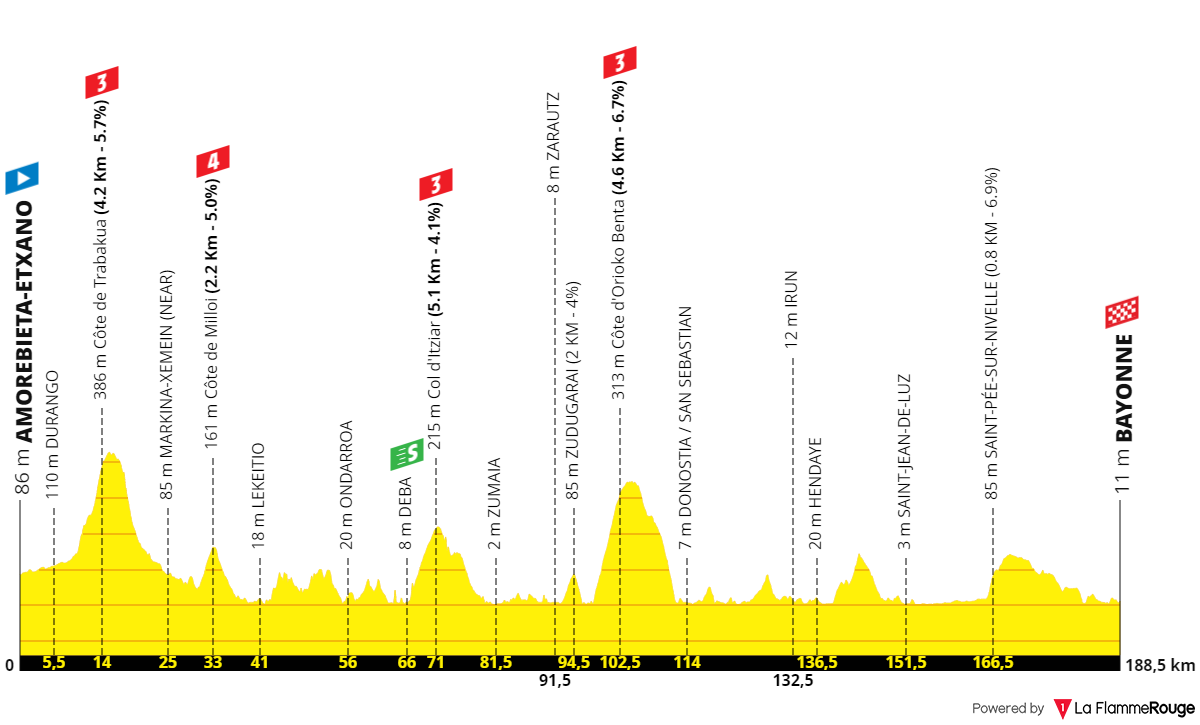
Stage 3 of the Tour de France will be the first for the pure sprinters, although it won't be a completely flat run-in into France and the coastal city of Bayonne. The start isn't the same however, starting in the Basque Country the riders face a 4.2 kilometers climb at 5.7% in the opening kilometers. The first half of the day features quite a few ascents, 4 categorized, making for a tricky day if some teams think of spinning a high gear there.
However it's unlikely that there will be teams spending bullets there purely for fatigue, as there won't be an alliance of many teams going all out for the last 102 kilometers. From there on it's a bit easier for the fast men, the final hilltop then comes with 20 kilometers to go, 3.3 kilometers at 4%. There is a slight chance the pace may be pushed there, but most likely the gradients aren't hard enough to drop anyone.
The riders then ride quickly into Bayonne for the first finale on French territory. It will be a tense finale with a roundabout coming with 2.4 kilometers and a long 180-defree corner just before 2Km to go, and then a sharp rise with a 200-meter ramp, followed by a small descent and slight corner into the final kilometer. There are a few moments to recover position still, the finale will be flat but with a slight left corner with 200 meters to go will make for a specific fight for position on the left side.
PREVIEW | Tour de France 2023 stage 3 - Philipsen, Jakobsen and Groenewegen headline first royal sprint battle
Stage 4: Daz - Nogaro, 181.2 kilometers
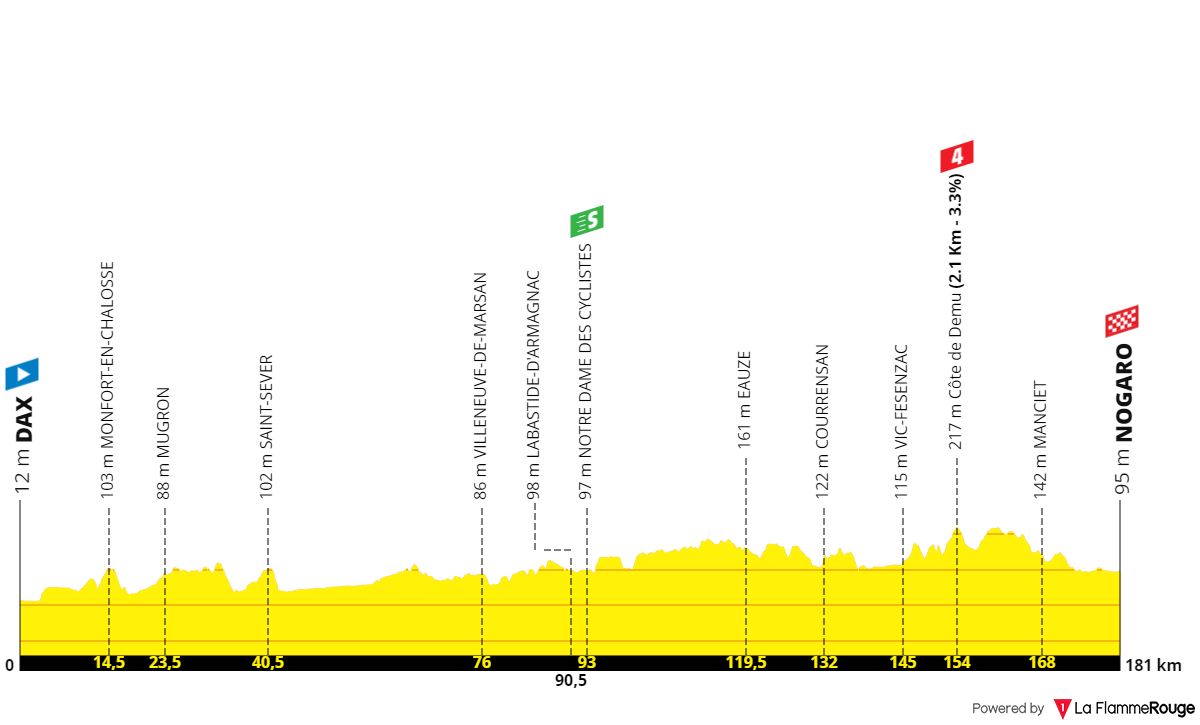
Stage 4 of the Tour de France will see the race head east. It will be a pure sprinter day from Dax to Nogaro, with no real difficulties, where the fast men will test themselves. It's a rather uneventful day profile wise, mostly a transition day through southern France.
The roads into Nogaro are open, non-technical and mostly with a regular flat tone. The finale won't be on public roads however, the riders enter the Circuit Paul Armagnac. You could say the finale is really technical looking at the map however this is a motorsport track, the roads are incredibly wide and the corners slight, there won't be breaking. It will be an interesting one to watch, the finishing straight will be 650 meters long and pan-flat.
PREVIEW | Tour de France 2023 stage 4 - Nogaro receives second bunch sprint
Stage 5: Pau - Lauruns, 163.8 kilometers
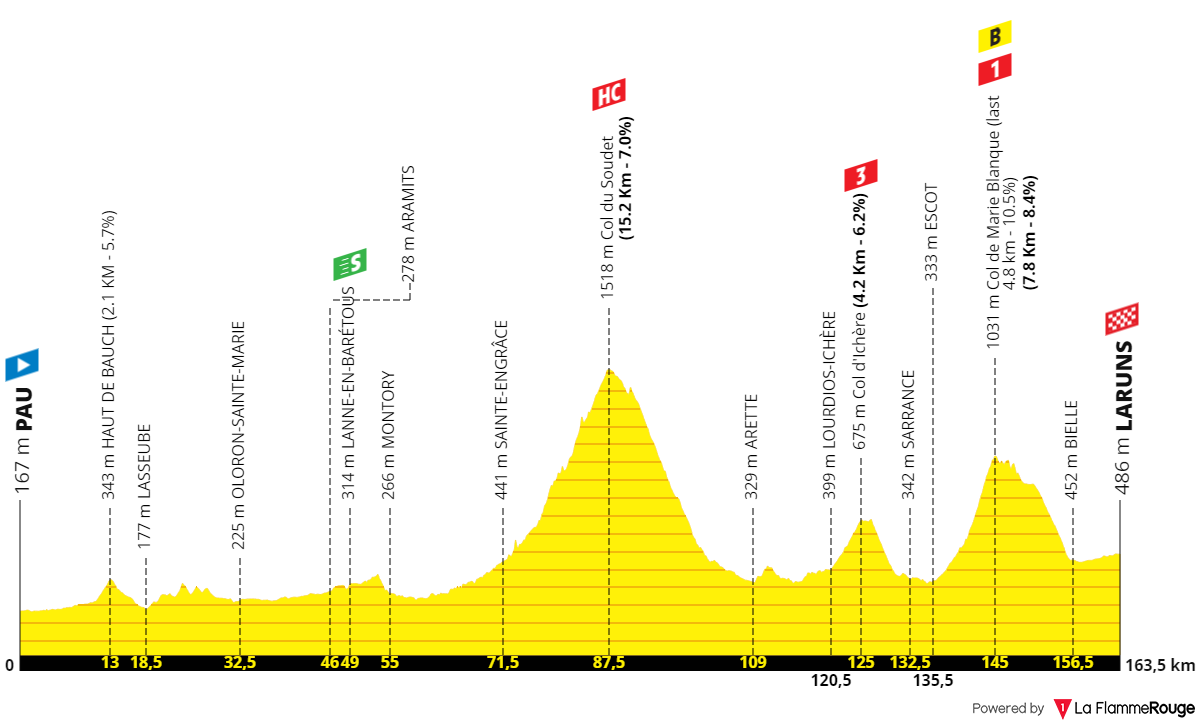
Stage 5 of the Tour de France from Pau to Lauruns will be the first high mountain day, in the Pyrenees. The Tour has opted for a different formula this year, a route for the pure climbers. Stages 5 and 6 will be a tough challenge with real mountains. As is always the case at the Tour, the start of a Pyrenean stage is flat, coming from the city of Pau which never misses the race.
Whilst usually the first mountain stage at the Tour is blocked, it should not be the case here, as the stage will feature the tough Col de Soudet (15.1Km; 7.2%). A very hard climb, it summits with 76 kilometers to go, the pace won't likely be pushed too much but nevertheless, with this toughness the peloton could lose a few riders.
After a long descent the riders find the Col d'Ichère as a transition, it's 4.2 kilometers long at 6.2% and will summit with 38.5 kilometers to go. A small - but technical - descent will lead into the Col de Marie Blanque.
This is the same finale as in 2020. The Col de Marie Blanque is a climb of two halves, very constant and a progressive rise of gradients. The final 4.8 kilometers average 10.5%, with only one hairpin. The first day in the mountains of a Grand Tour are usually very conservative, but on a climb like this differences can be made. The ramps are brutal, it's not a climb for big accelerations, but a tough pace will decimate the group.
The climb ends with 18.5 kilometers to go, and the descent will be quite technical, 11.5 kilometers long. Then the final 7 kilometers will be flat, there is time to close gaps, unlikely that gaps can be opened with serious damage, but as was the case in 2020 where Tadej Pogacar won his first Tour stage, it could be decided in a small group sprint.
PREVIEW | Tour de France 2023 stage 5 - First high mountain stage with Pogacar and Vingegaard as main favourites
Stage 6: Tarbes - Cauterets Cambasque, 145.4 kilometers
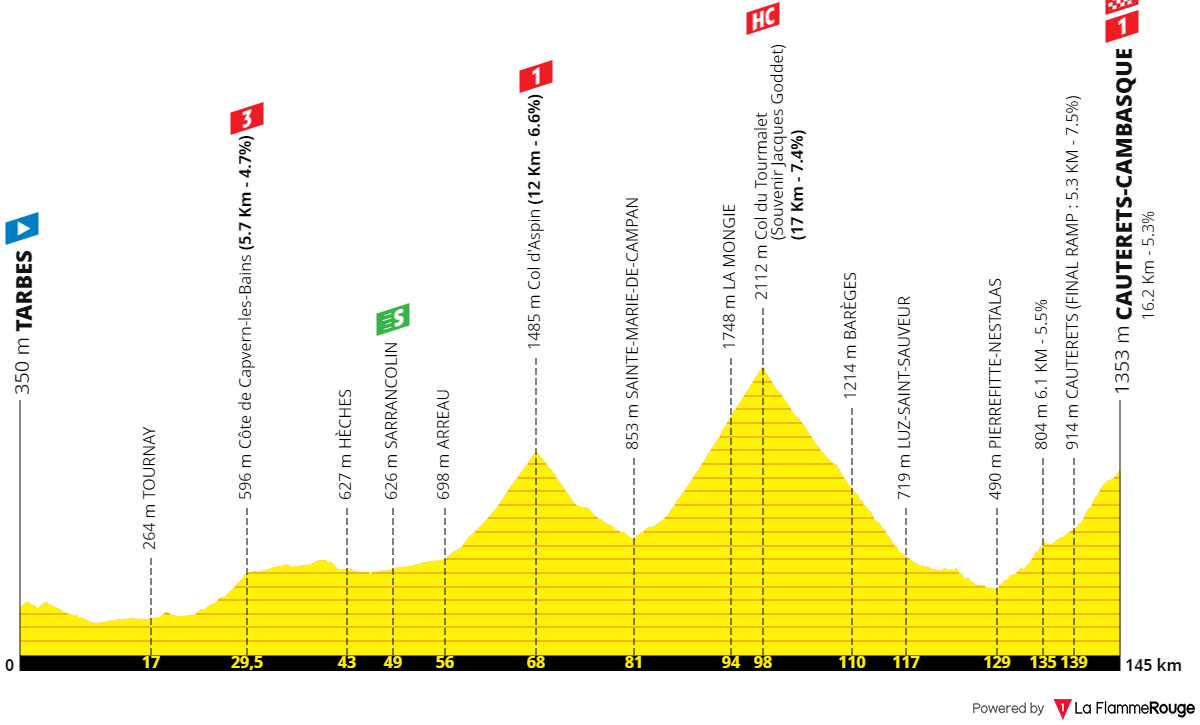
The second day in the Pyrenees at the Tour de France will see some more famous climbs on the menu. Perhaps a classical day, with plenty difficult climbs where differences can be made, but it will be all about the riders' attitudes. A short 145 kilometers with a flat start makes for an easy start to the day, the last 100 kilometers will be the ones where most of the action is expected.
That will start with the Col d'Aspin. It's 12 kilometers long at 6.6%, a warm-up for what's to come next, it summits with 77 kilometers to go but after a short the descent the riders are directly at the base of the Col du Tourmalet.
This is the toughest ascent of the day, a Tour classic - at this point, perhaps the most used climb in pro cycling. It will be climbed via Sainte-Marie de Campan it's 17 kilometers at a constant 7.4%, an ascent where the gradients never truly change much, it summits with 47 kilometers to go and the summit is at an altitude of 2112 meters.
After the descent into the valley the destination will be Cauterets-Cambasque, at the end of a very short stage. It will be at the end of a rough day so differences can be made, but with 16 kilometers at 5.4% it is unlikely to be an ascent with many serious moves within a normal race, however every mountain stage is an opportunity. In the final 5 kilometers there are a few ramps over 10% and it could see some action.
PREVIEW | Tour de France 2023 stage 6 - Jai Hindley's first day in yellow, Cauterets summit finish threatens new attack from Jonas Vingegaard
Stage 7: Mont-de-Marsan - Bordeaux, 169.8 kilometers
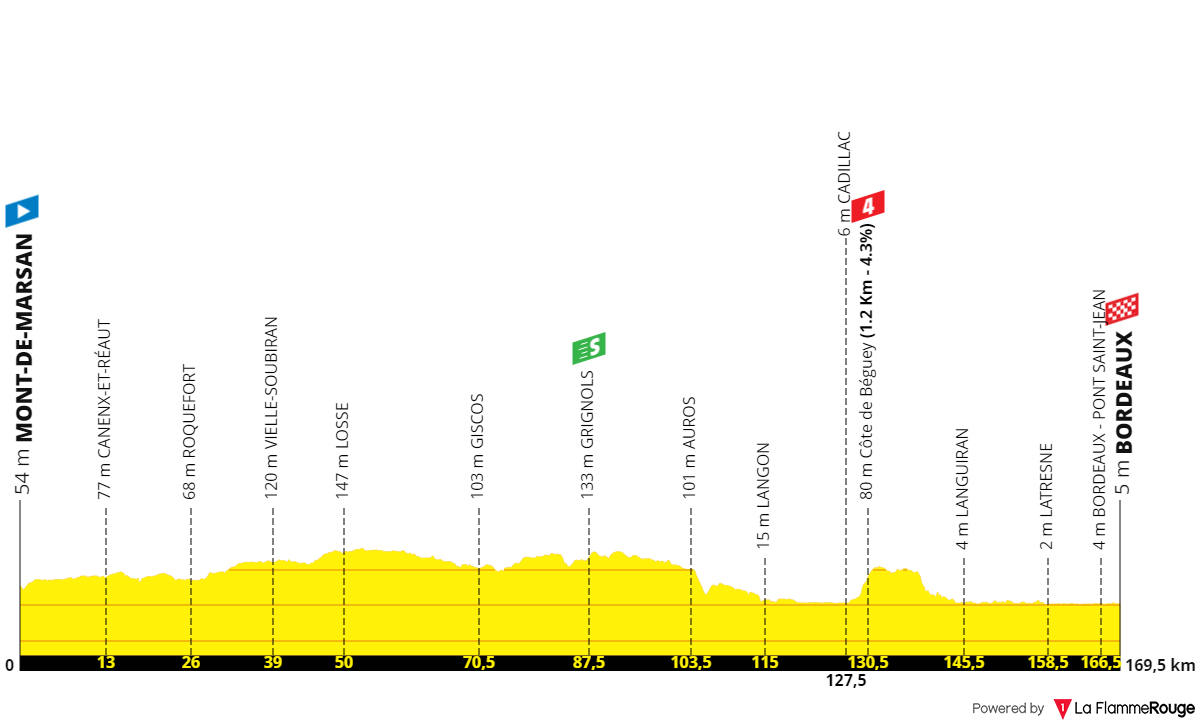
Stage 7 of the Tour de France sees the riders leave the Pyrenees and start heading north. The metropolitan area of Bordeaux receives the Tour de France back, for a stage that will be perfectly suited to the fast men. The first true transition day as the riders steer away from the mountains.
In all reality there isn't much to analyze from the day, other than a majority of pan-flat country roads which can be exposed to strong winds but there isn't much to it other than that. The riders will put all their attention into the finale.
It's not a technical finale however the riders head into the center of the city, speed and tension will be high among the urban environment. The final kilometers see the riders cross the river, but the final two kilometers will virtually be completely straight, only with a couple of roundabouts to stretch things out before the finish line.
PREVIEW | Tour de France 2023 stage 7 - Brutal heat and strong wind to make sprint day an all-out challenge
Stage 8: Libourne - Limoges, 200.9 kilometers
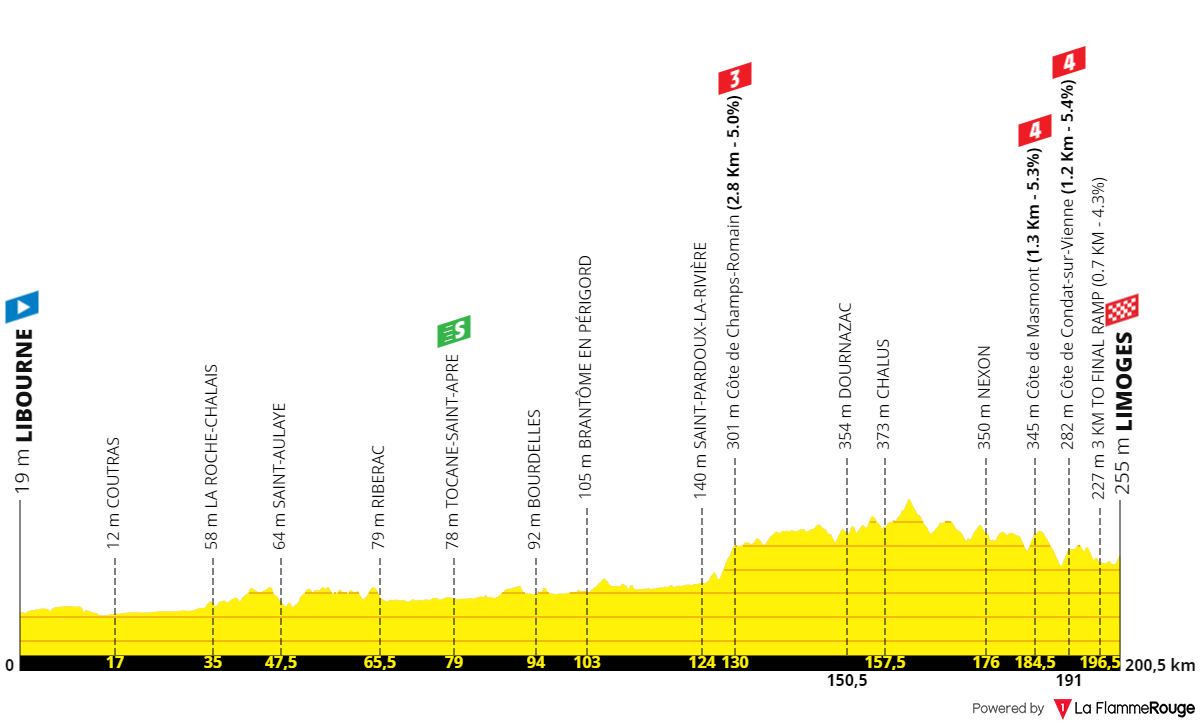
Now on stage 8 of the Tour the race moves to the northeast. It's a long day on the bike, one of the very few days that go over 200 kilometers. Another transition day with a pan-flat finale, however it will be a slight different finale.
It will all come down to that final hour of racing. A tough challenge, tension will be high and certainly the GC teams will swarm the front in an attempt to not be caught out, of both splits and possible crashes. The pace will go up, and in the final 50 kilometers there will be plenty small hilltops. It's a very rolling terrain, this is a day for the sprinters, but not a pure sprinter day. Some will be burnt throughout this hour of racing, some teams may push it too purposefully.
There are even two categorized climbs with 16 and 9.5 kilometers to go, they are 1.3Km at 5.3% and 1.2Km at 5.4%. You can tell, they are big-ring climbs, but they will be felt, and with descents inbetween all these hilltops the peloton will find itself in a constant change of speed.
The riders ultimately head into Limoges. It's not a very technical finale, but the challenge here will be the gradients. The riders turn into the finishing straight which is 700 meters long at 4.3%, not a pure sprint and it will spice things up, surely with many to try and surprise.
PREVIEW | Tour de France 2023 stage 8 - Van Aert and van der Poel favourites for hilly sprint
Stage 9: Saint-Léonard-De-Noblat - Puy de Dome, 182.8 kilometers
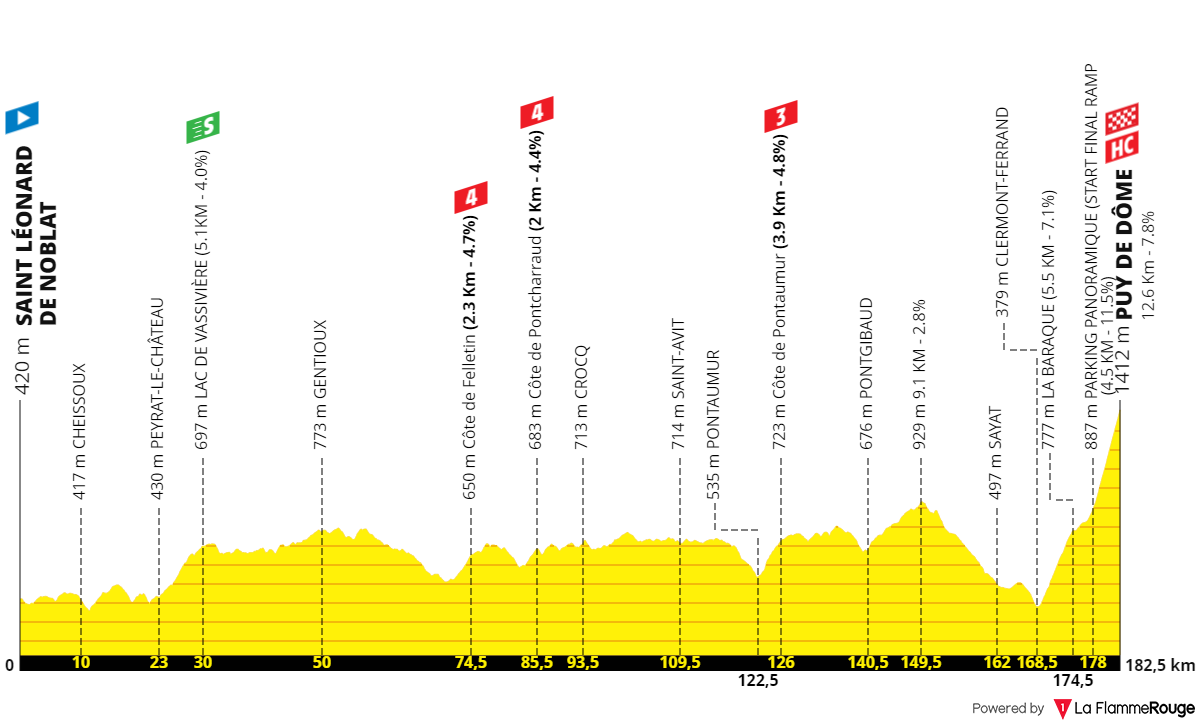
Stage 9 of the Tour de France will see the grand return of the Puy de Dôme climb, after 35 years of absence. The day will be mostly rolling, with only the final climb as a serious challenge. The riders arrive at the Massif Central, the day will be packed with small climbs however it will be all about that final climb. It will be hard and the first summit finish of the race, in a climb that will be quite a sight for the peloton.
The climb features a total of 13.3 kilometers at 7.7% However, the final 5 kilometers average out at around 11%, in an ascent that currently does not allow virtually any vehicles up the road, but will open an exception for the Tour de France.
All riders will with no doubt save their legs towards the final 5 kilometers, and this is another case of an ascent where you can't expect big accelerations, because indeed it is so constant that by far the most efficient way to get to the top is in a constant pace, and slipstreaming will mean very little. The end of the first week of racing.
PREVIEW | Tour de France 2023 stage 9 - Return to historic Puy de Dôme climb the first big challenge in yellow for Jonas Vingegaard
Stage 10: Vulcania - Issoire, 167.6 kilometers
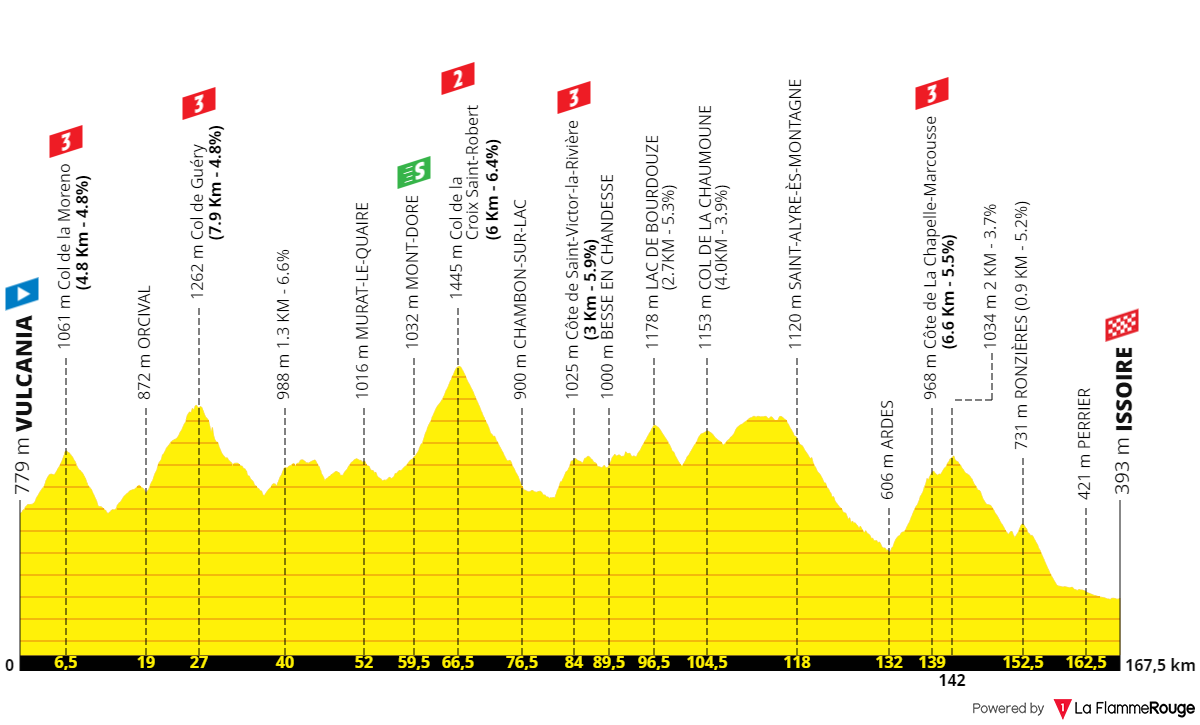
After the first rest day of the Tour de France, the peloton will have a hilly day through the Massif Central. This is a textbook breakaway day, with a hilly and roller-coaster start, and several climbs throughout the day. There will be almost no flat roads throughout the day, with the final (categorized) ascent summiting with 27 kilometers to go, before a downhill finish into Issoire.
Early in the day there are two ascents, with 4.8 kilometers at 4.8% and 7.9Km at 4.8% where the breakaway should be formed. From there on thee will be two more categorized climbs and tough rolling terrain. There are 3100 meters of climbing without one meaningful ascent, the stage's decisive attack can come at any moment, however it makes sense to look towards the final ascent.
This is the climb to the Côte de la Chapelle-Marcousse. The ascent is 6.6 kilometers long at 5.5% and summits with 28.5 kilometers to go. The climb doesn't end there however but two kilometers later, but from there on the road is almost completely downhill into Issoire and a solo attack almost impossible to bring back. he last 9.5 kilometers will be flatter but with a slight downhill tilt which means the speeds will be very fast all the way into the line.
PREVIEW | Tour de France 2023 stage 10 - Breakaway bonanza with Van Aert, van der Poel, Alaphilippe and Mohoric headlining
Stage 11: Clermont-Ferrand - Moulins, 179.8 kilometers
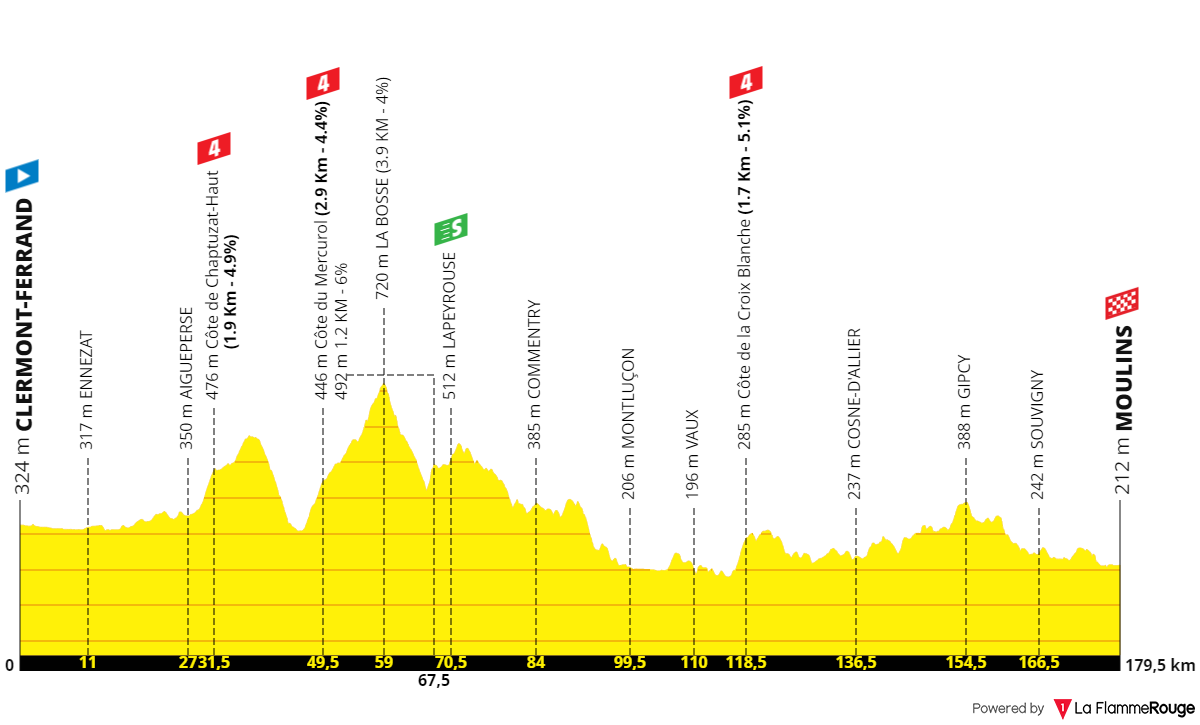
Stage 11 of the Tour de France will see a little bit of that rolling climb trend, but the start is flat, and the route into Moulins shouldn't be hard enough to prevent a bunch sprint from taking place. The stage will have two climbs early on which will make it a tad more difficult than the average day on the bike, one of the climbs being a 13.1-kilometer long climb at almost 4% average gradient.
Not one where the pace should be very high however, unless the breakaway is still being created. If so then there could be a strong group going up the road, the roads that follow won't ever be pan-flat, it's a rolling day in the Massif Central. There is a 1.7-kilometer hilltop at 5.1% which then summits with 61 kilometers to go.
The last 25 kilometers will be easier, with a bit of descending, it will be a fast run-up into town. The finale won't be too technical too, there isn't any corner where the riders will really have to break, there's a bridge crossing with 2 kilometers to go and then the finishing straight is 1.1 kilometers long.
PREVIEW | Tour de France 2023 stage 11 - After brutal day, sprinters find last opportunity before reaching Alps
Stage 12: Roanne - Belleville-en-Beaujolais, 169.3 kilometers
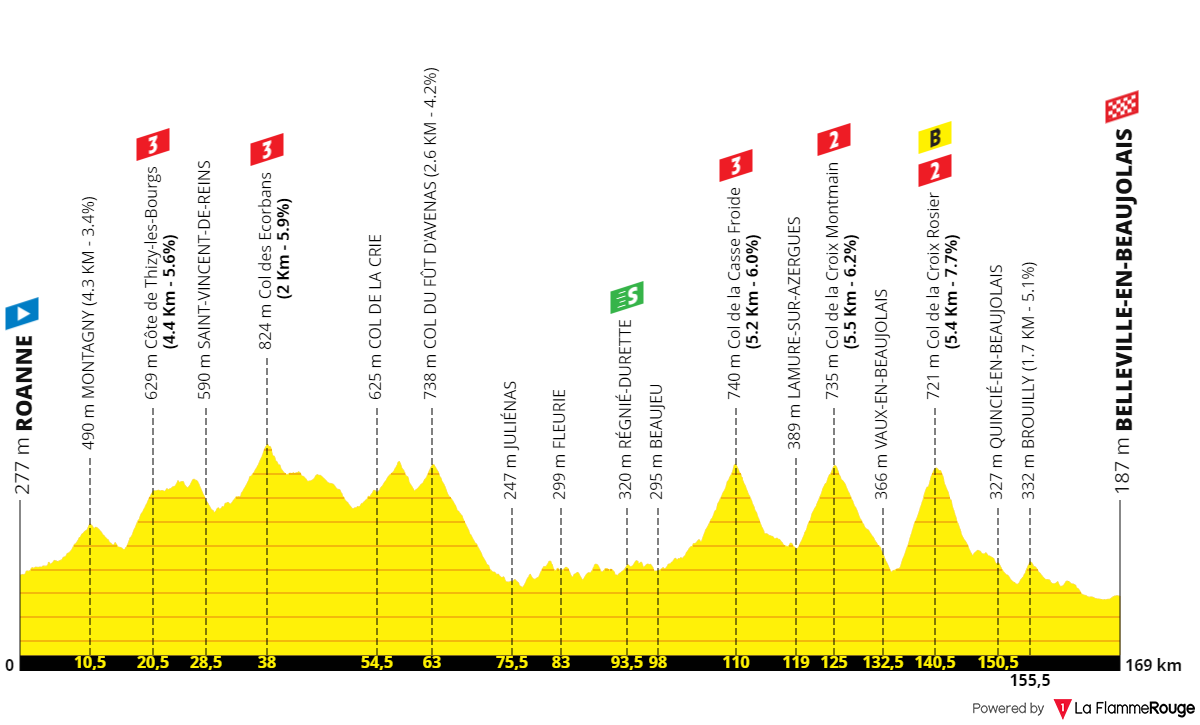
Stage 12 of the Tour de France is another day for the breakaway specialists. Climbers, puncheurs, time-trialists and classics specialists will come together on this day to pursuit the win on a day that is very difficult to predict. Whilst the rolling start will be quite complicated, the treble of ascents towards the finale in Belleville-en-Beaujolais will make it quite selective.
The first 63 kilometers have six climbs, none too hard, but definitely hard enough to see a group get away. There are two blocks of climbs here, it will certainly be an explosive start to the day and very open, many types of riders can make it through. A descent and flat section follows before the combo of climbs where the stage should be decided.
The first of the climbs is the Col de la Casse Froide which is 5.2 kilometers at 6% and summits with 59 kilometers to go. Then follows the Col de la Croix Montmain which is 5.5 kilometers at 6.2% which ends with 44 kilometers to go, and then finally the Col de la Croix Rosier which is the toughest of the three, 5.4 kilometers at 7.7% which ends with 28.5 kilometers to go.
All three climbs are not overly hard. They can see decisive attacks, and although the kilometers that follow include a lot of descent, going away alone does not guarantee a win. Attacks can happen early on, but there is also the option that some riders will wait for the last of the climbs to really go all-out.
The descent is slightly technical, there is then a small hilltop which ends with 14.5 kilometers to go, but then the last kilometers of the stage are more straightforward and the riders will have a trip through Belleville-en-Beaujolais, where they will find a flat sprint but a small finishing straight.
PREVIEW | Tour de France 2023 stage 12 - Hilly day promises more breakaway spectacle and traps for GC favourites
Stage 13: Châtillon-sur-Chalaronne - Grand Colombier, 138.3 kilometers
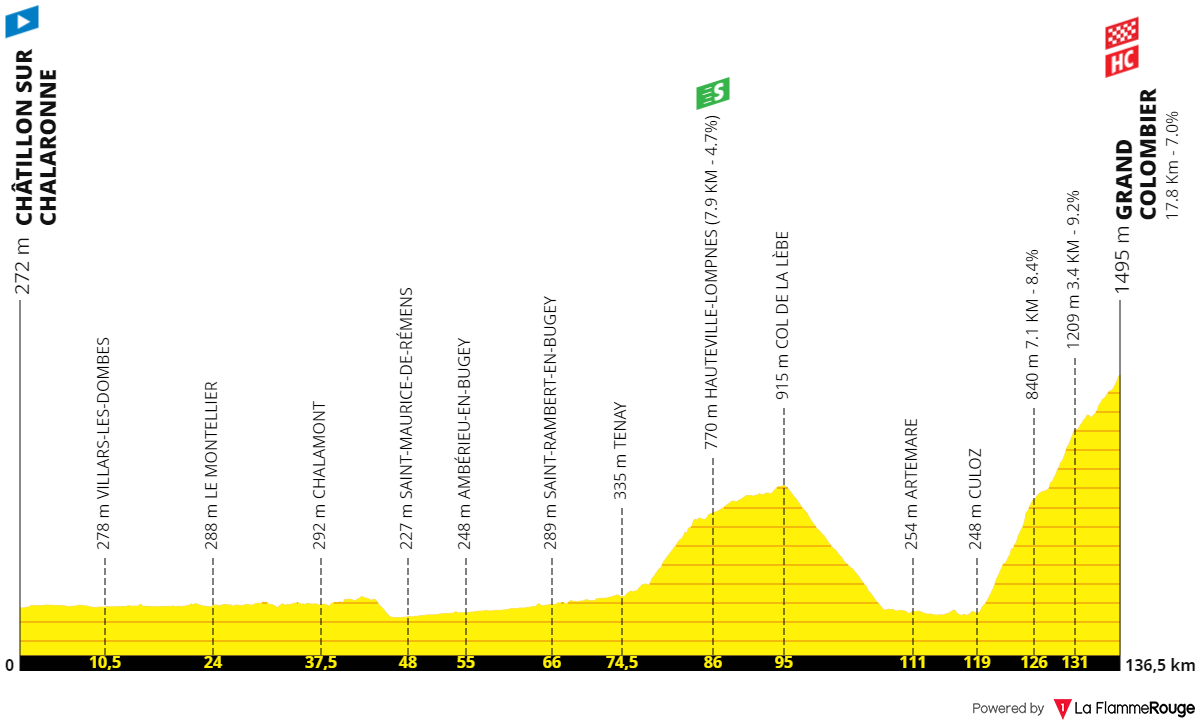
Stage 13 of the Tour de France will see the return of a colossal mountain. The queen of the Jura mountains, the Grand Colombier will host the finale of what is a very short day with a pan-flat start and little climbing beforehad. A short day on the bike, the whole first 75 kilometers are very simple and will pass quite fast.
The riders then go over the Col de la Lèbe, it is 17 kilometers long but the second half essentially a false flat, the whole ascent averaging around 3%. The riders do face a steeper descent which leads the riders into the final 29 kilometers. The riders pass through Culoz and then start the ascent, passing by the Lacets du Grand Colombier, one of the most scenic spots in the Alps.
It will all come down to the climb, which features 17.4 kilometers at 7.1%, featuring many switchbacks, some gradient inconsistencies and a steep finale to kick off the second block of mountain stages. The ascent is hard from the start, it features a few restbite sections but with 7% average gradient, it's quite telling that the tough uphill sections frequently go above 10%.
PREVIEW | Tour de France 2023 stage 13 - Pogacar and Vingegaard battle for yellow jersey at Grand Colombier
Stage 14: Annemasse - Morzine, 152.5 kilometers
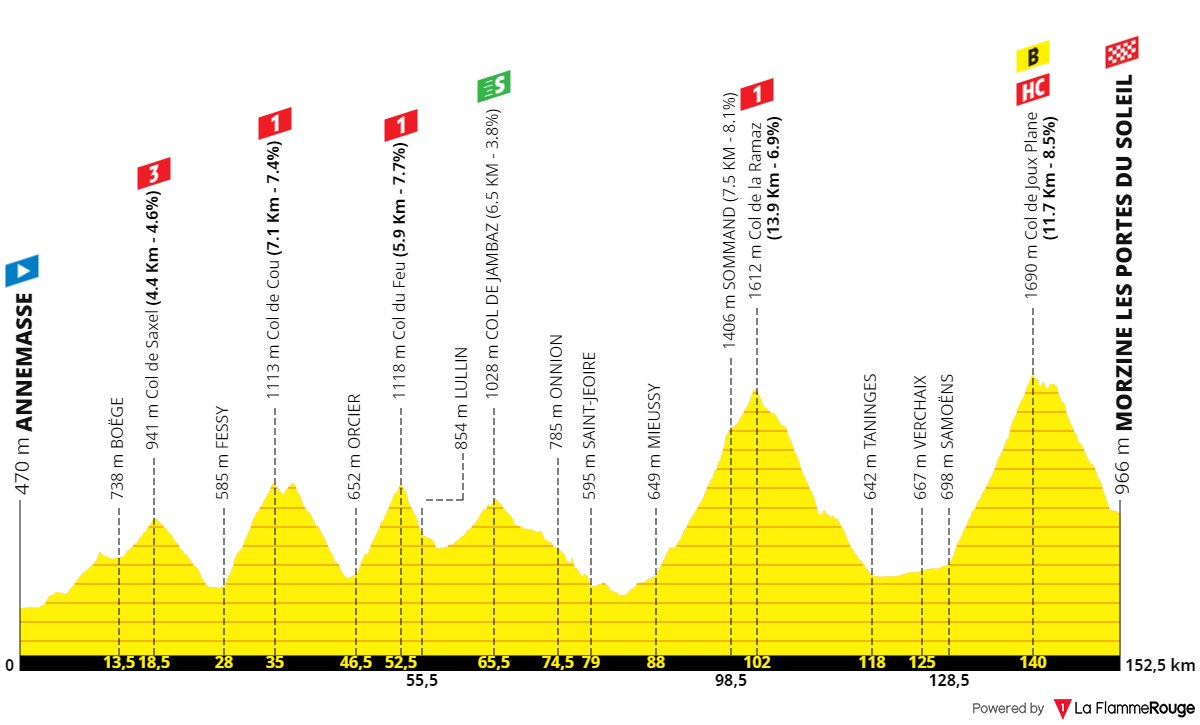
Stage 14 of the Tour de France will be one of the hardest stages of the race, featuring four ascents early in the day where the race will stabilize. It is another short stage, but one where differences can be made. The start of the stage features three categorized climbs with 4.4Km at 4.6%, 7.1Km at 7.4% and 5.9Km at 7.7%. The intermediate sprint is then also atop the Col de Jambaz which is 6.5Km at 3.8%. A proper day of constant up and down.
The Col de la Ramaz (13.9 kilometers; 7.1%) will be a warm-up to the final climb of the day. It's a really tough one, not as constant as the final one but it features harsher gradients in some phases. This climb will summit with 50.5 kilometers to go, the descent that follows is steep. Then come almost exactly 10 kilometers before the final ascent of the day.
This will be the Col de Joux Plane (11.6 kilometers; 8.5%), before a descent into Morzine. This is a traditional Tour finale, one that frequently sees no differences between the favourites, but the stage provides the opportunity to create them. The climb is quite constant, it's steep and comes at the end of a hard mountain day. It has everything in theory to make big things out of it.
There is a small plateau section before the descent, which will be rather steep and technical, another tense challenge before the final kilometer inside Morzine, where the finale will be narrow and on some slight uphill gradients.
PREVIEW | Tour de France 2023 stage 14 - 9 seconds separate Tadej Pogacar and Jonas Vingegaard into brutal multiple-climb stage
Stage 15: Les Gets - Saint-Gervais Mont Blanc, 180.1 kilometers
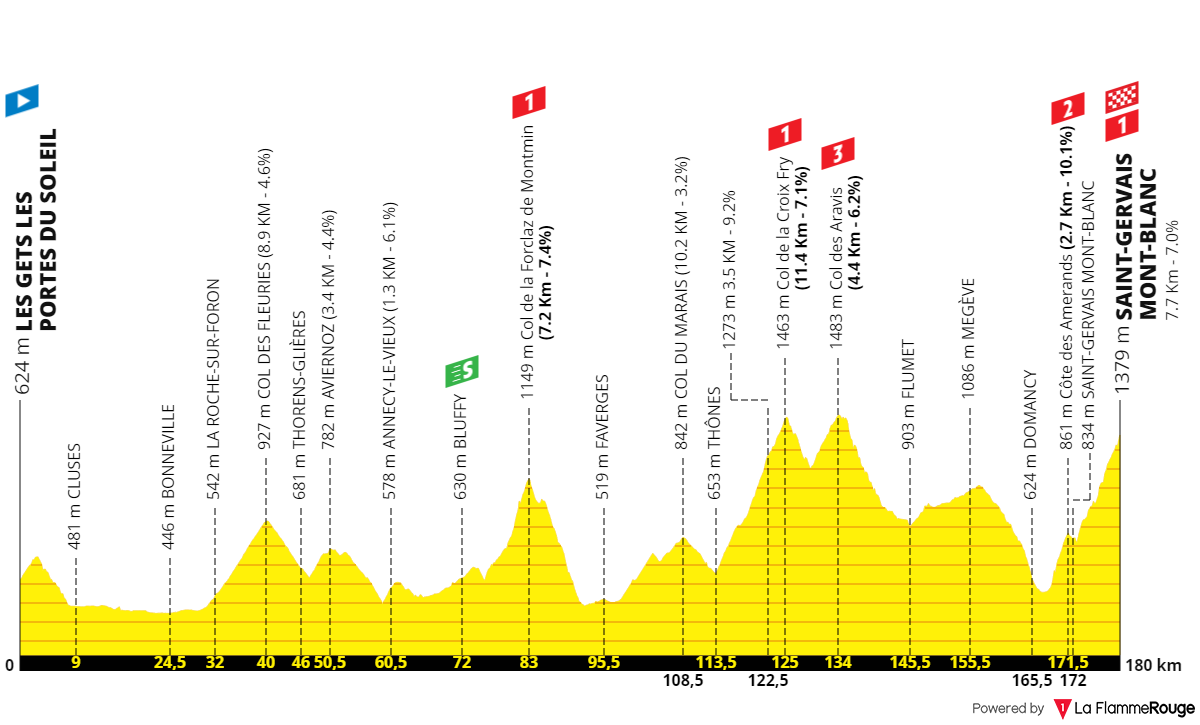
The final day of the second week of the Tour de France will be another explosive Alpine day. A longer one, it starts in Les Gets Les Portes du Soleil with a small uphill. It will be an explosive day, the start rather uncertain, the 4500 meters of climbing on the day and the breakaway could go off in the Col des Fleures which is 8.9 kilometers at 4.6%. There will be the 1st category Col de la Forclaz de Montmain which is 7.2Km at 7.4% and will set some more damage in the field.
It won't be as tough of a start, but the middle of the stage will be very complicated, specially with the presence of the Col de la Croix Fry (11.3Km; 7%), this ascent summits with 55 kilometers to go, the climb features very tough gradients and will be hard to get through. Directly after the summit is a short descent and then the Col des Aravis which is 4.4 kilometers long at 6.2%.
The action should be saved towards the end however. Straight from a steep descent the riders enter the steep Côte des Amerands, 2.7 kilometers at 10.1% which summit with only 10 kilometers to go. A very short descent sees the riders in the center of Saint-Gervais-les-Bains where they'll start the final ascent to Le Betex, 7.2 kilometers at 7.7% which will make for an explosive finale.
A slight transition phase will follow, two descents separated by a plateau. both are very technical. Back in 2016 Romain Bardet and AG2R took advantage of it to split the peloton before the final climb itself. The climb to Le Bettex will be hard, and explosive. The first kilometers (with a GPS error in the profile below) average 10% for 2.7 kilometers.
There is a small descent and then follows the final uphill, this will be 7.7 kilometers at 7% including many switchbacks, an explosive ascent. The final ramp will be steep, differences can be created here in what is the final day of the second week.
PREVIEW | Tour de France 2023 stage 15 - Perfect balance for Jonas Vingegaard and Tadej Pogacar, only 10 seconds decide yellow jersey
Stage 16 (ITT): Passy - Combloux, 22.4 kilometers
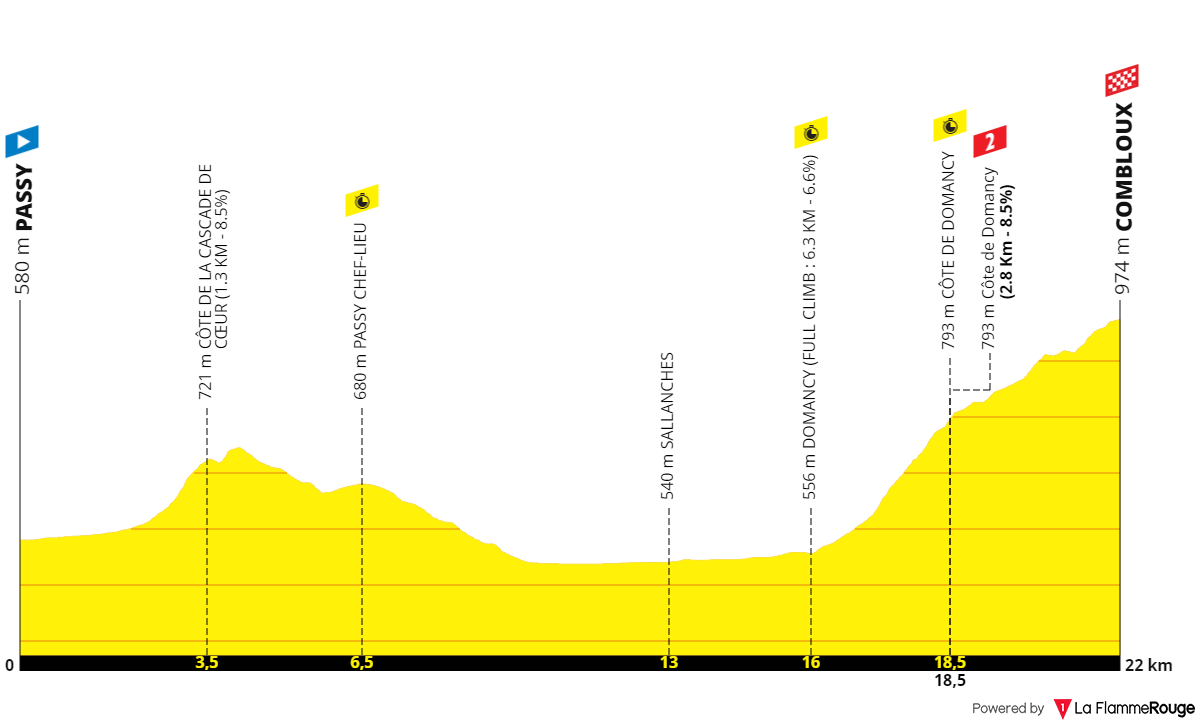
The first day of the final week of the Tour de France and one which everyone has talked about. The only individual time-trial of the 2023 Tour de France, featuring only 22 kilometers in distance. Early on in the effort the riders will climb the Côte des Soudans (1.3Km; 8.8%) and descend back into the valley. The intermediate point will be at 6.5 kilometers, the descent will be fast and not really technical, high speeds will be reached.
This will be a day for the GC riders once again, and the differences will be important. The riders will climb the Côte de Domancy (2.7Km; 8.9%) that finishes with only 3.5 kilometers away from the finish, and continue on an uphill drag into Combloux where they will meet the finish line. The climb in reality is 6.3 kilometers at 6.6%, the TT will suit the climbers and GC riders, with intermediate points at the base and top of Domancy.
PREVIEW | Tour de France 2023 stage 16
Stage 17: Saint-Gervais Mont Blanc - Courchevel, 166.4 kilometers
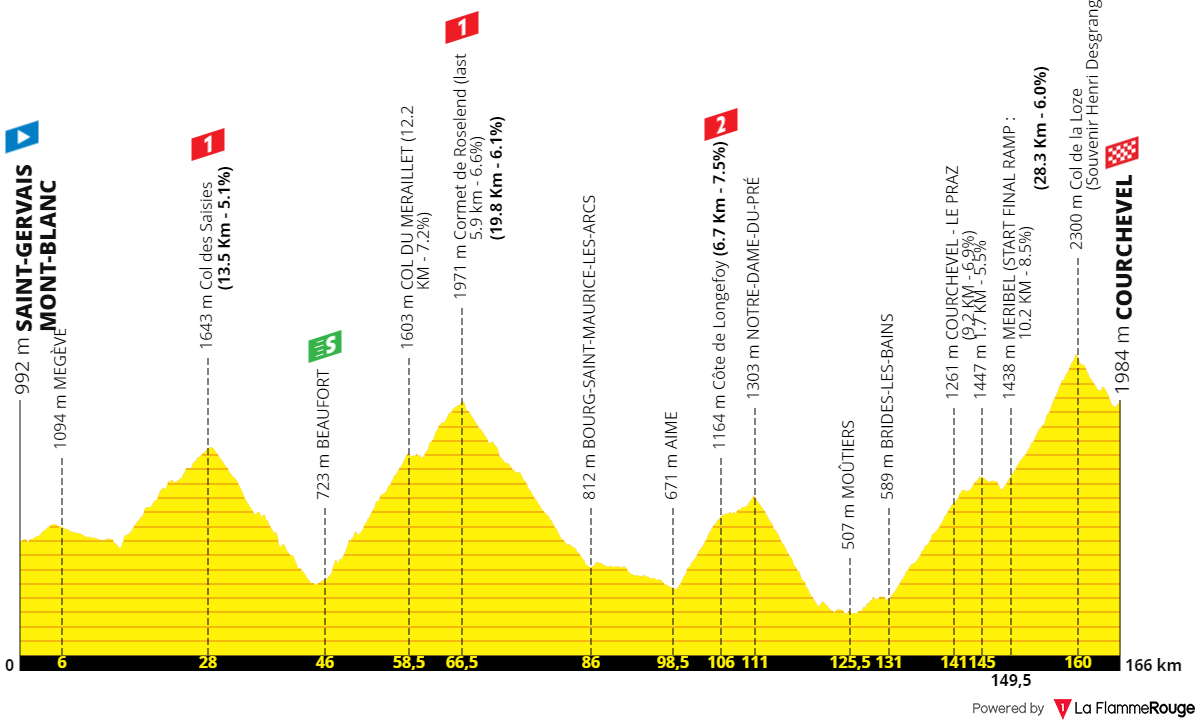
Stage 17 of the Tour de France is perhaps the queen stage of the race. A brutal day in the mountains featuring 5400 meters of climbing. The start is rather flat, but features in it's early parts the Col des Saisies (13.3Km; 5.3%). It will take a few kilometers for the riders to reach it, but the breakaway certainly will go up the road here.
This could very well be considered the queen stage, it's the stage that features the most climbing meters and what is considered the toughest (and highest) ascent of the race. The Cormet de Roseland (19.9Km; 6.1%) follows, a long climb with it's summit at almost 2000 meters of altitude and summiting with 99.5 kilometers to go.
Afterwards the riders will ascent the Côte de Longefroy (6.6Km; 7.5), but all of that will be a warm-up to the final ascent. The descent is extremely technical, although it may be considered the "easiest" climb of the day, the race to the summit will be real as all riders will want to be in the front for it.
After a valley run the riders will ascend to the outside of Courchevel, climbing around 14 kilometers at 6% before a small flat section. The final 10.2 kilometers have 8.5% average gradient and will take the riders all the way up to the Col de la Loze at 2304 meters of altitude, and gradients of up to 20% near the finish. It is similar but not the exact same climb that was ridden in 2020, the difference being it's earlier. It will host the Souvenir Henri Desgrange at the summit, an horrific ascent.
The summit will be placd 6.5 kilometers away from the finish, with a short descent which will be fast leading to the Courchevel altiport, still with a hilltop finish that will see ramps of up to 18% on the road. Big gaps won't be made there, but certainly some seconds could be gained or lost, as well as making for a very scenic finale.
PREVIEW | Tour de France 2023 stage 17
Stage 18: Moûtiers - Bourg-en-Bresse, 185.4 kilometers
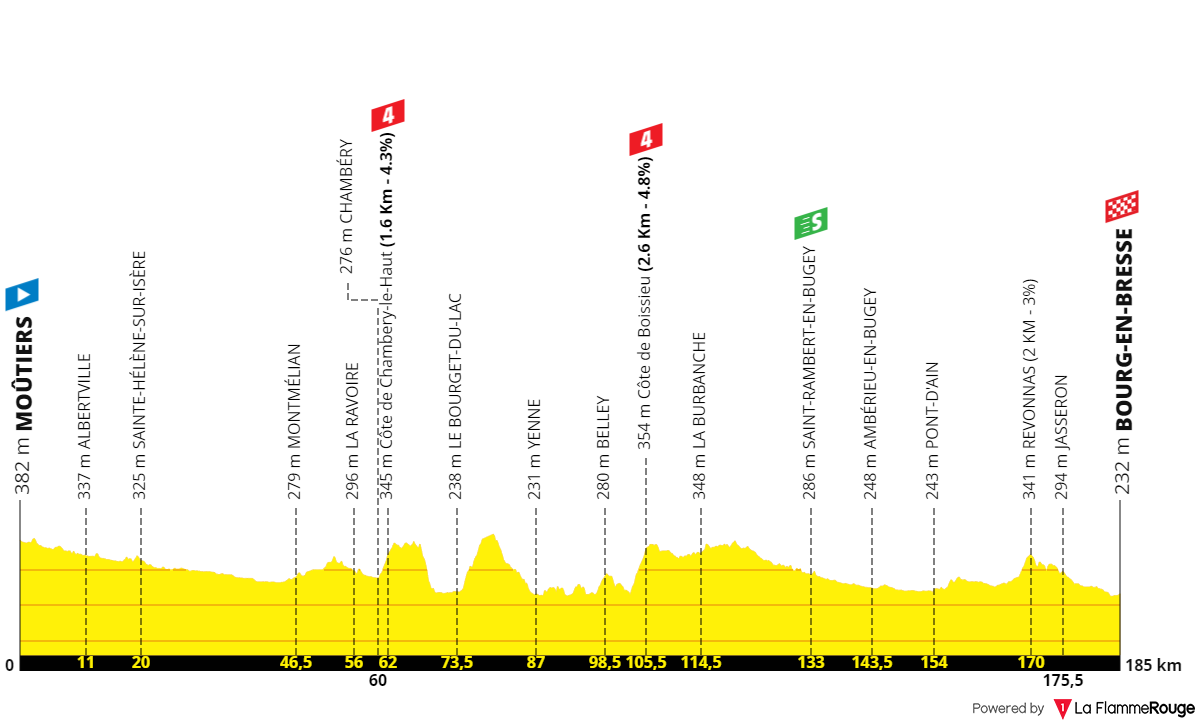
Stage 18 will see the riders say goodbye to the Alps. They'll be heading north, and a stage between Môutiers and Bourg-en-Bresse will be a reward for the sprinters who got through the main mountains of the race.
The day is rather simple and without too much to analyze. There are a few hilltops in the middle section of the stage, however none are too difficult and should see the teams pushing the pace. The final 80 kilometers are flat, without any meaningful ascent.
It will all come down to the sprint. There will be roundabouts with 4.7, 3.3 and 2.6 kilometers to go. It will be fast into the 1.5-kilometer mark where there will be a sharp left hander, around the 1 kilometer mark the riders turn right slightly, the final 800 meters will be the final straight on flat roads.
PREVIEW | Tour de France 2023 stage 18
Stage 19: Moirans-en-Montagne - Poligny, 173.4 kilometers
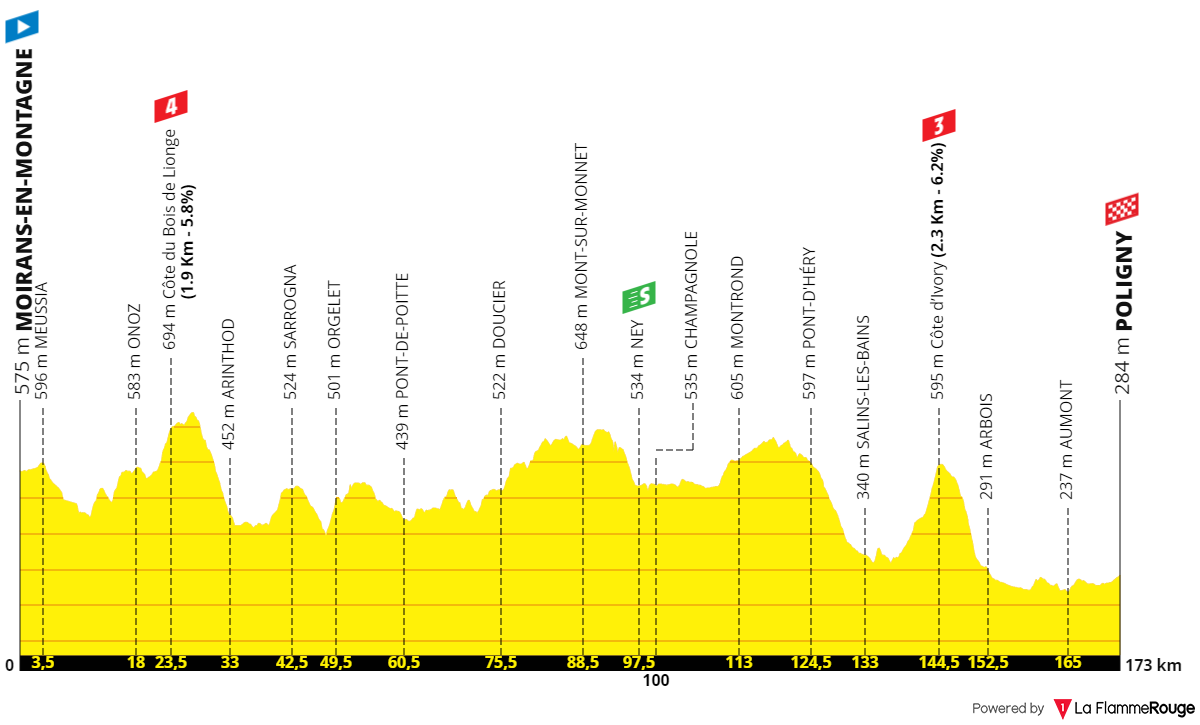
Stage 19 of the Tour de France will be a rolling and tricky day. On paper one for the sprinters, however there is space to surprise on what is one of the final days of racing, specially as the start is hilly, there are a few hilltops and at this point in the race many riders may want to attack.
The riders will face the Côte d'Ivory (2.3 kilometers; 6.2%) less than 30 kilometers of the finish line where some sprinters may find difficulties. It isn't a tough climb but there sure is the space to make some damage, the climbs is then followed by a fast descent and the run-up to the line.
This will be the most simple one of the entire race. No technical features whatsoever, the final few kilometers are completely straightforward and will provide no challenge to the riders, it will all be up to positioning and timing. The final kilometers will have a slight uphill tilt into Poligny.
PREVIEW | Tour de France 2023 stage 19
Stage 20: Belfort - Le Markstein, 133.5 kilometers
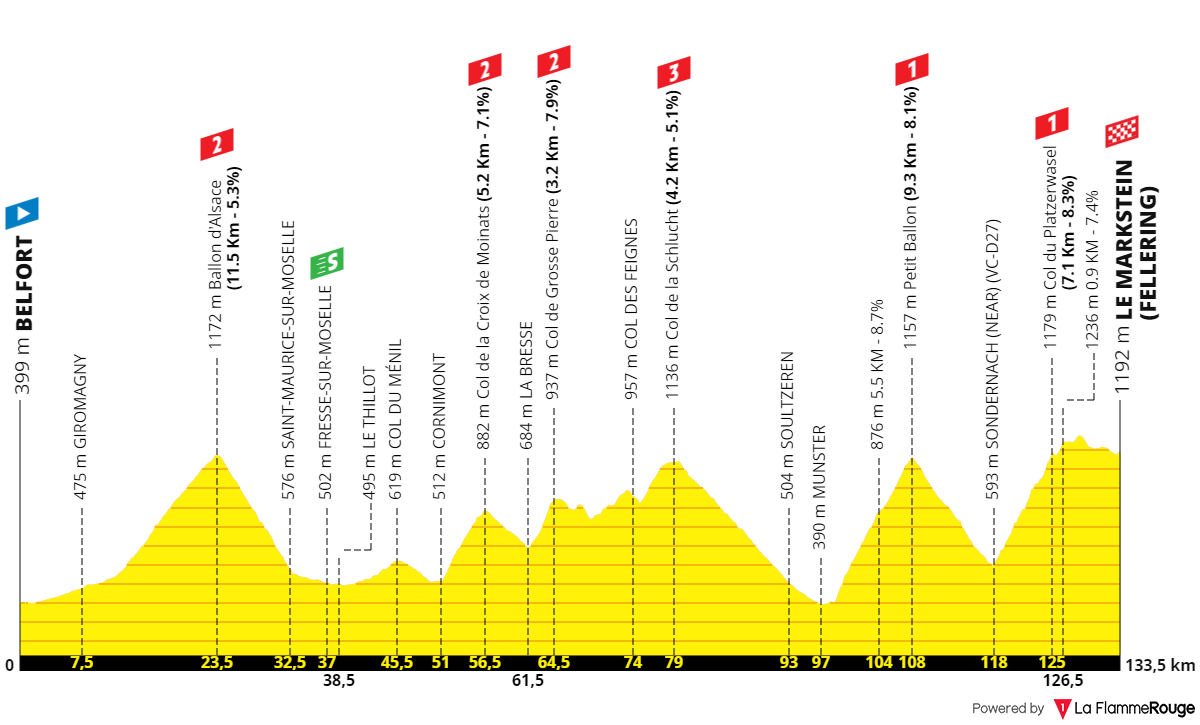
The final mountain stage of the Tour de France takes the riders into the Vosges for a short but very explosive day. The race is not over yet, and a lot can be done in these 133 kilometers which feature 3400 meter of climbing, in the terrain that decided the Tour de France Femmes last year. The Vosges are the final mountain range to be tackled and this difference in terrain could be race changing.
The Ballon d'Alsace (11.5 kilometers, 5.3%) will open things up for the day, and the middle section of the stage will see several hilltops and descents, hard terrain to control. It will all lead to a final combination of climbs however. The ascents summits with 110 kilometers to go, it's the first of many.
There will then be four hilltops, three categorized, but fatigue will build up throughout these, and attacks may come. The toughest of which is the Col de la Croix de Moinats which is 5.2 kilometers at 7.9%. This will however be largely a transition section.
The stage is to be decided on the final two climbs. Petit Ballon (9.3Km; 8.1%) will provide terrain to attack seriously, summiting with only 24.5 kilometers to go. It is steep and has the distance, the final climb is not harder and being the final opportunity, serious moves may come here.
The riders will only have a very short and fast descent before the final climb of the race which is the Col du Platzerwasel, 7.1 kilometers at 8.4% which summit very close to the finish at Le Markstein, to conclude the battle for the yellow jersey. The summit of the climb comes with 7 kilometers to go, from there on the riders follow a plateau into the finish.
PREVIEW | Tour de France 2023 stage 20
Stage 21: Saint-Quentin-en-Yvelines - Paris Champs-Élysées, 114.8 kilometers
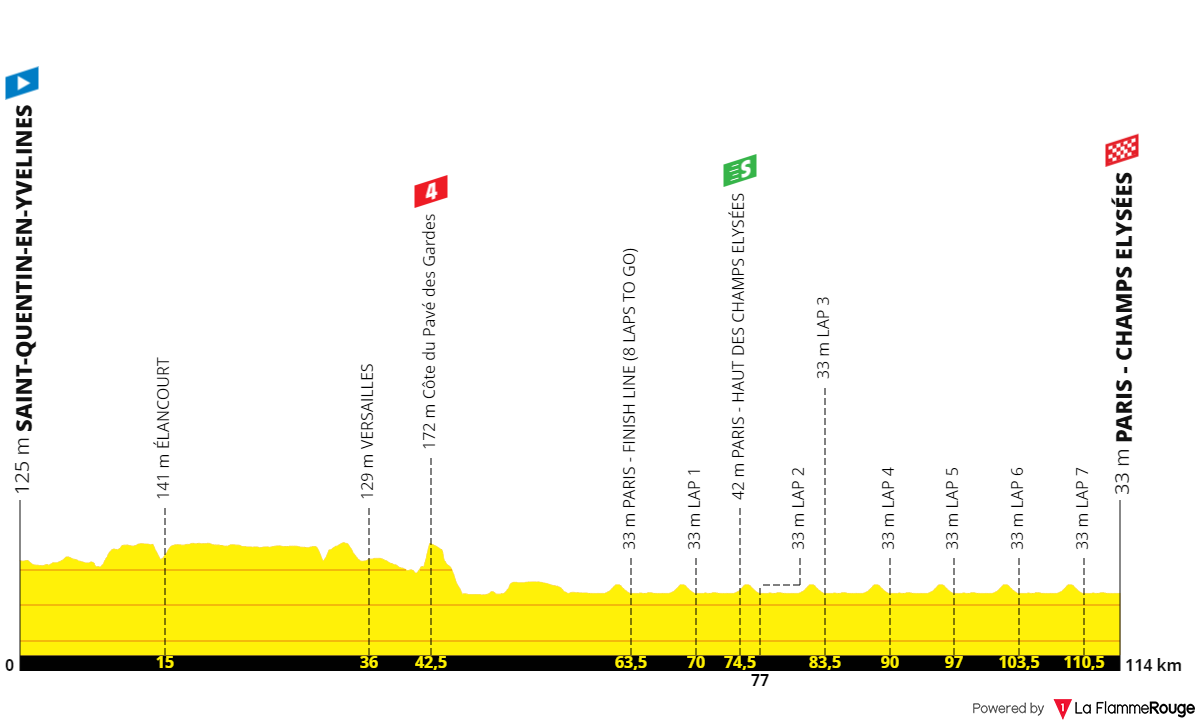
The final day of the Tour de France, at long last. Short, flat and with sight on the Champs-Élysées where the riders will finish the Tour de France. The start will take place in the velodrome of Saint-Quentin-en-Yvelines which hosted the 2022 Track World Championships.
The finale is what we know it to be every single year. An iconic moment, the final roads the Tour will race through. It is not the easiest of sprints, with the final chicane coming with 350 meters to go, and the Champs-Elysées featuring some smooth cobbles which comes as a bit different of a sprint.
PREVIEW | Tour de France 2023 stage 21
Read more about:, place comments.
You are currently seeing only the comments you are notified about, if you want to see all comments from this post, click the button below.
Confirmation
Are you sure you want to report this comment?
UNDER_ARTICLE
Sat 30 Mar 2024

- Free ground shipping on select bikes
- Financing as low as 0% APR with Affirm
- FREE SHIPPING - LIMITED TIME | Shop In-Stock Bikes
- DELIVERY & ASSEMBLY BY VELOFIX
- AFFIRM FINANCING AVAILABLE
Tour de France 2023: Route, stages and TV
Find out more about the tour de france 2023 with our guide including the routes, stages and how to watch on tv..
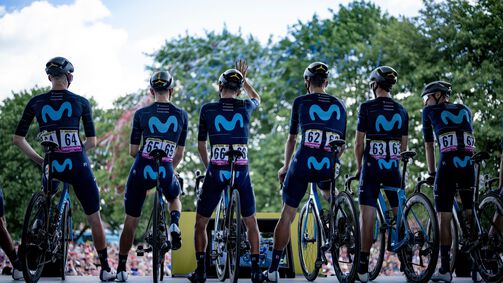
We usually start getting excited for the next edition of the Tour de France approximately one hour after the current Tour finishes. This year was no different and we're now eagerly looking ahead to the 2023 Tour de France.
The official route announcement occurs in October every year at the Palais des Congrès convention centre in Paris. Stars of previous editions of the race don their Sunday best to watch the Route Director Christian Prudhomme unveil the next route.
Tour de France 2023 in numbers:
- Total distance: 3404km
- 2 countries
- 25 departments
- 5 mountain ranges (Pyrenees, Massif Central, Jura, Alps and Vosges)
- 4 summit finishes
- 30 categorised climbs – a record for the race
When is the Tour de France 2023?
Where is the tour de france grand départ, tour de france route, how to watch the tour de france 2023.
The 2023 Tour de France will take place from Saturday 1 July 2023 until Sunday 23 July 2023.
The first 3 stages of the 2023 Tour de France will take place in the Basque Country of northern Spain.
This isn't the first time the Basque Country has hosted the Tour. The 1992 Tour de France Grand Départ was held in San Sebastián. This time, Bilbao will be the 2023 host of the Grand Départ with the city the backdrop to the opening stage.
The opening 3 stages will be held around Bilbao and its nearby towns and cities.
The Tour de France is made up of 21 stages across 3 weeks of racing. Within those 3 weeks, there are 3 rest days. At the end of the 3 weeks, we'll find out the winners of the prized Tour de France jerseys .
Tour de France 2023: Stage 1
Bilbao - bilbao | 185km | hilly.
The first stage of the Tour de France 2023 takes places along the streets of Bilbao. The 185km street circuit features plenty of signature Basque hills and will suit the more explosive and aggressive riders of the peloton.
Though there are many ramps and peaks that pepper the route, just 5 classified climbs count towards the King of the Mountains (KOM) competition:
- Côte de Laukiz: 2.1km long with an average gradient of 6.6%
- Côte de San Juan de Gaztelungaxte: 3.6km at an average of 7.7%
- Côte de Morga: 3.8km with an average gradient of 4.8%
- Côte de Vivero: 4.3km at 6.9%
- Côte de Pike: 2.2km at 9.9% gradient
Tour de France 2023: Stage 2
Vitoria-gasteiz - san sebastián | 210km | hilly.
A 210km route from Vitoria-Gasteiz to San Sebastián awaits riders for the second stage of the 2023 Tour de France. It's yet another route punctuated with hills as is customary for this region of Spain.
Another 5 classified climbs will ensure a busy day for the rider leading the KOM competition:
- Côte d'Udana: 4.7km at 4.7%
- Côte d'Aztiria: 2.8km at 5.9%
- Côte d'Alkiza: 4.1km at 6.1%
- Côte de Gurutze 2.6km at 6.1%
- Jaizkibel: 6.9km at 6.2%
As the summit of the final climb is just 17 kilometres from the finish, we expect the race to light up on the slopes up and down to the finish. If a lone rider attacks on the ascent, this stage could be as good as won at the peak.
Tour de France 2023: Stage 3
Amorebieta-etxano - bayonne | 185km | flat.
Four climbs this side of the Spanish border will sort the best from the rest:
The race crosses on to home soil shortly after these climbs. Once in France, teams will have the chance to assemble their sprint trains ready for a fast finish in Bayonne.
Tour de France 2023: Stage 4
Dax – nogaro | 182km | flat.
The first stage on home soil after the Basque Country Grand Départ will take place between Dax and Nogaro. While the course creates a prime opportunity for a breakaway group, the finish line on the Nogaro motor racing circuit has a sprint finish written all over it. As the 70th anniversary of the green jersey, we expect the sprint competition to be hotly contested through the few stages that allow for fireworks.
Tour de France 2023: Stage 5
Pau – laruns | 165km | mountain.
Both the men’s and women’s race ( Tour de France Femmes avec Zwift ) visit Pau this year. As the first mountain range (Pyrenees) on the menu for the peloton, it’s time for the General Classification riders to make their mark on the race. That said, Stage 5 may be an opportunity for a small breakaway group to put the hammer down. The Col de Soudet and Col de Marie Blanque offer up a tantalising taste of what’s to follow in the days to come.
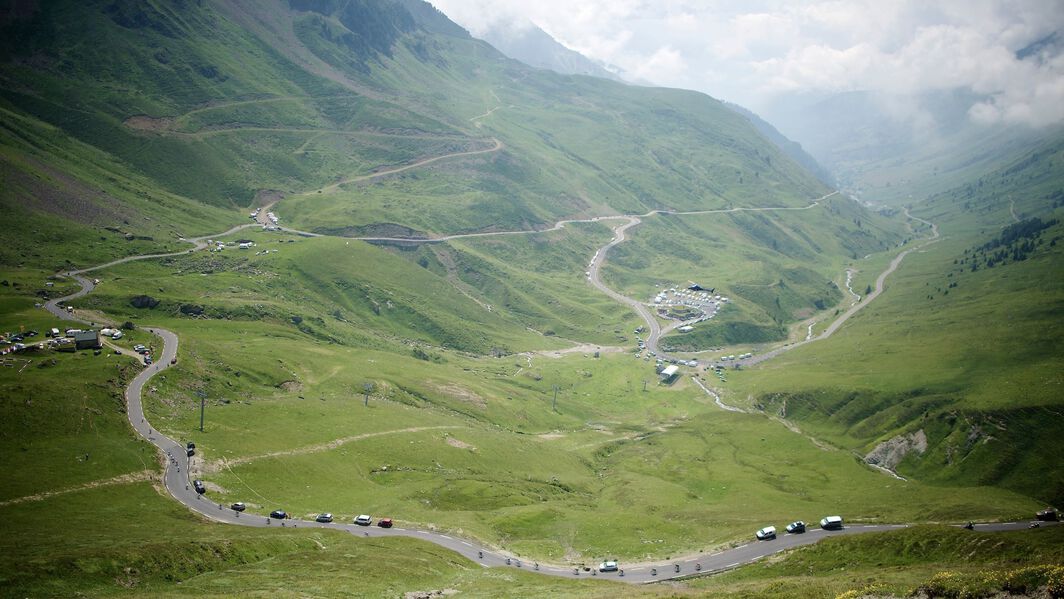
Tour de France 2023: Stage 6
Tarbes – cautarets-cambasque | 145km | mountain.
While two huge mountain passes lay ahead in the form of Col d’Aspin and Tourmalet, an early unclassified climb gives the possibility for a breakaway to leave the peloton. As the first of 4 summit finishes throughout the race, riders need to set aside some energy for the mighty Cautaret-Cambasque. At a distance of 16km and an average gradient of 5.4%, could we see the Yellow Jersey change shoulders for the first time?
Tour de France 2023: Stage 7
Mont-de-marsin – bordeaux | 170km | flat.
A welcome break from the mountains on Stage 7 gives the climbers chance to recoup. The course profile is an open invitation for the Green Jersey competition to light up once more. Bordeaux has a long history with the Tour de France and many of the world’s greatest sprinters have triumphed here.
Tour de France 2023: Stage 8
Libourne – limoges | 201km | hilly.
Another stage for the sprinters awaits in this long day out on the roads between Libourne and Limoges in the Gironde and Haute-Vienne departments of France respectively. That said, a short but sharp climb at the end of this stage will test the sprinters’ courage and power.
Tour de France 2023: Stage 9
Saint-léonard-de-noblat – puy de dôme | 184km | mountain.
The stage we’ve all been waiting for is here. Tour de France historians will remember the famous duel between Jacques Antequil and Raymond Poulidor (Mathieu van der Poel’s grandfather) on the slopes of the Puy De Dôme back in 1964. Who will battle it out to the summit of the majestic mountain in 2023? At 13.3km and an average gradient of 7.7%, there’ll be a worthy stage winner at the peak.
We welcome the tribute to Poupou. Our team is already looking forward to the summer of 2023. Philip Roodhooft - Alpecin-Deceuninck
Tour de France 2023: Stage 10
Vulcania – issoire | 167km | hilly.
The race has never before started within the boundaries of the Volcanic Park (Parc naturel régional des Volcans d'Auvergne), so this will be a real highlight for riders and spectators alike. The terrain rarely lets up leaving on the strongest riders at the front of the day’s stage before heading into Issoire.
Tour de France 2023: Stage 11
Clermont-ferrand – moulins | 180km | flat.
Yet another opportunity for the sprinters as the race leaves the Massif Central region. A long 1.3km straight will set the stage for a brilliant bunch sprint before the race turns its focus towards the Alps.
Tour de France 2023: Stage 12
Roanne – belleville-en-beaujolais | 169km | hilly.
Breakaway riders have a chance of victory on this alpine warmup stage. Five climbs will ensure the day is anything but dull ahead of the uphill finale just before the mountains begin once more.
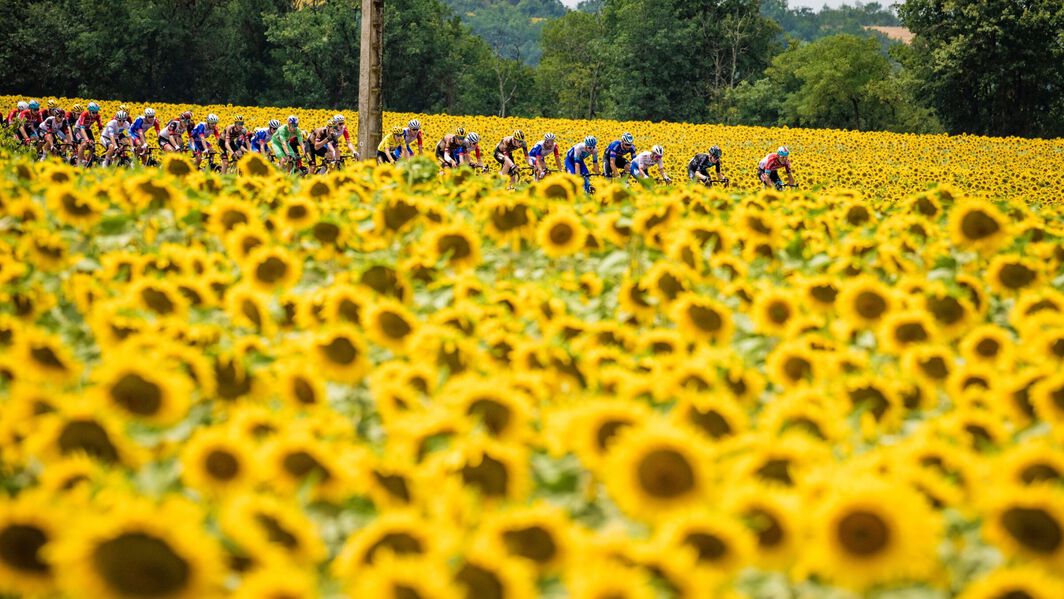
Tour de France 2023: Stage 13
Châtillon-sur-chalaronne – grand colombier | 138km | mountain.
Bastille Day presents the Grand Colombier! Though it’s only been featured in the Tour twice – once in 2012 and again in 2020 – the Grand Colombier is one of the most difficult mountain passes in France. When riders reach Culoz, they’ll have 17.4km of gruelling tarmac to endure at an average gradient of 7.1%. The stage winner will muster any last drops of energy to celebrate their victory at the summit.
Tour de France 2023: Stage 14
Annemasse – morzine | 152km | mountain.
The beauty of Lake Geneva provides a picturesque backdrop to this mountain stage. With 4200 metres of elevation to conquer, riders will be reaching for their easier gears on the slopes of all the climbs which include the Ramaz and Joux Plane.
The region will host this year’s Etape du Tour and the 2027 UCI Cycling World Championships.
Tour de France 2023: Stage 15
Les gets – saint-gervais mont blanc | 180km | mountain.
As the home of the 2022 UCI Mountain Bike World Championships, Les Gets is no stranger to hosting cycling events. A huge day of climbing (4300m) will keep the King of the Mountains and General Classification classifications occupied, while the sprinters will be looking forward to the rest day the following day.
Tour de France 2023: Stage 16
Passy – combloux | 22km | itt.
An short but sharp individual time trial eases the peloton into the final week of the Tour de France 2023. The course profile favours time trialists with a penchant for climbing as they take on the Domancy climb. The current leader of the Yellow Jersey competition may use this stage as an opportunity to put seconds into his rivals.
Tour de France 2023: Stage 17
Saint-gervais mont blanc – courchevel | 166km | mountain.
The queen stage of the Tour de France 2023 is Stage 17. The Col de la Loze is the highest point of the race at 2304m while other nearby mountain passes mean the riders have over 5000m of elevation to endure. The winner will empty their tanks all the way up to the finish line, which happens to be on the local altiport’s 18% runway.
Tour de France 2023: Stage 18
Moûtiers – bourg-en-bresse | 186km | hilly.
It’s been 30 long years since the Tour last visited Moûtiers and with the race now heading out of the mountains, it’s time for the sprinters to get their legs ready. A final straight kilometre offers ample time for the Green Jersey contenders to line up for a bunch sprint.
Tour de France 2023: Stage 19
Moirans-en-montagne – poligny | 173km | flat.
A brief respite from the French hills and mountains means this stage will be a quiet day for the General Classification. Though this stage is set between the many lakes of the Jura, there’s very little climbing involved.
Tour de France 2023: Stage 20
Belfort – le markstein | 133km | mountains.
Just when the riders thought they’d turned their backs on the mountains, they find their tyres rolling along the steep inclines of the Vosges region. The Ballon d’Alsace is the first ascent on which the Yellow Jersey will need to mark his nearest rivals. Fans of the 2022 Tour de France Femmes avec Zwift will remember Movistar’s Annemiek van Vleuten winning on the final climb of this stage, Le Markstein. Who will follow in her footsteps for this year’s men’s race?
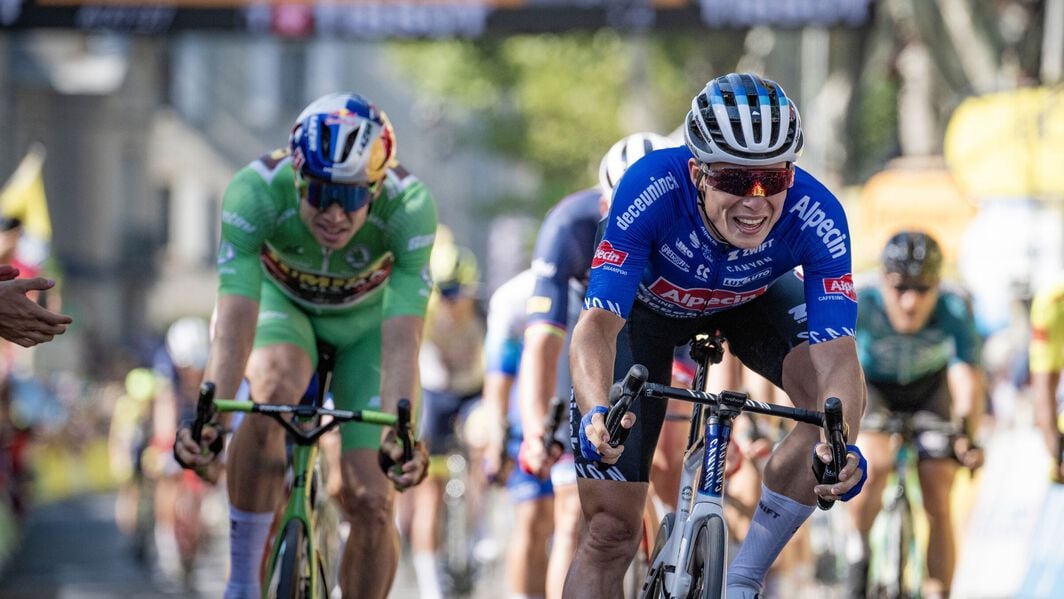
Tour de France 2023: Stage 21
Saint-quentin-en-yvelines – paris champs-élysées | 115km | flat.
If you’re into track cycling, you may have watched the 2022 UCI Track Cycling World Championships hosted at the velodrome in Saint-Quentin-en-Yvelines. As usual, the final stage of the Tour de France heads to the capital for a victory lap of Paris. We can almost hear the rumble of the peloton along the cobbles of the Champs-Élysées already.
What are the teams saying?
Shortly after the Tour de France route presentation concluded, team manager Philip Roodhooft of Alpecin-Deceuninck expressed his excitement for what lies ahead. “The start in the Basque Country, with a real connoisseur crowd will be a hit,” he said afterwards at the Palais des Congrès. “It will be a tough edition with many altimeters and a tough third week.” Asked which stage stood out for him, he continued, “Of course we are delighted with the 9th stage, which will start in Saint-Léonard-De-Noblat, the village that will forever be linked to Raymond Poulidor. We welcome that tribute to Poupou. Our team is already looking forward to the summer of 2023.”
The following broadcasters will be showing the Tour de France from start to finish.
- GCN+ (Europe and South-East Asia)
- NBC Sports (USA)
- SBS (Australia)
- Sky Sports (New Zealand)
Discover our Road Bikes
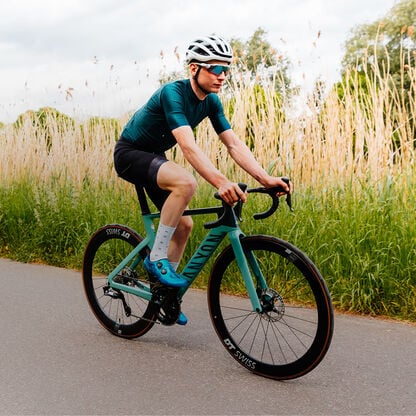
Did this article help?
Thank you for your feedback
Related Stories
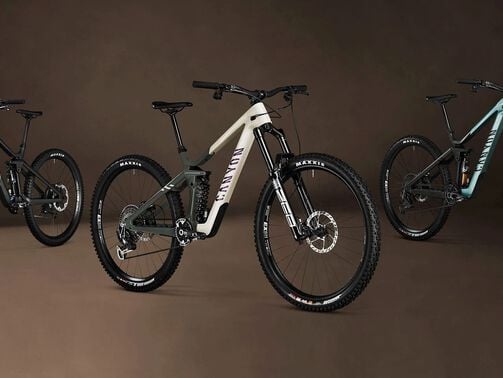
Tour de France heads to Andorra for queen stage
Stage 15 is the queen stage of the 2021 tour de france, the highest point reached on this year's race coming over the top of the port d’envalira enroute to a finish in andorra la vella..

The Tactics

The Contenders

Superman Lopez soars to victory on Tour's highest peak
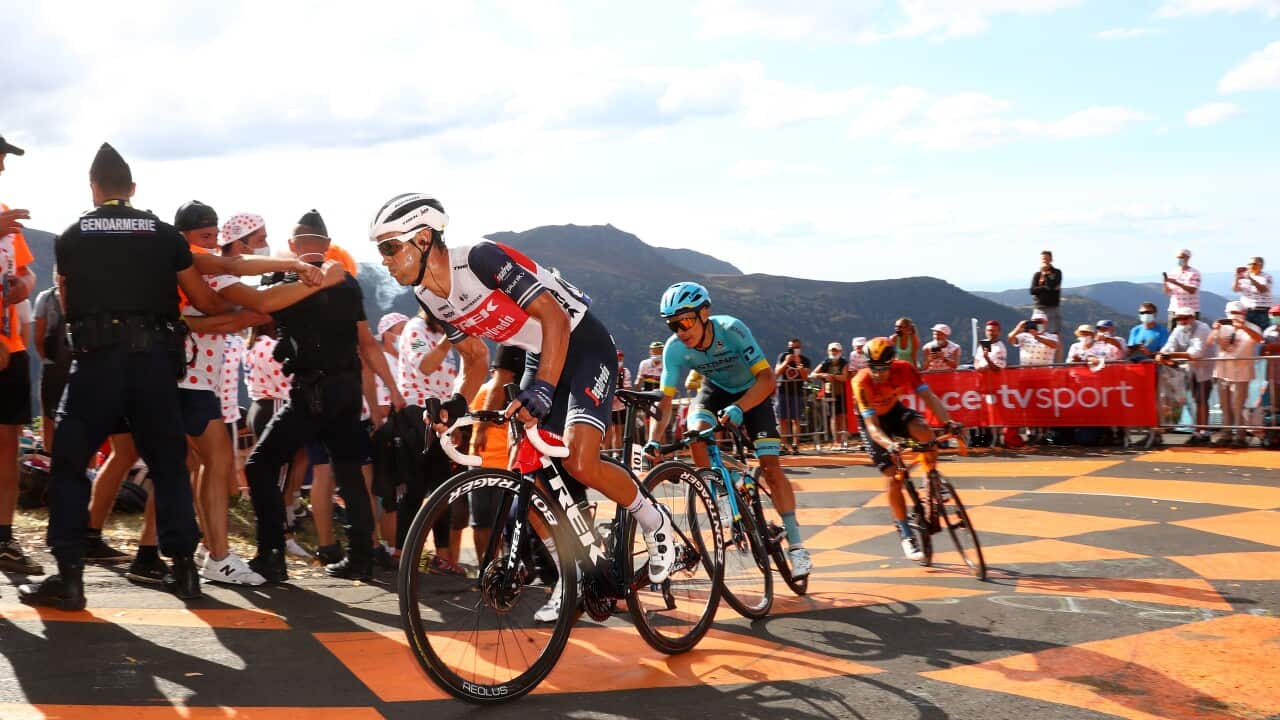
Altitude likely the key to tonight's queen stage
Have a story or comment? Contact Us
Share this with family and friends
Recommended for you

Kennedy stars in Round 3 of BMX World Cup

Superbike World Championship 2024 - Round 1, Australia

Day 5 - Full Replay - Australian Track National Championships 2024

Women's Weekly Football 2023/24 March 2-3 - Extended Highlights

Full Replay: Round 1, Phillip Island - Australian Superbikes Championship 2024

Stage 5 - Mini Recap - Paris-Nice 2024

Extended Highlights - 2024 Mountain Bike National Championships - Cross Country

Stage 7 - Mini Recap - Paris-Nice 2024
Sbs sport newsletter, sign up now for the latest sport news from australia and around the world direct to your inbox..
By subscribing, you agree to SBS’s terms of service and privacy policy including receiving email updates from SBS.
Tour de France 2023 route announcement – Everything you need to know
Mountainous profile, only 22km of time trialling and four summit finishes - all the details of the 110th Grande Boucle
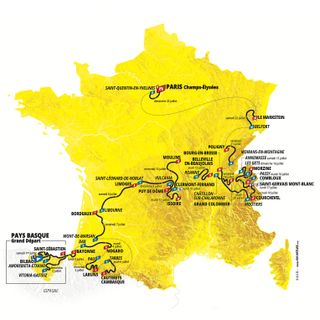
There were gasps from the audience in the Palais des Congrès in Paris when the men’s 2023 Tour de France route was unveiled and the severity of the course was confirmed.
The 110th edition of cycling’s biggest race includes just a single 22km hilly time trial in the Alps and mountain stages in all five of France’s mountain ranges on the road between the Grand Départ in the Basque Country and the finish in Paris.
Race director Christian Prudhomme openly admitted that the 2023 Tour route was for the climbers as he revealed the multiple mountain top finishes and steep roads.
The very limited amount of time trialling and preponderance of mountains no doubt pleased French riders Thibaut Pinot , David Gaudu and Romain Bardet. However, Remco Evenepoel, Primoz Roglič and Geraint Thomas are more likely to target the Giro d’Italia, which has three times the amount of time trialling and arguably fewer mountains.
How to watch the 2023 Tour de France route presentation – live streaming
Jonas Vingegaard: Defending the Tour de France is hard but I’m up for the challenge
2023 Tour de France to start in the Basque Country
Official information from race organiser ASO claimed the 3,404km route includes eight flat stages for the sprinters, four hilly stages suited to breakaways and eight mountain stages. Four of these include summit finishes: in the Pyrenees at Cauterets-Cambasque, on the legendary Puy de Dôme volcano in the Massif Central, on the Grand Colombier in the Jura and at Saint-Gervais Mont-Blanc in the Alps.
The other mountain stages are also extremely difficult, even if some are short and so extra intense.
Stage 14 to Morzine includes the mighty Col de Joux Plane and its testing descent to the finish. Stage 15 ends with the 11% ‘wall’ of Côte des Amerands and then the 7km 7.7% climb up to Saint-Gervais in view of Mont-Blanc.
Get The Leadout Newsletter
The latest race content, interviews, features, reviews and expert buying guides, direct to your inbox!
Stage 17 to Courchevel climbs the 2,304m-high Col de la Loze and then descends to finish on the altiport runway. Stage 20 is a final brutal multi-mountain stage in the Vosges between Belfort and Le Markstein ski resort.
The only time trial is on stage 16 in the Arve valley near Sallanches after the second rest day, but the 22km route between Passy and Combloux will test riders' bike handling skills and climbing as much as their time trialling. The stage includes the Côte de Domancy, where Bernard Hinault forged his 1980 Worlds victory, and which also featured as part of the final week time trial in the 2016 Tour.
There is no final weekend time trial before Paris and no team time trial around Tarbes in the first week, as was rumoured before the route was unveiled.
2022 Tour de France winner Jonas Vingegaard was not present at the route presentation but he no doubt liked what he saw during the final days of his holidays. He was arguably the best climber of the last two editions of the Tour and he appears to have plenty of opportunities to go on the attack on the steep ascents in 2023.
Two-time winner Tadej Pogačar was at the Palais des Congrès in Paris and he smiled as the route was unveiled, relishing next July’s challenge against Vingegaard, Jumbo-Visma, Ineos Grenadiers and anyone else.
2021 green jersey winner Mark Cavendish was not as happy. He has a number of opportunities to set a new record of 35 Tour de France stage victories but like all the fastmen, he will have to suffer through the mountains to make it to Paris for the final sprint.
Week one: From the Basque Country to the Puy du Dome
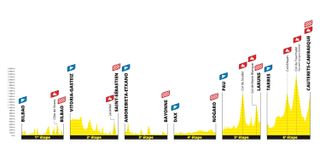
The 2023 Tour begins in the Basque Country, 31 years on from the 1992 Grand Départ in San Sebastian, when Miguel Indurain claimed the prologue time trial ahead of what would be the second of his five overall victories.
The three road stages will be a celebration of the Basque Country’s love of cycling, with huge crowds expected for the team presentation outside the Guggenheim museum in Bilbao.
There is no early time trial this year, and the Tour begins with a 182km road stage around Bilbao. The route heads out to the hilly Bay of Biscay coastline before returning to the city for a late, steep climb of the 10% Pike Bidea and the finish in the centre. The stage includes 3,300m of climbing and so Wout van Aert and an on-form Peter Sagan rather than the pure sprinters could be the favourites to win and take the first yellow jersey – as, indeed, could Julian Alaphilippe.
Stage 2 features more punchy terrain on a 209km route from Vitoria-Gasteiz to Donostia San Sebastián, with the Jaizkibel climb – well known from the Donostia San Sebastián Klasikoa – only 20km from the finish.
Stage 3 will start in Amorebieta-Etxano and heads 80km along the Basque Country coastline before reaching the French border. The 185km stage ends in Bayonne with the sprinters finally getting a clear chance of victory. The day after offers a chance of revenge for the defeated, with another fast finish expected on the Nogaro motor racing circuit.
The mountains begin on stage 5 with a 165km ride through the Pyrenees from Pau to Laruns with the Col de Soudet and Col de Marie Blanque featuring ahead of the run-in to the finish.
The race continues in the Pyrenees on stage 6 from Tarbes to Cauterets Cambasque. Rafał Majka was the last winner in Cauterets in 2015, after he distanced his breakaway companions on the Col du Tourmalet.
The stage climbs the Col d’Aspin and the 2115m-high Col du Tourmalet before a long descent to the valley and the 16km climb up to the finish. The average gradient is only 5.4% but the final three kilometres are over 10%.
Stage 7 takes the Tour away from the Pyrenees to Bordeaux with a start in Mont-de-Marsan, the adopted hometown of 1973 Tour winner Luis Ocaña. Bordeaux hasn't hosted a Tour stage finish since Cavendish won in 2010 and the pan-flat profile will surely offer him and others a chance of another sprint win.
The 201km stage 8 ride from Liborne to Limoges is a transition stage towards the Massif Central and is another sprint opportunity before the mountains return on stage 9 with the finish on the Puy de Dôme. The climb up and around the dormant volcano hasn't been used since 1988 but has a special place in Tour de France history, including the Poulidor-Anquetil duel in 1964 and the drama of when a spectator punched Eddy Merckx in 1975 to try to stop him winning yet again. The Puy de Dôme climb is 13.3km long at an average of 7.7% but the final four kilometres are above 11%.
Week two: Towards the high Alps for the single time trial

The riders enjoy a well-deserved first rest day in Clermont Ferrand before a hilly 167km stage between the Vulcania volcano park and Issoire. Stage 11 heads east from Clermont Ferrand to Moulins for another sprint finish if the peloton can control the breakaways.
It will be a similar scenario on stage 12 from Roanne to Belleville-en-Beaujolais, with little time for wine tasting along the route and a hilly finale perhaps playing a major role in the fight for the green jersey.
The mountains return on stage 13 in the Ain region and then just keep coming. The first is a short but intense 138km ride from Chatillon-sur-Charlaronne to the Grand Colombier summit finish. A stage first finished here in 2020 when Pogačar duelled with Roglič.
The riders climb up to the Hauteville-Lompnes plateau and then descend to face the 17.4km haul up to the Grand Colombier finish at an average gradient of 7.1%. A French winner would be fitting on Bastille Day.
The high mountains continue on stage 14 and into the second weekend, with 4,200 metres of climbing in just 152km between Annemasse and Morzine. The day includes six climbs, including the nasty Col de la Ramaz before the Col du Joux Plane. The descent off the mountain to Morzine will also be important and surely only increase any time gap achieved at the summit.
A demanding weekend ends with stage 15 from Les Gets to Saint-Gervais Mont Blanc, which should inspire a GC battle. The ride through the Haute-Savoie includes the Col de la Forclaz, the Croix Fry and the Col des Aravis. The climb to the finish kicks off with the 11% Côte des Amerands wall and then the 7km climb up to Saint-Gervais gets steeper and steeper, with ASO suggesting some sections touch 17%.
Week three: The only time trial and more mountains before Paris

The riders will enjoy the second rest in Sallanches but will be full of dread for what they face in the final week.
The only time trial of the Tour is on stage 16 and covers just 22km in the Arve valley south of Sallanches. It will be a chance to recover for the domestiques and sprinters but a huge day for the overall contenders.
The time trial starts in Passy on the north side of the Arve valley and then crosses to the south to climb the Côte de Domancy and up to the finish in the village of Combloux.
The climb is only three kilometres long but has an average gradient of 8.5% and a section at 16%. Some riders might be tempted to switch from a time trial bike to a climbing bike, but the time benefit is probably not worth the risks involved.
Time gaps might not be huge, but the stage will shake-up the overall classification and set the narrative for the final week.
The high mountains continue on stage 17 from Saint-Gervais Mont Blanc to Courchevel. The 166km stage includes three categorised Alpine passes and it tackles the Col de la Loze before a short descent to Courchevel. The climbing isn’t quite over, however, with an 18% ramp up to the finish line at the altiport runway.
It is arguably the queen stage of the 2023 Tour de France, with the 2,304m climb up the Col de la Loze the highest point of the whole race. The Loze was only climbed once before at the Tour, in 2020, after the narrow bike path to the summit was asphalted. On that occasion, Roglič distanced Pogačar, with Miguel Ángel López winning the stage. We can expect a similar showdown next July.
The Tour leaves the Alps on stage 18 from Moutiers to Bourg-en-Bresse, giving a breakaway a chance of glory if they can break the will of the sprinters and their teams. Stage 19 from Moirans-en-Montagne to Poligny is a hillier transition stage through the Jura and so north towards the Vosges and the French-Swiss border.
There is no time trial on the final Saturday of the race, and instead ASO have created what L’Équipe has described as a Liège-Bastogne-Liège as they try to inspire aggressive racing without climbing high into the mountains.
The 133km leg runs through the Vosges between Belfort and Le Markstein ski resort. It starts with the Ballon d’Alsace, includes five mid-stage climbs and then ends with 8.1% Petit Ballon and then the 8.4% Col du Platzerwasel.
“On a constant climb the riders can calculate their watts and control their effort. We are looking for ways to blow up the peloton,” technical director Thierry Gouvenou told L’Équipe , explaining his decision to create such a hard final stage.
Le Markstein hosted the penultimate stage of the 2022 Tour de France Femmes, with Annemiek van Vleuten taking the yellow jersey with an attack. The men will be hoping to repeat her exploit next summer to seal overall victory.
The Tour peloton will then transfer from the Vosges to Paris on the morning of the final stage on July 23. The final 115km parade stage starts at the national velodrome of Saint-Quentin-en-Yvelines, which will host the track racing at the 2024 Paris Olympics.

Thank you for reading 5 articles in the past 30 days*
Join now for unlimited access
Enjoy your first month for just £1 / $1 / €1
*Read any 5 articles for free in each 30-day period, this automatically resets
After your trial you will be billed £4.99 $7.99 €5.99 per month, cancel anytime. Or sign up for one year for just £49 $79 €59

Try your first month for just £1 / $1 / €1

Stephen is the most experienced member of the Cyclingnews team, having reported on professional cycling since 1994. He has been Head of News at Cyclingnews since 2022, before which he held the position of European editor since 2012 and previously worked for Reuters , Shift Active Media , and CyclingWeekly , among other publications.
'You can never count us out' - Matteo Jorgenson warns against underestimating Visma in Tour of Flanders
Former Tour of Flanders winner Asgreen predicts 'new dynamic' on Sunday
High stakes all around: Why the 2024 Itzulia Basque Country matters to Vingegaard, Roglic and Evenepoel
Most Popular
By Stephen Farrand March 29, 2024
By Jackie Tyson March 28, 2024
By Dani Ostanek March 28, 2024
By Tom Wieckowski March 28, 2024
By James Moultrie March 28, 2024
By Simone Giuliani March 28, 2024

IMAGES
COMMENTS
Tour de France - July 19. The queen high mountain stage of the 2023 Tour de France features 5000 meters of elevation gain and four very tough climbs during the 166 km stage: Col des Saisles (13.3 km at 5.3%), Cornet de Roselend (19.9 km at 6%, Cöte de Longefoy (6.6 km at 7.6%) and the terrible final climb to the Col de la Loze (28.4 km at 6%).
Highlights from stage 17 of the Tour de France 2023. A brutal day in the Alps with over 5000m of elevation gain across 165.7km of racing. The Col des Saisies...
July 21: Monaco - Nice, 34km (ITT) The profile for stage 21 of the 2024 Tour de France. For the first time in the history of the Tour de France, the race will finish away from Paris, and for the first time since 1989, we'll have a competitive final day. Those memories from 35 years ago will only whet the appetite for this 35km time trial ...
The Queen stage of the Tour de France Femmes 2023 will likely determine the winner of the yellow jersey. Race Home. Stages . Stage 1. 123.8km | Clermont-Ferrand - Clermont-Ferrand
Felix Gall won a brutal Queen Stage, while any faint hopes Tadej Pogacar might have had of catching Jonas Vingegaard were completely obliterated. ... — Tour de France™ (@LeTour) July 19, 2023.
| Felix Gall conquers Tour de France Queen stage as Tadej Pogačar cracks. On a day that promised big GC shake-ups, stage 17 certainly delivered as Felix Gall (AG2R Citroën) took a stage victory that pushed him up the overall standings, whilst behind Jonas Vingegaard (Jumbo-Visma) added more than five minutes to his yellow jersey lead.. The big moment of the day came early on the final climb ...
The 2022 Tour features four summit finishes in the Alps and Pyrenees, each of which could have a claim of being the queen stage of the race. The first visit to Hautacam since 2014, the final ...
Preview.Stage 17 of the Tour de France is by many called the queen stage, a brutal stage in the Alps with the climax in the climb to Col de la Loze. Jonas Vingegaard is in yellow and has the task to defend the yellow jersey from Tadej Pogacar as the gap has grown in the time-trial.. Stage 17 of the Tour de France is perhaps the queen stage of the race. A brutal day in the mountains featuring ...
Here's how it works. Tour de France 2023: Six key stages you need to watch in the men's race next July. Six stages where drama in the fight for the yellow jersey could unfold in the 110th ...
Tour de France 2023: Gall wins Queen Stage, Vingegaard cements GC lead. foto: Cor VosFelix Gall attacks from the breakaway on the brutal Col de la Loze, while Tadej Pogacar loses contact in the GC group. The Austrian solos to victory and Jonas Vingegaard extends his lead on GC with a few minutes. (Slideshow route/profile)
This Year's Queen Stage Delivers on the drama. Stage 17 of the Tour de France 2023 featured over 5400 m of climbing, the highest point in this year's Tour, nearly 166 km of distance, and four categorized climbs, easily making it this year's queen stage. In fact, it would have been the queen stage (the name given to the Tour's hardest ...
The double dose of Mont Ventoux. Race facts will determine whether or not this is the queen stage. The double ascent of the Mont Ventoux is certainly one of the highlights of the 108th Tour de France. It's unprecedented. Gordes is a touristic gem on the route. Col de Liguière (cat. 1) is an opportunity to fire up the race.
Stage 17 to Courchevel is arguably the queen stage, ... 2023 Tour de France stage summary; Stage preview Date Start Finish Distance Type; Stage 1: Jul 1, 2023: Bilbao: Bilbao: 182 km:
Stage 17 | 19 July | Saint-Gervais Mont Blanc - Courchevel | 165.7 km. The queen stage of the 2023 edition leads on the way from Saint Gervais-Mont Blanc to Courchevel over the passes Col des Saisies, Cormet de Roselend, Côte de Longefoy as well as over the roof of the Tour - the 2304 metre high Col de la Loze.
She pedaled to victory in stage five of the 2020 virtual Tour de France, the so-called "queen stage." The toughest stage in a multiday road race. The next day, Moolman-Pasio and her husband ...
"Stage 17 - Wednesday 22 July [2009]: Bourg-Saint-Maurice-Le Grand Bornand, 169.5km Today was what's known in cycling terms as the 'Queen Stage' of the Tour de France.
An Olympic mountain bike champion AND Queen Stage winner of the 2022 Tour de France. Yes, that's right. What a ride on Alpe d'Huez and Bastille Day. Amazing stuff from the Brit.
In stage racing they always have a stage called the queens stage. Where did the expression come from? ... Marco Pantani's overall win in the 1998 Tour de France was an amazing spectacle by a pure climber; which he primary accomplished on the Queen Stage over the Galibier, roundly defeating Jan Ullrich, who would generally have been seen as the ...
How it unfolded. Stage 17 of the Tour de France would see the 155 remaining riders take on the queen stage of the race, passing four classified climbs, including two first-category mountains plus ...
Stage 17 of the Tour de France is perhaps the queen stage of the race. A brutal day in the mountains featuring 5400 meters of climbing. The start is rather flat, but features in it's early parts the Col des Saisies (13.3Km; 5.3%). It will take a few kilometers for the riders to reach it, but the breakaway certainly will go up the road here.
The queen stage of the Tour de France 2023 is Stage 17. The Col de la Loze is the highest point of the race at 2304m while other nearby mountain passes mean the riders have over 5000m of elevation to endure. The winner will empty their tanks all the way up to the finish line, which happens to be on the local altiport's 18% runway. ...
Stage 15 is the queen stage of the 2021 Tour de France, the highest point reached on this year's race coming over the top of the Port d'Envalira enroute to a finish in Andorra La Vella.
It is arguably the queen stage of the 2023 Tour de France, with the 2,304m climb up the Col de la Loze the highest point of the whole race. The Loze was only climbed once before at the Tour, in ...